Feasibility Test of Business Projects of Petronas in Oil and Gas Sector in Malaysia
VerifiedAdded on 2023/06/15
|63
|18207
|155
AI Summary
This business plan analyses the feasibility of Petronas' business projects in the oil and gas sector in Malaysia, competitive rivalry, success proximity, financial analysis, and attracting investors and customers.
Contribute Materials
Your contribution can guide someone’s learning journey. Share your
documents today.
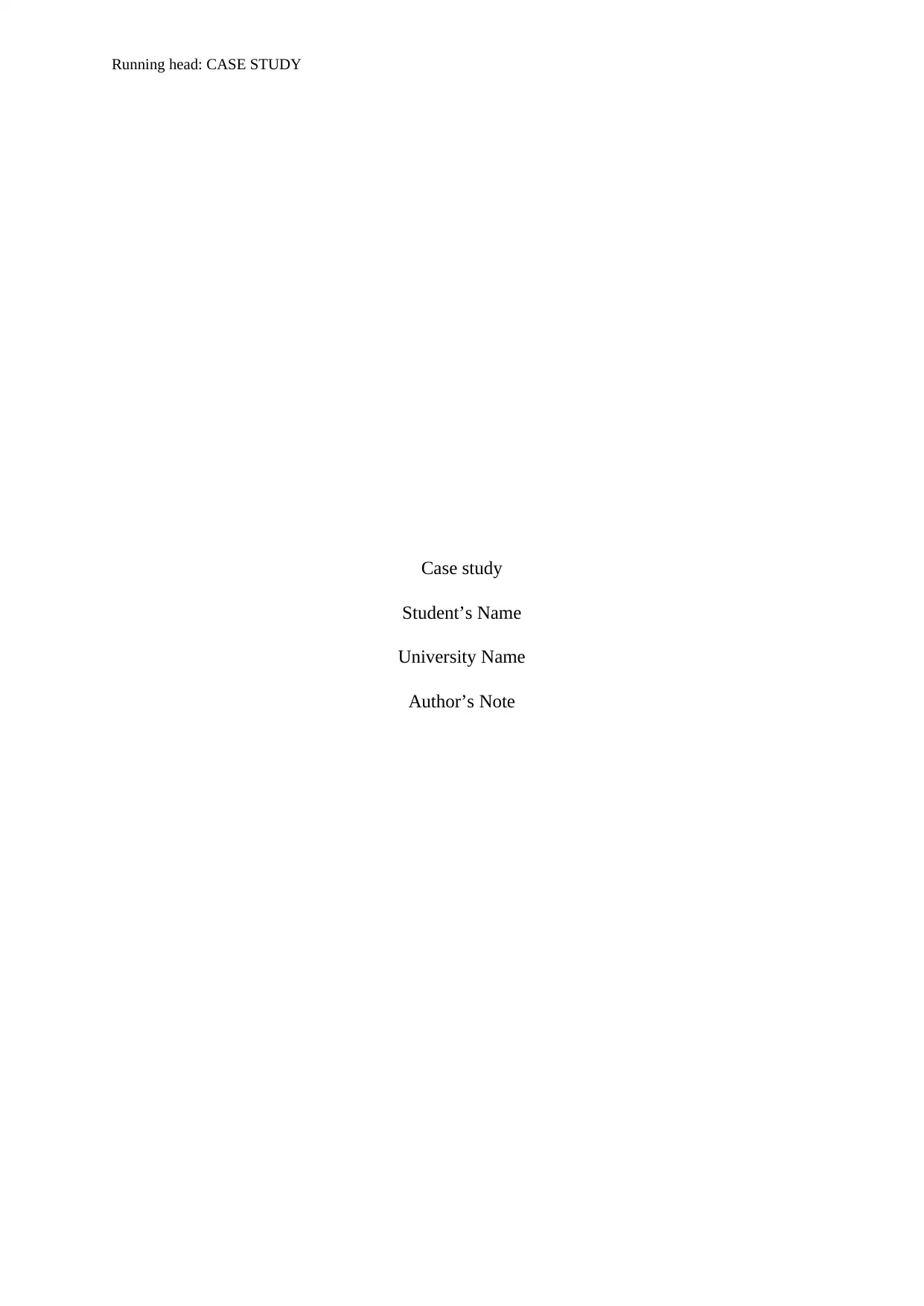
Running head: CASE STUDY
Case study
Student’s Name
University Name
Author’s Note
Case study
Student’s Name
University Name
Author’s Note
Secure Best Marks with AI Grader
Need help grading? Try our AI Grader for instant feedback on your assignments.
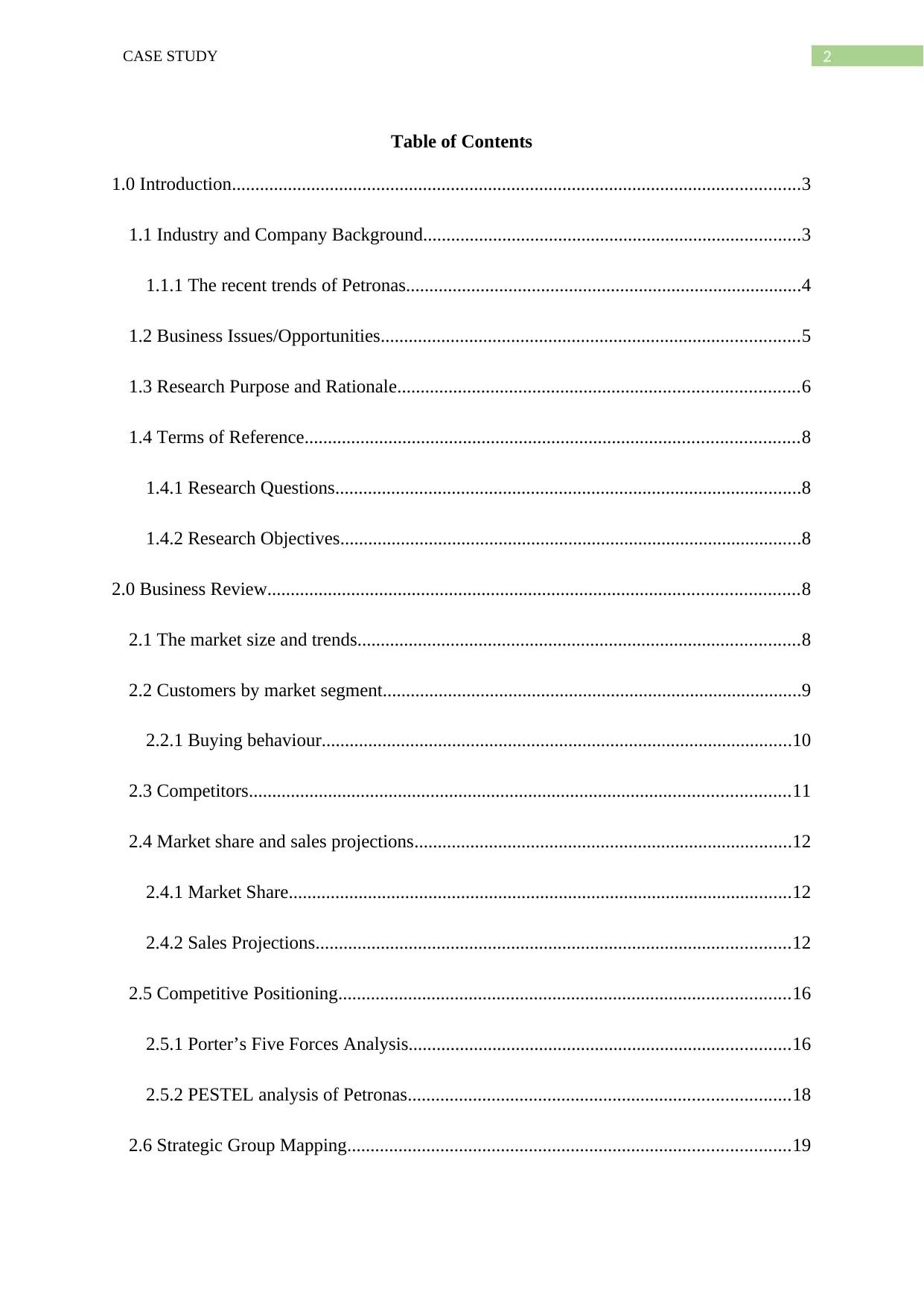
2CASE STUDY
Table of Contents
1.0 Introduction..........................................................................................................................3
1.1 Industry and Company Background.................................................................................3
1.1.1 The recent trends of Petronas.....................................................................................4
1.2 Business Issues/Opportunities..........................................................................................5
1.3 Research Purpose and Rationale......................................................................................6
1.4 Terms of Reference..........................................................................................................8
1.4.1 Research Questions....................................................................................................8
1.4.2 Research Objectives...................................................................................................8
2.0 Business Review..................................................................................................................8
2.1 The market size and trends...............................................................................................8
2.2 Customers by market segment..........................................................................................9
2.2.1 Buying behaviour.....................................................................................................10
2.3 Competitors....................................................................................................................11
2.4 Market share and sales projections.................................................................................12
2.4.1 Market Share............................................................................................................12
2.4.2 Sales Projections......................................................................................................12
2.5 Competitive Positioning.................................................................................................16
2.5.1 Porter’s Five Forces Analysis..................................................................................16
2.5.2 PESTEL analysis of Petronas..................................................................................18
2.6 Strategic Group Mapping...............................................................................................19
Table of Contents
1.0 Introduction..........................................................................................................................3
1.1 Industry and Company Background.................................................................................3
1.1.1 The recent trends of Petronas.....................................................................................4
1.2 Business Issues/Opportunities..........................................................................................5
1.3 Research Purpose and Rationale......................................................................................6
1.4 Terms of Reference..........................................................................................................8
1.4.1 Research Questions....................................................................................................8
1.4.2 Research Objectives...................................................................................................8
2.0 Business Review..................................................................................................................8
2.1 The market size and trends...............................................................................................8
2.2 Customers by market segment..........................................................................................9
2.2.1 Buying behaviour.....................................................................................................10
2.3 Competitors....................................................................................................................11
2.4 Market share and sales projections.................................................................................12
2.4.1 Market Share............................................................................................................12
2.4.2 Sales Projections......................................................................................................12
2.5 Competitive Positioning.................................................................................................16
2.5.1 Porter’s Five Forces Analysis..................................................................................16
2.5.2 PESTEL analysis of Petronas..................................................................................18
2.6 Strategic Group Mapping...............................................................................................19
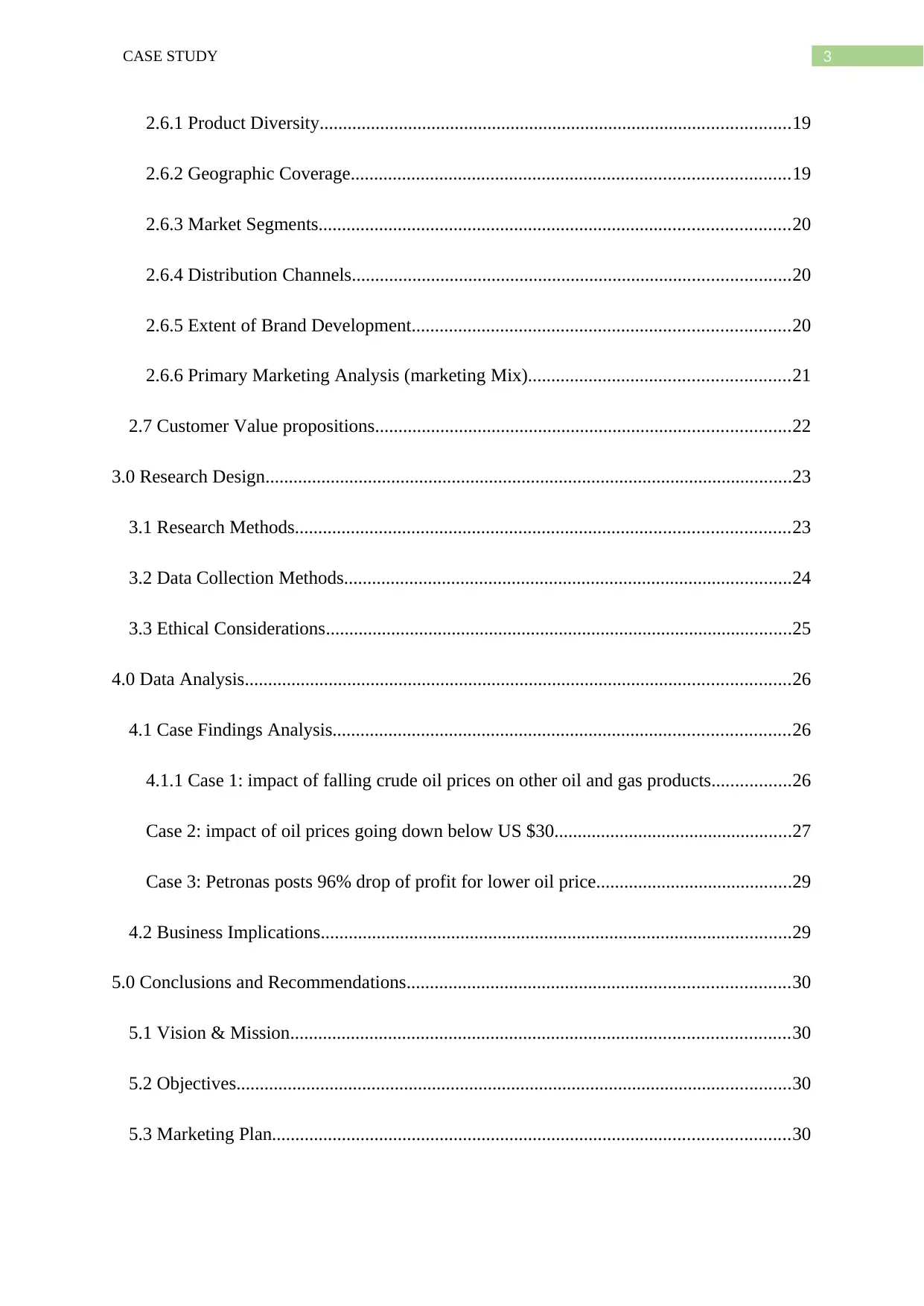
3CASE STUDY
2.6.1 Product Diversity.....................................................................................................19
2.6.2 Geographic Coverage..............................................................................................19
2.6.3 Market Segments.....................................................................................................20
2.6.4 Distribution Channels..............................................................................................20
2.6.5 Extent of Brand Development.................................................................................20
2.6.6 Primary Marketing Analysis (marketing Mix)........................................................21
2.7 Customer Value propositions.........................................................................................22
3.0 Research Design.................................................................................................................23
3.1 Research Methods..........................................................................................................23
3.2 Data Collection Methods................................................................................................24
3.3 Ethical Considerations....................................................................................................25
4.0 Data Analysis.....................................................................................................................26
4.1 Case Findings Analysis..................................................................................................26
4.1.1 Case 1: impact of falling crude oil prices on other oil and gas products.................26
Case 2: impact of oil prices going down below US $30...................................................27
Case 3: Petronas posts 96% drop of profit for lower oil price..........................................29
4.2 Business Implications.....................................................................................................29
5.0 Conclusions and Recommendations..................................................................................30
5.1 Vision & Mission...........................................................................................................30
5.2 Objectives.......................................................................................................................30
5.3 Marketing Plan...............................................................................................................30
2.6.1 Product Diversity.....................................................................................................19
2.6.2 Geographic Coverage..............................................................................................19
2.6.3 Market Segments.....................................................................................................20
2.6.4 Distribution Channels..............................................................................................20
2.6.5 Extent of Brand Development.................................................................................20
2.6.6 Primary Marketing Analysis (marketing Mix)........................................................21
2.7 Customer Value propositions.........................................................................................22
3.0 Research Design.................................................................................................................23
3.1 Research Methods..........................................................................................................23
3.2 Data Collection Methods................................................................................................24
3.3 Ethical Considerations....................................................................................................25
4.0 Data Analysis.....................................................................................................................26
4.1 Case Findings Analysis..................................................................................................26
4.1.1 Case 1: impact of falling crude oil prices on other oil and gas products.................26
Case 2: impact of oil prices going down below US $30...................................................27
Case 3: Petronas posts 96% drop of profit for lower oil price..........................................29
4.2 Business Implications.....................................................................................................29
5.0 Conclusions and Recommendations..................................................................................30
5.1 Vision & Mission...........................................................................................................30
5.2 Objectives.......................................................................................................................30
5.3 Marketing Plan...............................................................................................................30
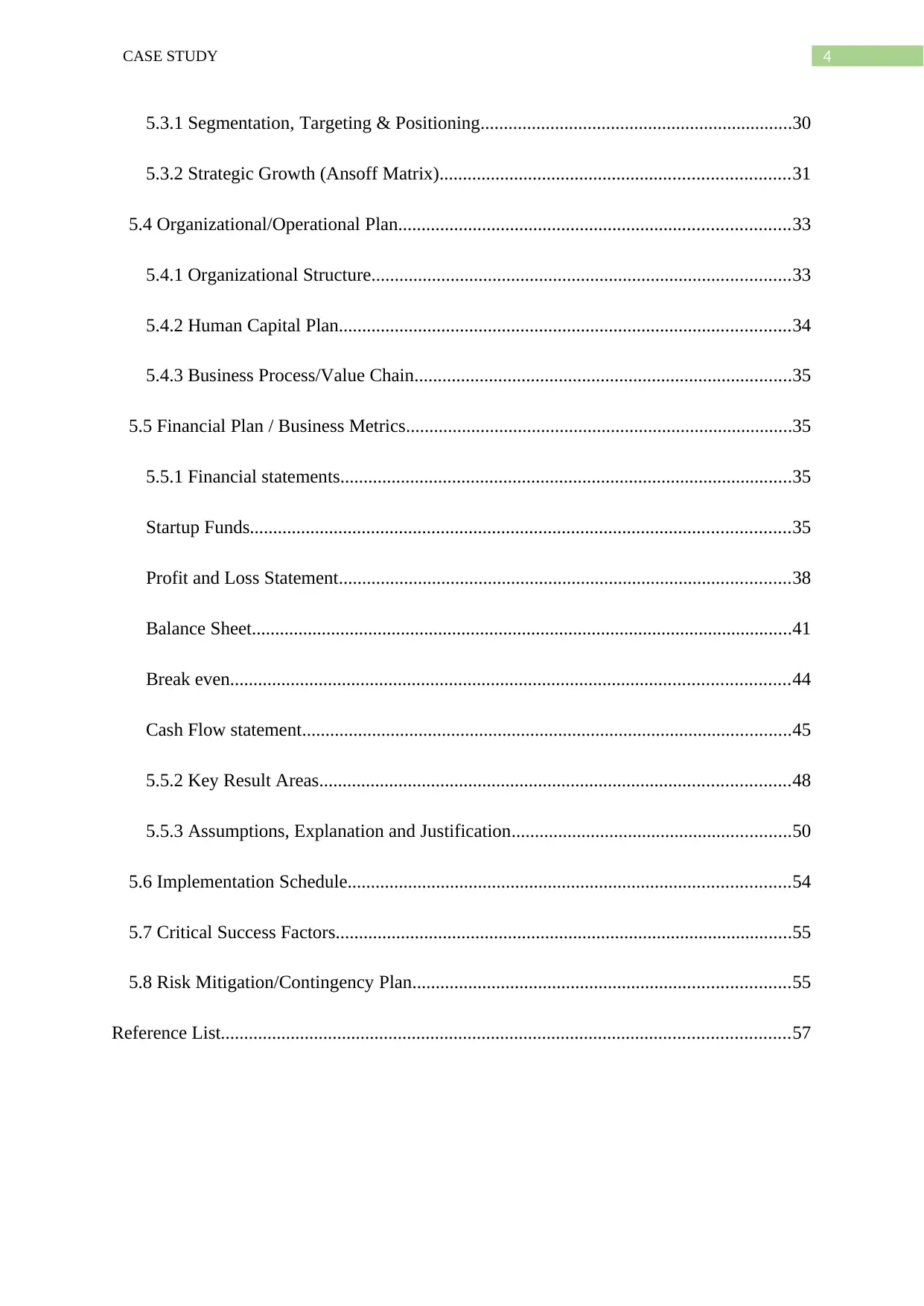
4CASE STUDY
5.3.1 Segmentation, Targeting & Positioning...................................................................30
5.3.2 Strategic Growth (Ansoff Matrix)...........................................................................31
5.4 Organizational/Operational Plan....................................................................................33
5.4.1 Organizational Structure..........................................................................................33
5.4.2 Human Capital Plan.................................................................................................34
5.4.3 Business Process/Value Chain.................................................................................35
5.5 Financial Plan / Business Metrics...................................................................................35
5.5.1 Financial statements.................................................................................................35
Startup Funds....................................................................................................................35
Profit and Loss Statement.................................................................................................38
Balance Sheet....................................................................................................................41
Break even........................................................................................................................44
Cash Flow statement.........................................................................................................45
5.5.2 Key Result Areas.....................................................................................................48
5.5.3 Assumptions, Explanation and Justification............................................................50
5.6 Implementation Schedule...............................................................................................54
5.7 Critical Success Factors..................................................................................................55
5.8 Risk Mitigation/Contingency Plan.................................................................................55
Reference List..........................................................................................................................57
5.3.1 Segmentation, Targeting & Positioning...................................................................30
5.3.2 Strategic Growth (Ansoff Matrix)...........................................................................31
5.4 Organizational/Operational Plan....................................................................................33
5.4.1 Organizational Structure..........................................................................................33
5.4.2 Human Capital Plan.................................................................................................34
5.4.3 Business Process/Value Chain.................................................................................35
5.5 Financial Plan / Business Metrics...................................................................................35
5.5.1 Financial statements.................................................................................................35
Startup Funds....................................................................................................................35
Profit and Loss Statement.................................................................................................38
Balance Sheet....................................................................................................................41
Break even........................................................................................................................44
Cash Flow statement.........................................................................................................45
5.5.2 Key Result Areas.....................................................................................................48
5.5.3 Assumptions, Explanation and Justification............................................................50
5.6 Implementation Schedule...............................................................................................54
5.7 Critical Success Factors..................................................................................................55
5.8 Risk Mitigation/Contingency Plan.................................................................................55
Reference List..........................................................................................................................57
Secure Best Marks with AI Grader
Need help grading? Try our AI Grader for instant feedback on your assignments.
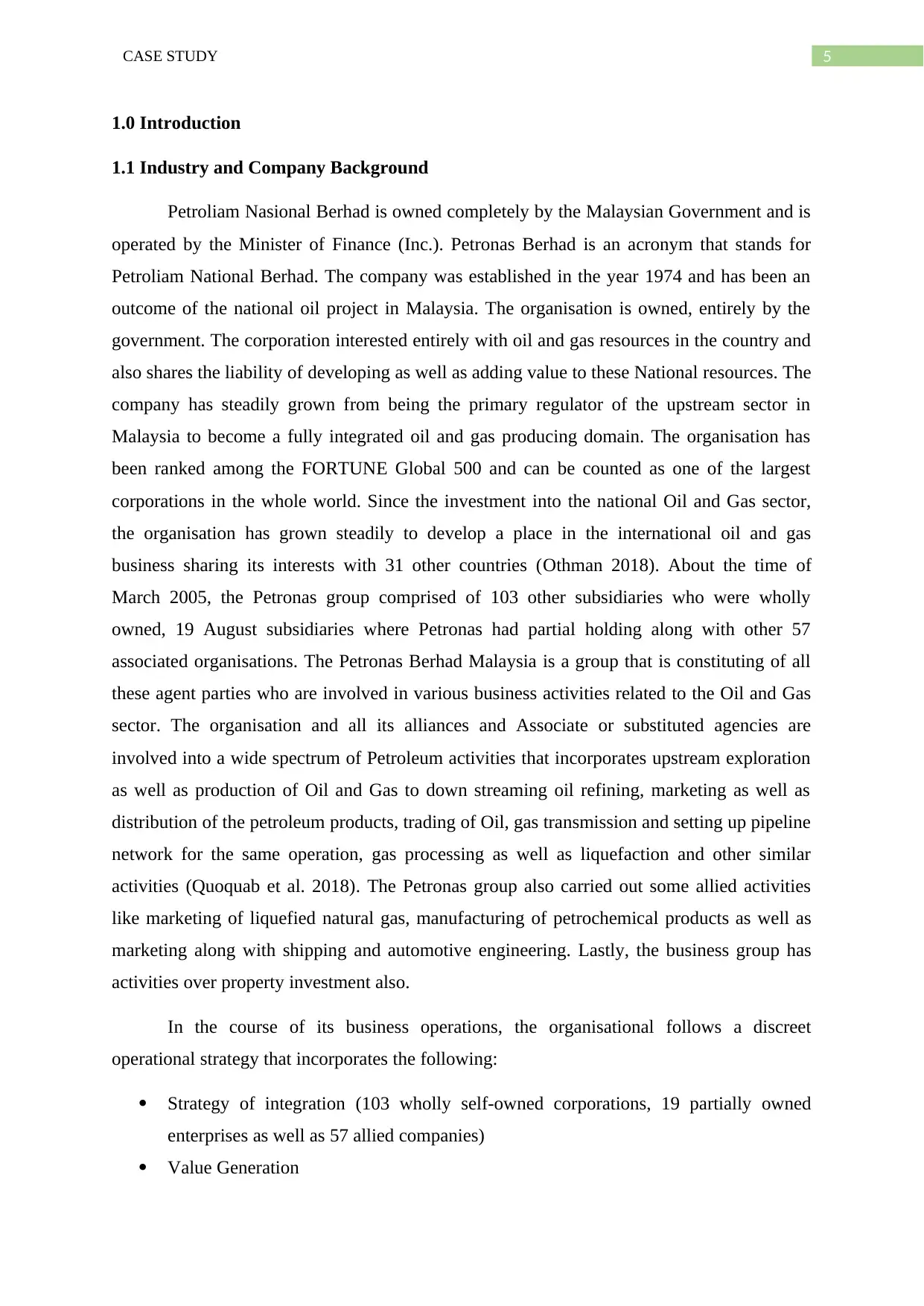
5CASE STUDY
1.0 Introduction
1.1 Industry and Company Background
Petroliam Nasional Berhad is owned completely by the Malaysian Government and is
operated by the Minister of Finance (Inc.). Petronas Berhad is an acronym that stands for
Petroliam National Berhad. The company was established in the year 1974 and has been an
outcome of the national oil project in Malaysia. The organisation is owned, entirely by the
government. The corporation interested entirely with oil and gas resources in the country and
also shares the liability of developing as well as adding value to these National resources. The
company has steadily grown from being the primary regulator of the upstream sector in
Malaysia to become a fully integrated oil and gas producing domain. The organisation has
been ranked among the FORTUNE Global 500 and can be counted as one of the largest
corporations in the whole world. Since the investment into the national Oil and Gas sector,
the organisation has grown steadily to develop a place in the international oil and gas
business sharing its interests with 31 other countries (Othman 2018). About the time of
March 2005, the Petronas group comprised of 103 other subsidiaries who were wholly
owned, 19 August subsidiaries where Petronas had partial holding along with other 57
associated organisations. The Petronas Berhad Malaysia is a group that is constituting of all
these agent parties who are involved in various business activities related to the Oil and Gas
sector. The organisation and all its alliances and Associate or substituted agencies are
involved into a wide spectrum of Petroleum activities that incorporates upstream exploration
as well as production of Oil and Gas to down streaming oil refining, marketing as well as
distribution of the petroleum products, trading of Oil, gas transmission and setting up pipeline
network for the same operation, gas processing as well as liquefaction and other similar
activities (Quoquab et al. 2018). The Petronas group also carried out some allied activities
like marketing of liquefied natural gas, manufacturing of petrochemical products as well as
marketing along with shipping and automotive engineering. Lastly, the business group has
activities over property investment also.
In the course of its business operations, the organisational follows a discreet
operational strategy that incorporates the following:
Strategy of integration (103 wholly self-owned corporations, 19 partially owned
enterprises as well as 57 allied companies)
Value Generation
1.0 Introduction
1.1 Industry and Company Background
Petroliam Nasional Berhad is owned completely by the Malaysian Government and is
operated by the Minister of Finance (Inc.). Petronas Berhad is an acronym that stands for
Petroliam National Berhad. The company was established in the year 1974 and has been an
outcome of the national oil project in Malaysia. The organisation is owned, entirely by the
government. The corporation interested entirely with oil and gas resources in the country and
also shares the liability of developing as well as adding value to these National resources. The
company has steadily grown from being the primary regulator of the upstream sector in
Malaysia to become a fully integrated oil and gas producing domain. The organisation has
been ranked among the FORTUNE Global 500 and can be counted as one of the largest
corporations in the whole world. Since the investment into the national Oil and Gas sector,
the organisation has grown steadily to develop a place in the international oil and gas
business sharing its interests with 31 other countries (Othman 2018). About the time of
March 2005, the Petronas group comprised of 103 other subsidiaries who were wholly
owned, 19 August subsidiaries where Petronas had partial holding along with other 57
associated organisations. The Petronas Berhad Malaysia is a group that is constituting of all
these agent parties who are involved in various business activities related to the Oil and Gas
sector. The organisation and all its alliances and Associate or substituted agencies are
involved into a wide spectrum of Petroleum activities that incorporates upstream exploration
as well as production of Oil and Gas to down streaming oil refining, marketing as well as
distribution of the petroleum products, trading of Oil, gas transmission and setting up pipeline
network for the same operation, gas processing as well as liquefaction and other similar
activities (Quoquab et al. 2018). The Petronas group also carried out some allied activities
like marketing of liquefied natural gas, manufacturing of petrochemical products as well as
marketing along with shipping and automotive engineering. Lastly, the business group has
activities over property investment also.
In the course of its business operations, the organisational follows a discreet
operational strategy that incorporates the following:
Strategy of integration (103 wholly self-owned corporations, 19 partially owned
enterprises as well as 57 allied companies)
Value Generation
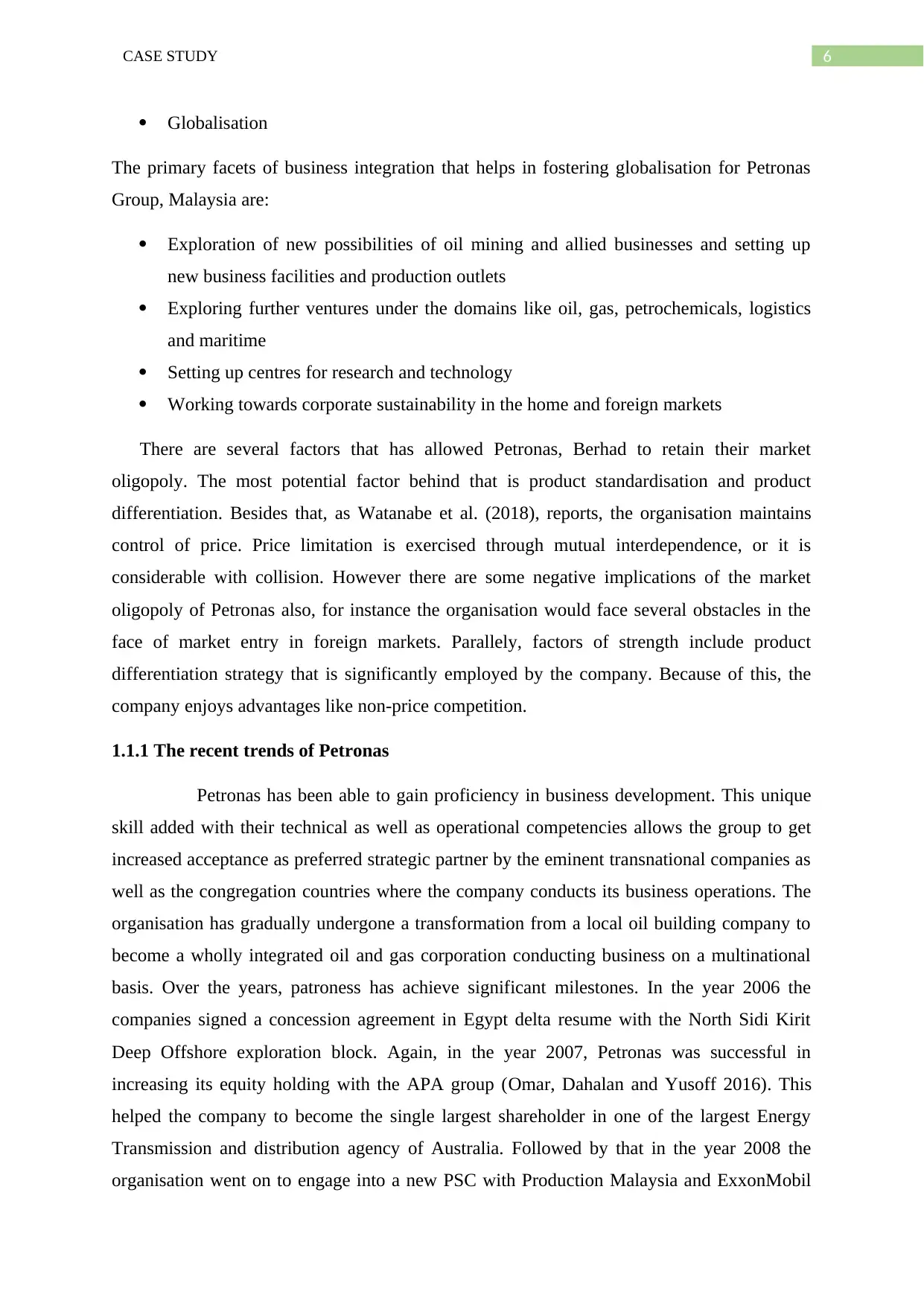
6CASE STUDY
Globalisation
The primary facets of business integration that helps in fostering globalisation for Petronas
Group, Malaysia are:
Exploration of new possibilities of oil mining and allied businesses and setting up
new business facilities and production outlets
Exploring further ventures under the domains like oil, gas, petrochemicals, logistics
and maritime
Setting up centres for research and technology
Working towards corporate sustainability in the home and foreign markets
There are several factors that has allowed Petronas, Berhad to retain their market
oligopoly. The most potential factor behind that is product standardisation and product
differentiation. Besides that, as Watanabe et al. (2018), reports, the organisation maintains
control of price. Price limitation is exercised through mutual interdependence, or it is
considerable with collision. However there are some negative implications of the market
oligopoly of Petronas also, for instance the organisation would face several obstacles in the
face of market entry in foreign markets. Parallely, factors of strength include product
differentiation strategy that is significantly employed by the company. Because of this, the
company enjoys advantages like non-price competition.
1.1.1 The recent trends of Petronas
Petronas has been able to gain proficiency in business development. This unique
skill added with their technical as well as operational competencies allows the group to get
increased acceptance as preferred strategic partner by the eminent transnational companies as
well as the congregation countries where the company conducts its business operations. The
organisation has gradually undergone a transformation from a local oil building company to
become a wholly integrated oil and gas corporation conducting business on a multinational
basis. Over the years, patroness has achieve significant milestones. In the year 2006 the
companies signed a concession agreement in Egypt delta resume with the North Sidi Kirit
Deep Offshore exploration block. Again, in the year 2007, Petronas was successful in
increasing its equity holding with the APA group (Omar, Dahalan and Yusoff 2016). This
helped the company to become the single largest shareholder in one of the largest Energy
Transmission and distribution agency of Australia. Followed by that in the year 2008 the
organisation went on to engage into a new PSC with Production Malaysia and ExxonMobil
Globalisation
The primary facets of business integration that helps in fostering globalisation for Petronas
Group, Malaysia are:
Exploration of new possibilities of oil mining and allied businesses and setting up
new business facilities and production outlets
Exploring further ventures under the domains like oil, gas, petrochemicals, logistics
and maritime
Setting up centres for research and technology
Working towards corporate sustainability in the home and foreign markets
There are several factors that has allowed Petronas, Berhad to retain their market
oligopoly. The most potential factor behind that is product standardisation and product
differentiation. Besides that, as Watanabe et al. (2018), reports, the organisation maintains
control of price. Price limitation is exercised through mutual interdependence, or it is
considerable with collision. However there are some negative implications of the market
oligopoly of Petronas also, for instance the organisation would face several obstacles in the
face of market entry in foreign markets. Parallely, factors of strength include product
differentiation strategy that is significantly employed by the company. Because of this, the
company enjoys advantages like non-price competition.
1.1.1 The recent trends of Petronas
Petronas has been able to gain proficiency in business development. This unique
skill added with their technical as well as operational competencies allows the group to get
increased acceptance as preferred strategic partner by the eminent transnational companies as
well as the congregation countries where the company conducts its business operations. The
organisation has gradually undergone a transformation from a local oil building company to
become a wholly integrated oil and gas corporation conducting business on a multinational
basis. Over the years, patroness has achieve significant milestones. In the year 2006 the
companies signed a concession agreement in Egypt delta resume with the North Sidi Kirit
Deep Offshore exploration block. Again, in the year 2007, Petronas was successful in
increasing its equity holding with the APA group (Omar, Dahalan and Yusoff 2016). This
helped the company to become the single largest shareholder in one of the largest Energy
Transmission and distribution agency of Australia. Followed by that in the year 2008 the
organisation went on to engage into a new PSC with Production Malaysia and ExxonMobil
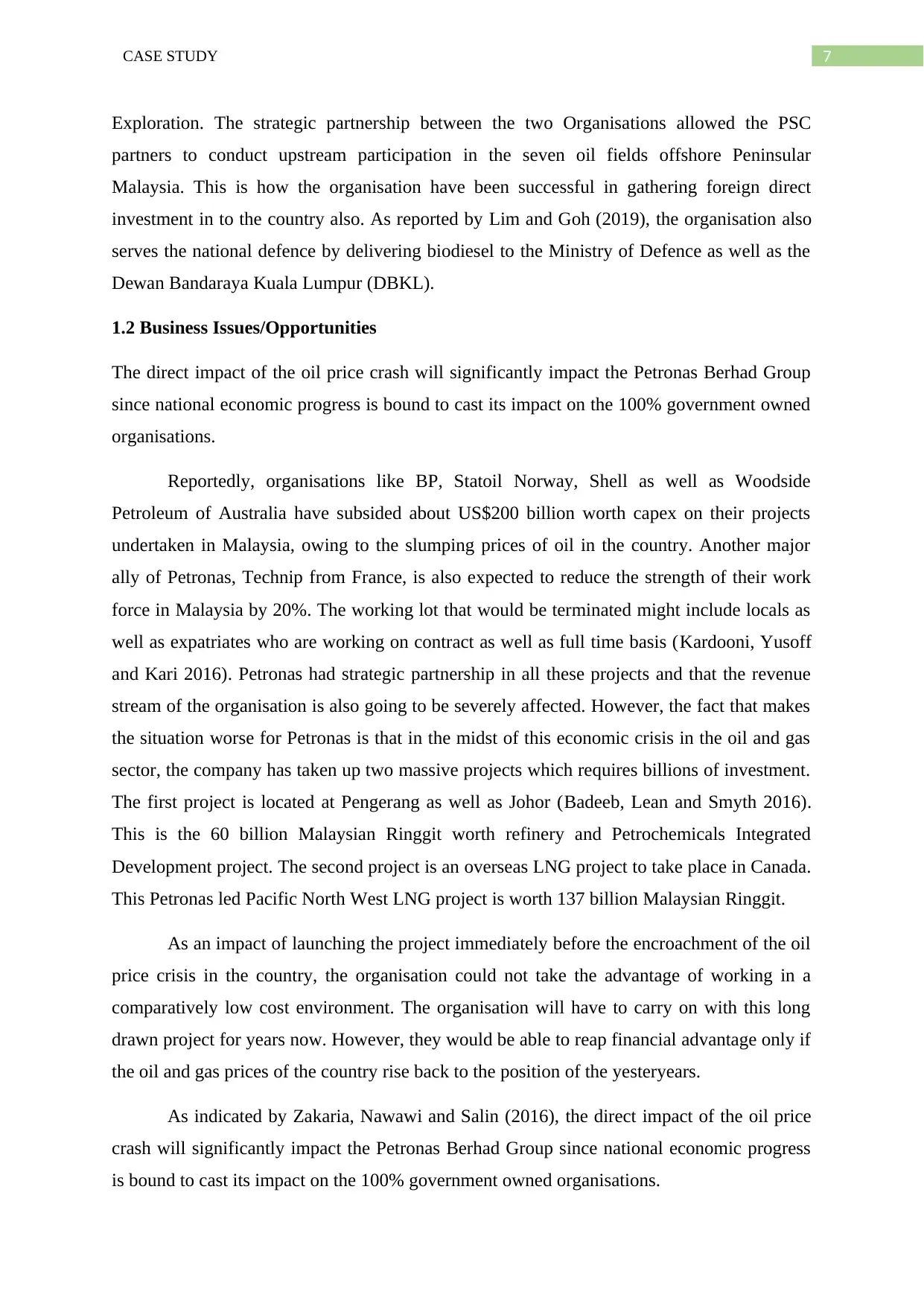
7CASE STUDY
Exploration. The strategic partnership between the two Organisations allowed the PSC
partners to conduct upstream participation in the seven oil fields offshore Peninsular
Malaysia. This is how the organisation have been successful in gathering foreign direct
investment in to the country also. As reported by Lim and Goh (2019), the organisation also
serves the national defence by delivering biodiesel to the Ministry of Defence as well as the
Dewan Bandaraya Kuala Lumpur (DBKL).
1.2 Business Issues/Opportunities
The direct impact of the oil price crash will significantly impact the Petronas Berhad Group
since national economic progress is bound to cast its impact on the 100% government owned
organisations.
Reportedly, organisations like BP, Statoil Norway, Shell as well as Woodside
Petroleum of Australia have subsided about US$200 billion worth capex on their projects
undertaken in Malaysia, owing to the slumping prices of oil in the country. Another major
ally of Petronas, Technip from France, is also expected to reduce the strength of their work
force in Malaysia by 20%. The working lot that would be terminated might include locals as
well as expatriates who are working on contract as well as full time basis (Kardooni, Yusoff
and Kari 2016). Petronas had strategic partnership in all these projects and that the revenue
stream of the organisation is also going to be severely affected. However, the fact that makes
the situation worse for Petronas is that in the midst of this economic crisis in the oil and gas
sector, the company has taken up two massive projects which requires billions of investment.
The first project is located at Pengerang as well as Johor (Badeeb, Lean and Smyth 2016).
This is the 60 billion Malaysian Ringgit worth refinery and Petrochemicals Integrated
Development project. The second project is an overseas LNG project to take place in Canada.
This Petronas led Pacific North West LNG project is worth 137 billion Malaysian Ringgit.
As an impact of launching the project immediately before the encroachment of the oil
price crisis in the country, the organisation could not take the advantage of working in a
comparatively low cost environment. The organisation will have to carry on with this long
drawn project for years now. However, they would be able to reap financial advantage only if
the oil and gas prices of the country rise back to the position of the yesteryears.
As indicated by Zakaria, Nawawi and Salin (2016), the direct impact of the oil price
crash will significantly impact the Petronas Berhad Group since national economic progress
is bound to cast its impact on the 100% government owned organisations.
Exploration. The strategic partnership between the two Organisations allowed the PSC
partners to conduct upstream participation in the seven oil fields offshore Peninsular
Malaysia. This is how the organisation have been successful in gathering foreign direct
investment in to the country also. As reported by Lim and Goh (2019), the organisation also
serves the national defence by delivering biodiesel to the Ministry of Defence as well as the
Dewan Bandaraya Kuala Lumpur (DBKL).
1.2 Business Issues/Opportunities
The direct impact of the oil price crash will significantly impact the Petronas Berhad Group
since national economic progress is bound to cast its impact on the 100% government owned
organisations.
Reportedly, organisations like BP, Statoil Norway, Shell as well as Woodside
Petroleum of Australia have subsided about US$200 billion worth capex on their projects
undertaken in Malaysia, owing to the slumping prices of oil in the country. Another major
ally of Petronas, Technip from France, is also expected to reduce the strength of their work
force in Malaysia by 20%. The working lot that would be terminated might include locals as
well as expatriates who are working on contract as well as full time basis (Kardooni, Yusoff
and Kari 2016). Petronas had strategic partnership in all these projects and that the revenue
stream of the organisation is also going to be severely affected. However, the fact that makes
the situation worse for Petronas is that in the midst of this economic crisis in the oil and gas
sector, the company has taken up two massive projects which requires billions of investment.
The first project is located at Pengerang as well as Johor (Badeeb, Lean and Smyth 2016).
This is the 60 billion Malaysian Ringgit worth refinery and Petrochemicals Integrated
Development project. The second project is an overseas LNG project to take place in Canada.
This Petronas led Pacific North West LNG project is worth 137 billion Malaysian Ringgit.
As an impact of launching the project immediately before the encroachment of the oil
price crisis in the country, the organisation could not take the advantage of working in a
comparatively low cost environment. The organisation will have to carry on with this long
drawn project for years now. However, they would be able to reap financial advantage only if
the oil and gas prices of the country rise back to the position of the yesteryears.
As indicated by Zakaria, Nawawi and Salin (2016), the direct impact of the oil price
crash will significantly impact the Petronas Berhad Group since national economic progress
is bound to cast its impact on the 100% government owned organisations.
Paraphrase This Document
Need a fresh take? Get an instant paraphrase of this document with our AI Paraphraser
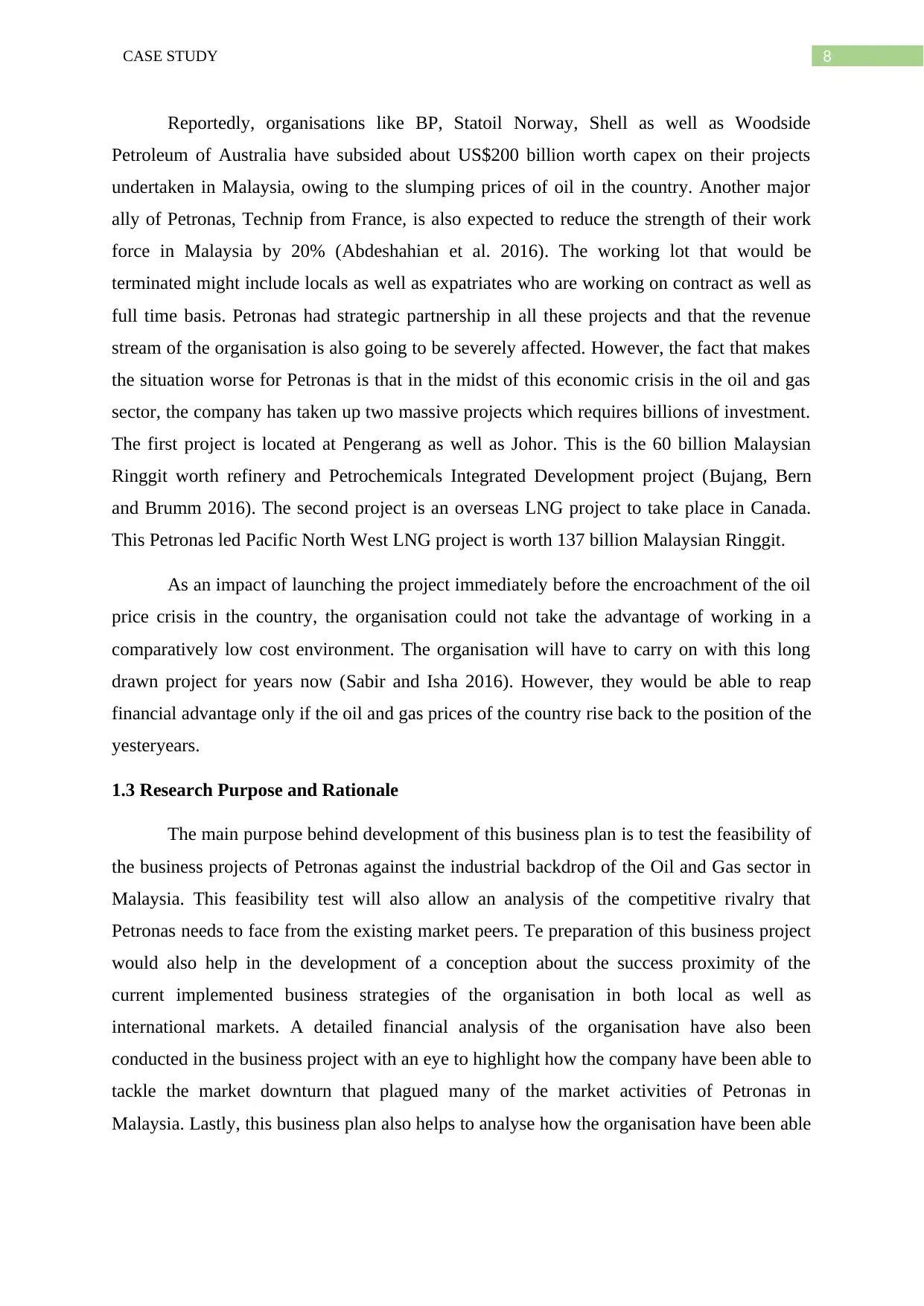
8CASE STUDY
Reportedly, organisations like BP, Statoil Norway, Shell as well as Woodside
Petroleum of Australia have subsided about US$200 billion worth capex on their projects
undertaken in Malaysia, owing to the slumping prices of oil in the country. Another major
ally of Petronas, Technip from France, is also expected to reduce the strength of their work
force in Malaysia by 20% (Abdeshahian et al. 2016). The working lot that would be
terminated might include locals as well as expatriates who are working on contract as well as
full time basis. Petronas had strategic partnership in all these projects and that the revenue
stream of the organisation is also going to be severely affected. However, the fact that makes
the situation worse for Petronas is that in the midst of this economic crisis in the oil and gas
sector, the company has taken up two massive projects which requires billions of investment.
The first project is located at Pengerang as well as Johor. This is the 60 billion Malaysian
Ringgit worth refinery and Petrochemicals Integrated Development project (Bujang, Bern
and Brumm 2016). The second project is an overseas LNG project to take place in Canada.
This Petronas led Pacific North West LNG project is worth 137 billion Malaysian Ringgit.
As an impact of launching the project immediately before the encroachment of the oil
price crisis in the country, the organisation could not take the advantage of working in a
comparatively low cost environment. The organisation will have to carry on with this long
drawn project for years now (Sabir and Isha 2016). However, they would be able to reap
financial advantage only if the oil and gas prices of the country rise back to the position of the
yesteryears.
1.3 Research Purpose and Rationale
The main purpose behind development of this business plan is to test the feasibility of
the business projects of Petronas against the industrial backdrop of the Oil and Gas sector in
Malaysia. This feasibility test will also allow an analysis of the competitive rivalry that
Petronas needs to face from the existing market peers. Te preparation of this business project
would also help in the development of a conception about the success proximity of the
current implemented business strategies of the organisation in both local as well as
international markets. A detailed financial analysis of the organisation have also been
conducted in the business project with an eye to highlight how the company have been able to
tackle the market downturn that plagued many of the market activities of Petronas in
Malaysia. Lastly, this business plan also helps to analyse how the organisation have been able
Reportedly, organisations like BP, Statoil Norway, Shell as well as Woodside
Petroleum of Australia have subsided about US$200 billion worth capex on their projects
undertaken in Malaysia, owing to the slumping prices of oil in the country. Another major
ally of Petronas, Technip from France, is also expected to reduce the strength of their work
force in Malaysia by 20% (Abdeshahian et al. 2016). The working lot that would be
terminated might include locals as well as expatriates who are working on contract as well as
full time basis. Petronas had strategic partnership in all these projects and that the revenue
stream of the organisation is also going to be severely affected. However, the fact that makes
the situation worse for Petronas is that in the midst of this economic crisis in the oil and gas
sector, the company has taken up two massive projects which requires billions of investment.
The first project is located at Pengerang as well as Johor. This is the 60 billion Malaysian
Ringgit worth refinery and Petrochemicals Integrated Development project (Bujang, Bern
and Brumm 2016). The second project is an overseas LNG project to take place in Canada.
This Petronas led Pacific North West LNG project is worth 137 billion Malaysian Ringgit.
As an impact of launching the project immediately before the encroachment of the oil
price crisis in the country, the organisation could not take the advantage of working in a
comparatively low cost environment. The organisation will have to carry on with this long
drawn project for years now (Sabir and Isha 2016). However, they would be able to reap
financial advantage only if the oil and gas prices of the country rise back to the position of the
yesteryears.
1.3 Research Purpose and Rationale
The main purpose behind development of this business plan is to test the feasibility of
the business projects of Petronas against the industrial backdrop of the Oil and Gas sector in
Malaysia. This feasibility test will also allow an analysis of the competitive rivalry that
Petronas needs to face from the existing market peers. Te preparation of this business project
would also help in the development of a conception about the success proximity of the
current implemented business strategies of the organisation in both local as well as
international markets. A detailed financial analysis of the organisation have also been
conducted in the business project with an eye to highlight how the company have been able to
tackle the market downturn that plagued many of the market activities of Petronas in
Malaysia. Lastly, this business plan also helps to analyse how the organisation have been able

9CASE STUDY
to attract investors and customers. This has in turn led to an analysis of the future sustenance
of the organisation in the local as well as the foreign markets.
The major factor that concerns the organisation now is that the major organisational
leaders are also uncertain about the extent to which Petronas will be impacted as an impact of
the central oil price crash. Apparently, it should feel that they would be a short to medium
term impact of the oil price crash. However if the price decline continues for a prolonged
period comma its impact will badly hit the organisation and also all other allied and
associated agencies who are involved in Oil exploration in Malaysia (Ambrose et al. 2017).
Hence, the company will not only experience and immediate impact, its business Associates
will also lose faith in the organisation and the Global brand name of the organisation will be
impacted in the long run also. Big corporations like Exxon Mobil who have 223 strategic
business line up with Petronas in Malaysia might cancel their business contracts because of
the significant and sharp rise in the oil prices (Foo et al. 2015). The major business strategy
of Petronas that is product differentiation, will also be badly infected since the product prices
of all oil and gas variations will take place at an equal level. As an impact product
differentiation will not generate any further value for the customers.
However, as reported by Bakar et al. (2016), there is a two digit factors that might save
Petronas from the impact of this price crisis. The organisation owns almost all the oil and gas
deposits in Malaysia with absolute authority. This is why the economic impact that will be
experienced by the other international Oil Companies will be more compared to that Petronas
will have to face. In short contrast, researchers like Bong et al. (2017), states that an analysis
of the second quarter financial account of the financial year 2018 released by Petronas shows
that lower price of oil has had a severe impact upon the business. The fact that the upstream
business of Petronas in Malaysia sale by 57% in the initial 6 months of the financial year
2018, makes it evident.
The rise in the prices of oil is also slowing down the pace of declaration work of Petronas
in Malaysia. The operational costs of the organisation has increased because of the
enhancement of oil prices in the market. The oil price hike is impacting the organisation in
two ways. The market fuel price is costing the company higher than before which is
impacting the operational cost in one way. On the other hand the price hike has reduced seal
because of which Petronas who has their major market in domestic operations is being badly
to attract investors and customers. This has in turn led to an analysis of the future sustenance
of the organisation in the local as well as the foreign markets.
The major factor that concerns the organisation now is that the major organisational
leaders are also uncertain about the extent to which Petronas will be impacted as an impact of
the central oil price crash. Apparently, it should feel that they would be a short to medium
term impact of the oil price crash. However if the price decline continues for a prolonged
period comma its impact will badly hit the organisation and also all other allied and
associated agencies who are involved in Oil exploration in Malaysia (Ambrose et al. 2017).
Hence, the company will not only experience and immediate impact, its business Associates
will also lose faith in the organisation and the Global brand name of the organisation will be
impacted in the long run also. Big corporations like Exxon Mobil who have 223 strategic
business line up with Petronas in Malaysia might cancel their business contracts because of
the significant and sharp rise in the oil prices (Foo et al. 2015). The major business strategy
of Petronas that is product differentiation, will also be badly infected since the product prices
of all oil and gas variations will take place at an equal level. As an impact product
differentiation will not generate any further value for the customers.
However, as reported by Bakar et al. (2016), there is a two digit factors that might save
Petronas from the impact of this price crisis. The organisation owns almost all the oil and gas
deposits in Malaysia with absolute authority. This is why the economic impact that will be
experienced by the other international Oil Companies will be more compared to that Petronas
will have to face. In short contrast, researchers like Bong et al. (2017), states that an analysis
of the second quarter financial account of the financial year 2018 released by Petronas shows
that lower price of oil has had a severe impact upon the business. The fact that the upstream
business of Petronas in Malaysia sale by 57% in the initial 6 months of the financial year
2018, makes it evident.
The rise in the prices of oil is also slowing down the pace of declaration work of Petronas
in Malaysia. The operational costs of the organisation has increased because of the
enhancement of oil prices in the market. The oil price hike is impacting the organisation in
two ways. The market fuel price is costing the company higher than before which is
impacting the operational cost in one way. On the other hand the price hike has reduced seal
because of which Petronas who has their major market in domestic operations is being badly
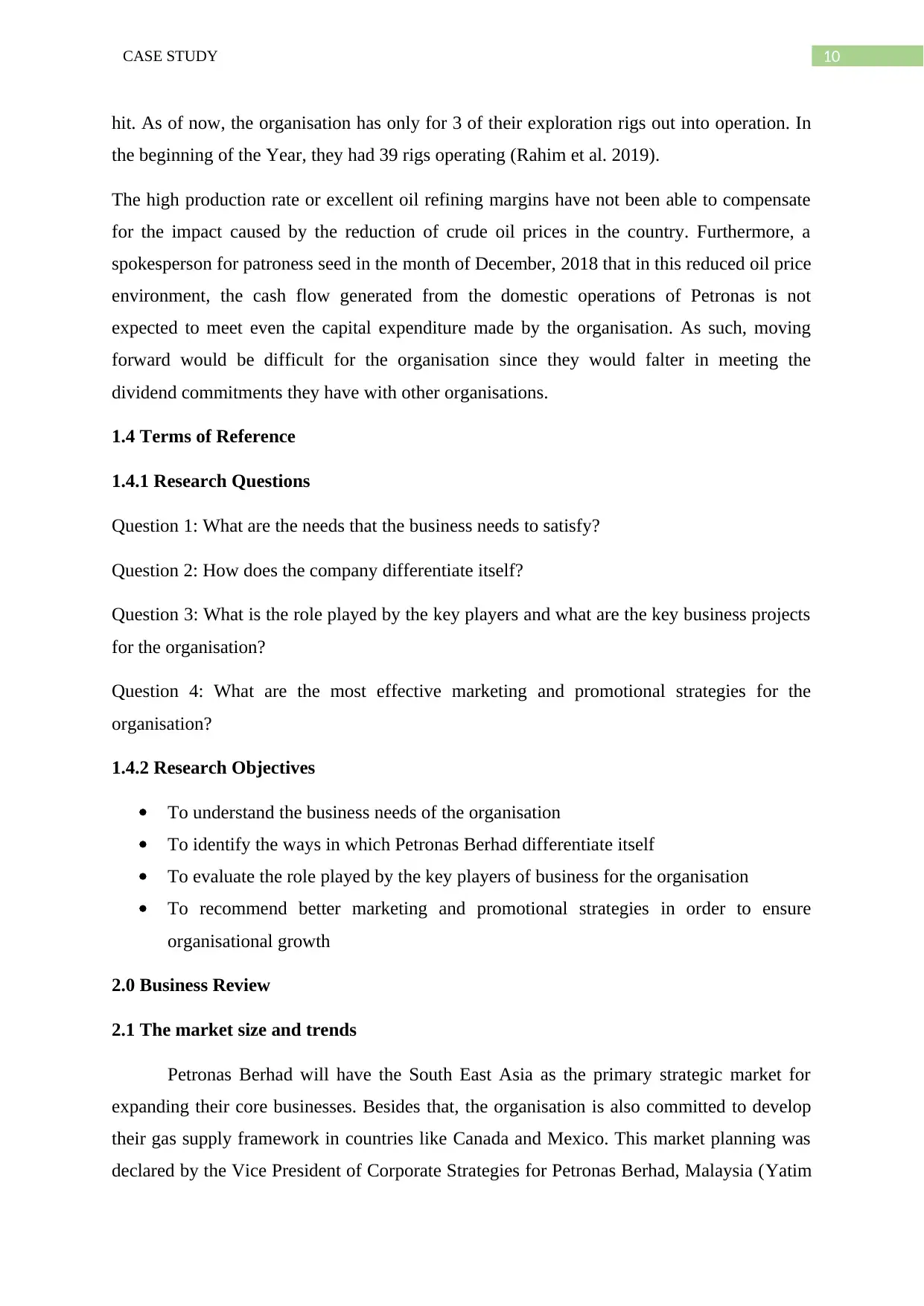
10CASE STUDY
hit. As of now, the organisation has only for 3 of their exploration rigs out into operation. In
the beginning of the Year, they had 39 rigs operating (Rahim et al. 2019).
The high production rate or excellent oil refining margins have not been able to compensate
for the impact caused by the reduction of crude oil prices in the country. Furthermore, a
spokesperson for patroness seed in the month of December, 2018 that in this reduced oil price
environment, the cash flow generated from the domestic operations of Petronas is not
expected to meet even the capital expenditure made by the organisation. As such, moving
forward would be difficult for the organisation since they would falter in meeting the
dividend commitments they have with other organisations.
1.4 Terms of Reference
1.4.1 Research Questions
Question 1: What are the needs that the business needs to satisfy?
Question 2: How does the company differentiate itself?
Question 3: What is the role played by the key players and what are the key business projects
for the organisation?
Question 4: What are the most effective marketing and promotional strategies for the
organisation?
1.4.2 Research Objectives
To understand the business needs of the organisation
To identify the ways in which Petronas Berhad differentiate itself
To evaluate the role played by the key players of business for the organisation
To recommend better marketing and promotional strategies in order to ensure
organisational growth
2.0 Business Review
2.1 The market size and trends
Petronas Berhad will have the South East Asia as the primary strategic market for
expanding their core businesses. Besides that, the organisation is also committed to develop
their gas supply framework in countries like Canada and Mexico. This market planning was
declared by the Vice President of Corporate Strategies for Petronas Berhad, Malaysia (Yatim
hit. As of now, the organisation has only for 3 of their exploration rigs out into operation. In
the beginning of the Year, they had 39 rigs operating (Rahim et al. 2019).
The high production rate or excellent oil refining margins have not been able to compensate
for the impact caused by the reduction of crude oil prices in the country. Furthermore, a
spokesperson for patroness seed in the month of December, 2018 that in this reduced oil price
environment, the cash flow generated from the domestic operations of Petronas is not
expected to meet even the capital expenditure made by the organisation. As such, moving
forward would be difficult for the organisation since they would falter in meeting the
dividend commitments they have with other organisations.
1.4 Terms of Reference
1.4.1 Research Questions
Question 1: What are the needs that the business needs to satisfy?
Question 2: How does the company differentiate itself?
Question 3: What is the role played by the key players and what are the key business projects
for the organisation?
Question 4: What are the most effective marketing and promotional strategies for the
organisation?
1.4.2 Research Objectives
To understand the business needs of the organisation
To identify the ways in which Petronas Berhad differentiate itself
To evaluate the role played by the key players of business for the organisation
To recommend better marketing and promotional strategies in order to ensure
organisational growth
2.0 Business Review
2.1 The market size and trends
Petronas Berhad will have the South East Asia as the primary strategic market for
expanding their core businesses. Besides that, the organisation is also committed to develop
their gas supply framework in countries like Canada and Mexico. This market planning was
declared by the Vice President of Corporate Strategies for Petronas Berhad, Malaysia (Yatim
Secure Best Marks with AI Grader
Need help grading? Try our AI Grader for instant feedback on your assignments.
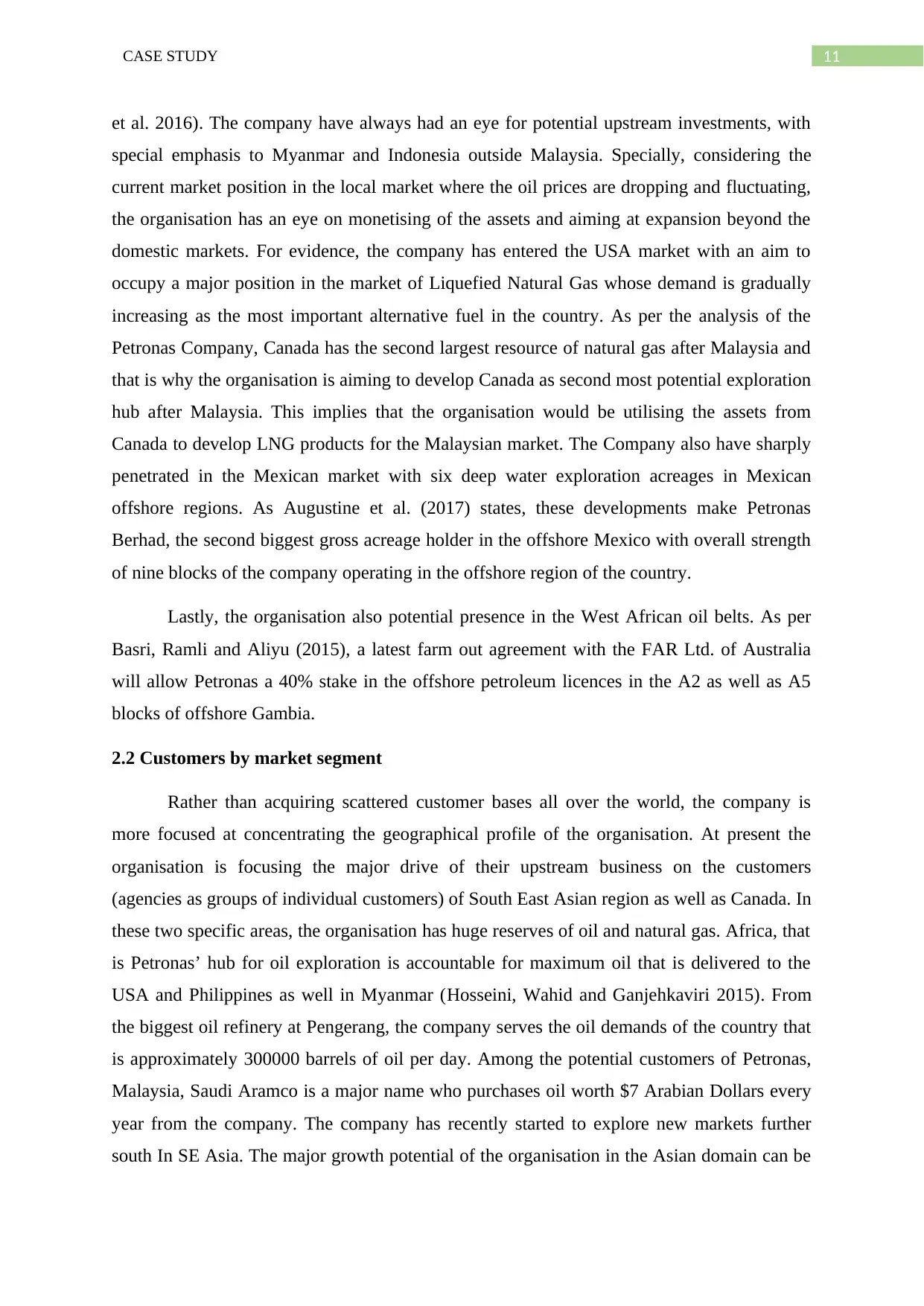
11CASE STUDY
et al. 2016). The company have always had an eye for potential upstream investments, with
special emphasis to Myanmar and Indonesia outside Malaysia. Specially, considering the
current market position in the local market where the oil prices are dropping and fluctuating,
the organisation has an eye on monetising of the assets and aiming at expansion beyond the
domestic markets. For evidence, the company has entered the USA market with an aim to
occupy a major position in the market of Liquefied Natural Gas whose demand is gradually
increasing as the most important alternative fuel in the country. As per the analysis of the
Petronas Company, Canada has the second largest resource of natural gas after Malaysia and
that is why the organisation is aiming to develop Canada as second most potential exploration
hub after Malaysia. This implies that the organisation would be utilising the assets from
Canada to develop LNG products for the Malaysian market. The Company also have sharply
penetrated in the Mexican market with six deep water exploration acreages in Mexican
offshore regions. As Augustine et al. (2017) states, these developments make Petronas
Berhad, the second biggest gross acreage holder in the offshore Mexico with overall strength
of nine blocks of the company operating in the offshore region of the country.
Lastly, the organisation also potential presence in the West African oil belts. As per
Basri, Ramli and Aliyu (2015), a latest farm out agreement with the FAR Ltd. of Australia
will allow Petronas a 40% stake in the offshore petroleum licences in the A2 as well as A5
blocks of offshore Gambia.
2.2 Customers by market segment
Rather than acquiring scattered customer bases all over the world, the company is
more focused at concentrating the geographical profile of the organisation. At present the
organisation is focusing the major drive of their upstream business on the customers
(agencies as groups of individual customers) of South East Asian region as well as Canada. In
these two specific areas, the organisation has huge reserves of oil and natural gas. Africa, that
is Petronas’ hub for oil exploration is accountable for maximum oil that is delivered to the
USA and Philippines as well in Myanmar (Hosseini, Wahid and Ganjehkaviri 2015). From
the biggest oil refinery at Pengerang, the company serves the oil demands of the country that
is approximately 300000 barrels of oil per day. Among the potential customers of Petronas,
Malaysia, Saudi Aramco is a major name who purchases oil worth $7 Arabian Dollars every
year from the company. The company has recently started to explore new markets further
south In SE Asia. The major growth potential of the organisation in the Asian domain can be
et al. 2016). The company have always had an eye for potential upstream investments, with
special emphasis to Myanmar and Indonesia outside Malaysia. Specially, considering the
current market position in the local market where the oil prices are dropping and fluctuating,
the organisation has an eye on monetising of the assets and aiming at expansion beyond the
domestic markets. For evidence, the company has entered the USA market with an aim to
occupy a major position in the market of Liquefied Natural Gas whose demand is gradually
increasing as the most important alternative fuel in the country. As per the analysis of the
Petronas Company, Canada has the second largest resource of natural gas after Malaysia and
that is why the organisation is aiming to develop Canada as second most potential exploration
hub after Malaysia. This implies that the organisation would be utilising the assets from
Canada to develop LNG products for the Malaysian market. The Company also have sharply
penetrated in the Mexican market with six deep water exploration acreages in Mexican
offshore regions. As Augustine et al. (2017) states, these developments make Petronas
Berhad, the second biggest gross acreage holder in the offshore Mexico with overall strength
of nine blocks of the company operating in the offshore region of the country.
Lastly, the organisation also potential presence in the West African oil belts. As per
Basri, Ramli and Aliyu (2015), a latest farm out agreement with the FAR Ltd. of Australia
will allow Petronas a 40% stake in the offshore petroleum licences in the A2 as well as A5
blocks of offshore Gambia.
2.2 Customers by market segment
Rather than acquiring scattered customer bases all over the world, the company is
more focused at concentrating the geographical profile of the organisation. At present the
organisation is focusing the major drive of their upstream business on the customers
(agencies as groups of individual customers) of South East Asian region as well as Canada. In
these two specific areas, the organisation has huge reserves of oil and natural gas. Africa, that
is Petronas’ hub for oil exploration is accountable for maximum oil that is delivered to the
USA and Philippines as well in Myanmar (Hosseini, Wahid and Ganjehkaviri 2015). From
the biggest oil refinery at Pengerang, the company serves the oil demands of the country that
is approximately 300000 barrels of oil per day. Among the potential customers of Petronas,
Malaysia, Saudi Aramco is a major name who purchases oil worth $7 Arabian Dollars every
year from the company. The company has recently started to explore new markets further
south In SE Asia. The major growth potential of the organisation in the Asian domain can be
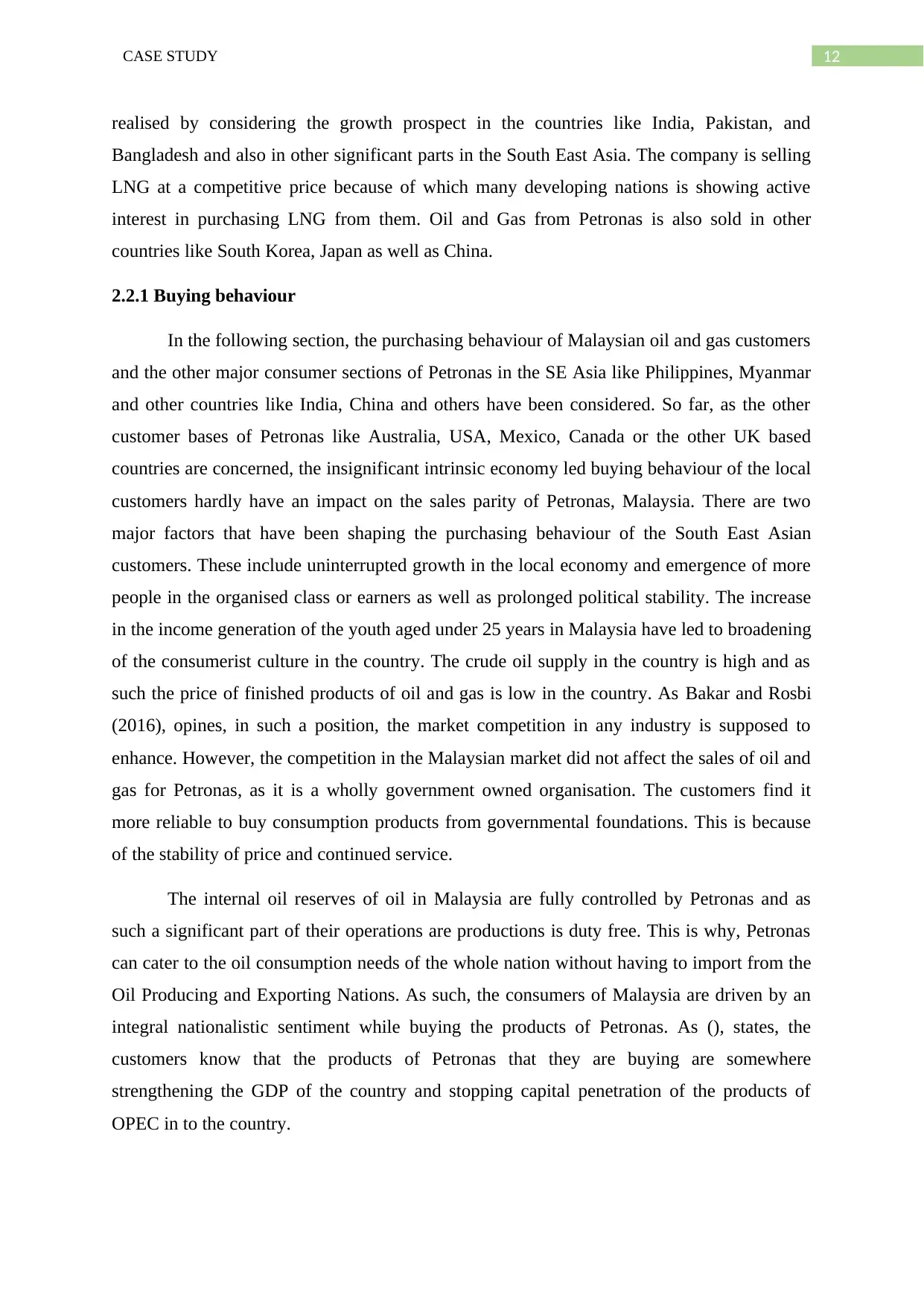
12CASE STUDY
realised by considering the growth prospect in the countries like India, Pakistan, and
Bangladesh and also in other significant parts in the South East Asia. The company is selling
LNG at a competitive price because of which many developing nations is showing active
interest in purchasing LNG from them. Oil and Gas from Petronas is also sold in other
countries like South Korea, Japan as well as China.
2.2.1 Buying behaviour
In the following section, the purchasing behaviour of Malaysian oil and gas customers
and the other major consumer sections of Petronas in the SE Asia like Philippines, Myanmar
and other countries like India, China and others have been considered. So far, as the other
customer bases of Petronas like Australia, USA, Mexico, Canada or the other UK based
countries are concerned, the insignificant intrinsic economy led buying behaviour of the local
customers hardly have an impact on the sales parity of Petronas, Malaysia. There are two
major factors that have been shaping the purchasing behaviour of the South East Asian
customers. These include uninterrupted growth in the local economy and emergence of more
people in the organised class or earners as well as prolonged political stability. The increase
in the income generation of the youth aged under 25 years in Malaysia have led to broadening
of the consumerist culture in the country. The crude oil supply in the country is high and as
such the price of finished products of oil and gas is low in the country. As Bakar and Rosbi
(2016), opines, in such a position, the market competition in any industry is supposed to
enhance. However, the competition in the Malaysian market did not affect the sales of oil and
gas for Petronas, as it is a wholly government owned organisation. The customers find it
more reliable to buy consumption products from governmental foundations. This is because
of the stability of price and continued service.
The internal oil reserves of oil in Malaysia are fully controlled by Petronas and as
such a significant part of their operations are productions is duty free. This is why, Petronas
can cater to the oil consumption needs of the whole nation without having to import from the
Oil Producing and Exporting Nations. As such, the consumers of Malaysia are driven by an
integral nationalistic sentiment while buying the products of Petronas. As (), states, the
customers know that the products of Petronas that they are buying are somewhere
strengthening the GDP of the country and stopping capital penetration of the products of
OPEC in to the country.
realised by considering the growth prospect in the countries like India, Pakistan, and
Bangladesh and also in other significant parts in the South East Asia. The company is selling
LNG at a competitive price because of which many developing nations is showing active
interest in purchasing LNG from them. Oil and Gas from Petronas is also sold in other
countries like South Korea, Japan as well as China.
2.2.1 Buying behaviour
In the following section, the purchasing behaviour of Malaysian oil and gas customers
and the other major consumer sections of Petronas in the SE Asia like Philippines, Myanmar
and other countries like India, China and others have been considered. So far, as the other
customer bases of Petronas like Australia, USA, Mexico, Canada or the other UK based
countries are concerned, the insignificant intrinsic economy led buying behaviour of the local
customers hardly have an impact on the sales parity of Petronas, Malaysia. There are two
major factors that have been shaping the purchasing behaviour of the South East Asian
customers. These include uninterrupted growth in the local economy and emergence of more
people in the organised class or earners as well as prolonged political stability. The increase
in the income generation of the youth aged under 25 years in Malaysia have led to broadening
of the consumerist culture in the country. The crude oil supply in the country is high and as
such the price of finished products of oil and gas is low in the country. As Bakar and Rosbi
(2016), opines, in such a position, the market competition in any industry is supposed to
enhance. However, the competition in the Malaysian market did not affect the sales of oil and
gas for Petronas, as it is a wholly government owned organisation. The customers find it
more reliable to buy consumption products from governmental foundations. This is because
of the stability of price and continued service.
The internal oil reserves of oil in Malaysia are fully controlled by Petronas and as
such a significant part of their operations are productions is duty free. This is why, Petronas
can cater to the oil consumption needs of the whole nation without having to import from the
Oil Producing and Exporting Nations. As such, the consumers of Malaysia are driven by an
integral nationalistic sentiment while buying the products of Petronas. As (), states, the
customers know that the products of Petronas that they are buying are somewhere
strengthening the GDP of the country and stopping capital penetration of the products of
OPEC in to the country.
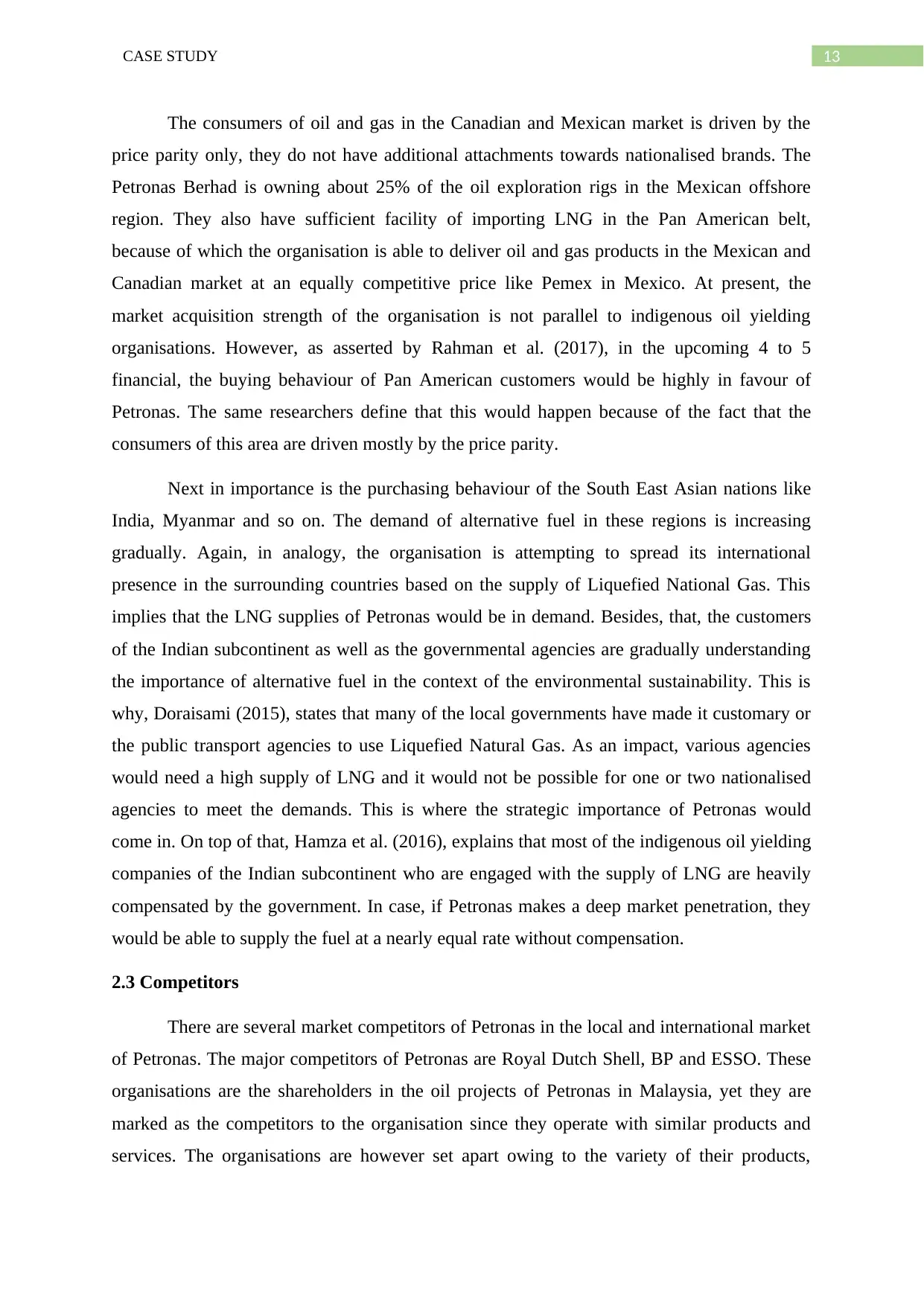
13CASE STUDY
The consumers of oil and gas in the Canadian and Mexican market is driven by the
price parity only, they do not have additional attachments towards nationalised brands. The
Petronas Berhad is owning about 25% of the oil exploration rigs in the Mexican offshore
region. They also have sufficient facility of importing LNG in the Pan American belt,
because of which the organisation is able to deliver oil and gas products in the Mexican and
Canadian market at an equally competitive price like Pemex in Mexico. At present, the
market acquisition strength of the organisation is not parallel to indigenous oil yielding
organisations. However, as asserted by Rahman et al. (2017), in the upcoming 4 to 5
financial, the buying behaviour of Pan American customers would be highly in favour of
Petronas. The same researchers define that this would happen because of the fact that the
consumers of this area are driven mostly by the price parity.
Next in importance is the purchasing behaviour of the South East Asian nations like
India, Myanmar and so on. The demand of alternative fuel in these regions is increasing
gradually. Again, in analogy, the organisation is attempting to spread its international
presence in the surrounding countries based on the supply of Liquefied National Gas. This
implies that the LNG supplies of Petronas would be in demand. Besides, that, the customers
of the Indian subcontinent as well as the governmental agencies are gradually understanding
the importance of alternative fuel in the context of the environmental sustainability. This is
why, Doraisami (2015), states that many of the local governments have made it customary or
the public transport agencies to use Liquefied Natural Gas. As an impact, various agencies
would need a high supply of LNG and it would not be possible for one or two nationalised
agencies to meet the demands. This is where the strategic importance of Petronas would
come in. On top of that, Hamza et al. (2016), explains that most of the indigenous oil yielding
companies of the Indian subcontinent who are engaged with the supply of LNG are heavily
compensated by the government. In case, if Petronas makes a deep market penetration, they
would be able to supply the fuel at a nearly equal rate without compensation.
2.3 Competitors
There are several market competitors of Petronas in the local and international market
of Petronas. The major competitors of Petronas are Royal Dutch Shell, BP and ESSO. These
organisations are the shareholders in the oil projects of Petronas in Malaysia, yet they are
marked as the competitors to the organisation since they operate with similar products and
services. The organisations are however set apart owing to the variety of their products,
The consumers of oil and gas in the Canadian and Mexican market is driven by the
price parity only, they do not have additional attachments towards nationalised brands. The
Petronas Berhad is owning about 25% of the oil exploration rigs in the Mexican offshore
region. They also have sufficient facility of importing LNG in the Pan American belt,
because of which the organisation is able to deliver oil and gas products in the Mexican and
Canadian market at an equally competitive price like Pemex in Mexico. At present, the
market acquisition strength of the organisation is not parallel to indigenous oil yielding
organisations. However, as asserted by Rahman et al. (2017), in the upcoming 4 to 5
financial, the buying behaviour of Pan American customers would be highly in favour of
Petronas. The same researchers define that this would happen because of the fact that the
consumers of this area are driven mostly by the price parity.
Next in importance is the purchasing behaviour of the South East Asian nations like
India, Myanmar and so on. The demand of alternative fuel in these regions is increasing
gradually. Again, in analogy, the organisation is attempting to spread its international
presence in the surrounding countries based on the supply of Liquefied National Gas. This
implies that the LNG supplies of Petronas would be in demand. Besides, that, the customers
of the Indian subcontinent as well as the governmental agencies are gradually understanding
the importance of alternative fuel in the context of the environmental sustainability. This is
why, Doraisami (2015), states that many of the local governments have made it customary or
the public transport agencies to use Liquefied Natural Gas. As an impact, various agencies
would need a high supply of LNG and it would not be possible for one or two nationalised
agencies to meet the demands. This is where the strategic importance of Petronas would
come in. On top of that, Hamza et al. (2016), explains that most of the indigenous oil yielding
companies of the Indian subcontinent who are engaged with the supply of LNG are heavily
compensated by the government. In case, if Petronas makes a deep market penetration, they
would be able to supply the fuel at a nearly equal rate without compensation.
2.3 Competitors
There are several market competitors of Petronas in the local and international market
of Petronas. The major competitors of Petronas are Royal Dutch Shell, BP and ESSO. These
organisations are the shareholders in the oil projects of Petronas in Malaysia, yet they are
marked as the competitors to the organisation since they operate with similar products and
services. The organisations are however set apart owing to the variety of their products,
Paraphrase This Document
Need a fresh take? Get an instant paraphrase of this document with our AI Paraphraser
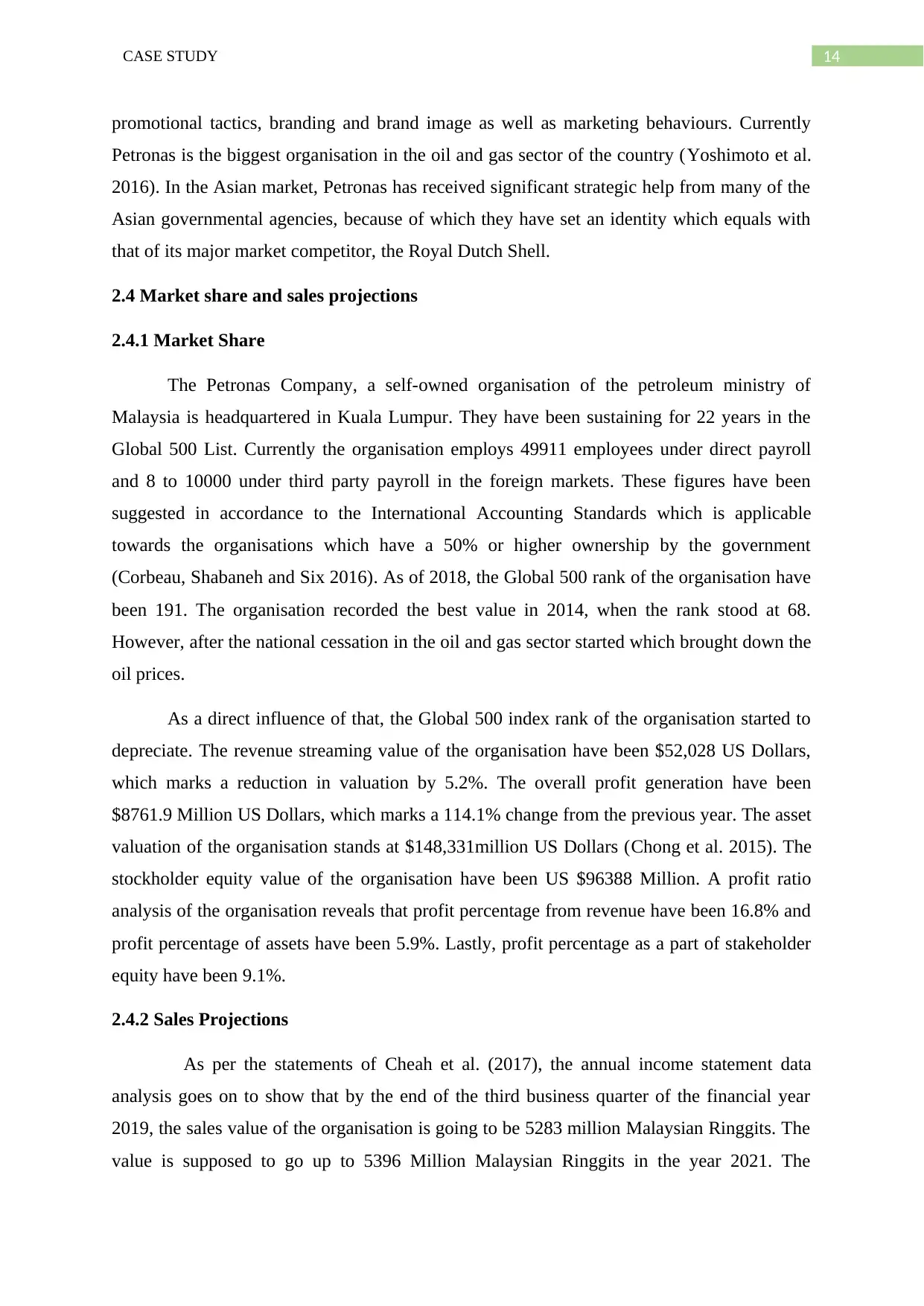
14CASE STUDY
promotional tactics, branding and brand image as well as marketing behaviours. Currently
Petronas is the biggest organisation in the oil and gas sector of the country (Yoshimoto et al.
2016). In the Asian market, Petronas has received significant strategic help from many of the
Asian governmental agencies, because of which they have set an identity which equals with
that of its major market competitor, the Royal Dutch Shell.
2.4 Market share and sales projections
2.4.1 Market Share
The Petronas Company, a self-owned organisation of the petroleum ministry of
Malaysia is headquartered in Kuala Lumpur. They have been sustaining for 22 years in the
Global 500 List. Currently the organisation employs 49911 employees under direct payroll
and 8 to 10000 under third party payroll in the foreign markets. These figures have been
suggested in accordance to the International Accounting Standards which is applicable
towards the organisations which have a 50% or higher ownership by the government
(Corbeau, Shabaneh and Six 2016). As of 2018, the Global 500 rank of the organisation have
been 191. The organisation recorded the best value in 2014, when the rank stood at 68.
However, after the national cessation in the oil and gas sector started which brought down the
oil prices.
As a direct influence of that, the Global 500 index rank of the organisation started to
depreciate. The revenue streaming value of the organisation have been $52,028 US Dollars,
which marks a reduction in valuation by 5.2%. The overall profit generation have been
$8761.9 Million US Dollars, which marks a 114.1% change from the previous year. The asset
valuation of the organisation stands at $148,331million US Dollars (Chong et al. 2015). The
stockholder equity value of the organisation have been US $96388 Million. A profit ratio
analysis of the organisation reveals that profit percentage from revenue have been 16.8% and
profit percentage of assets have been 5.9%. Lastly, profit percentage as a part of stakeholder
equity have been 9.1%.
2.4.2 Sales Projections
As per the statements of Cheah et al. (2017), the annual income statement data
analysis goes on to show that by the end of the third business quarter of the financial year
2019, the sales value of the organisation is going to be 5283 million Malaysian Ringgits. The
value is supposed to go up to 5396 Million Malaysian Ringgits in the year 2021. The
promotional tactics, branding and brand image as well as marketing behaviours. Currently
Petronas is the biggest organisation in the oil and gas sector of the country (Yoshimoto et al.
2016). In the Asian market, Petronas has received significant strategic help from many of the
Asian governmental agencies, because of which they have set an identity which equals with
that of its major market competitor, the Royal Dutch Shell.
2.4 Market share and sales projections
2.4.1 Market Share
The Petronas Company, a self-owned organisation of the petroleum ministry of
Malaysia is headquartered in Kuala Lumpur. They have been sustaining for 22 years in the
Global 500 List. Currently the organisation employs 49911 employees under direct payroll
and 8 to 10000 under third party payroll in the foreign markets. These figures have been
suggested in accordance to the International Accounting Standards which is applicable
towards the organisations which have a 50% or higher ownership by the government
(Corbeau, Shabaneh and Six 2016). As of 2018, the Global 500 rank of the organisation have
been 191. The organisation recorded the best value in 2014, when the rank stood at 68.
However, after the national cessation in the oil and gas sector started which brought down the
oil prices.
As a direct influence of that, the Global 500 index rank of the organisation started to
depreciate. The revenue streaming value of the organisation have been $52,028 US Dollars,
which marks a reduction in valuation by 5.2%. The overall profit generation have been
$8761.9 Million US Dollars, which marks a 114.1% change from the previous year. The asset
valuation of the organisation stands at $148,331million US Dollars (Chong et al. 2015). The
stockholder equity value of the organisation have been US $96388 Million. A profit ratio
analysis of the organisation reveals that profit percentage from revenue have been 16.8% and
profit percentage of assets have been 5.9%. Lastly, profit percentage as a part of stakeholder
equity have been 9.1%.
2.4.2 Sales Projections
As per the statements of Cheah et al. (2017), the annual income statement data
analysis goes on to show that by the end of the third business quarter of the financial year
2019, the sales value of the organisation is going to be 5283 million Malaysian Ringgits. The
value is supposed to go up to 5396 Million Malaysian Ringgits in the year 2021. The
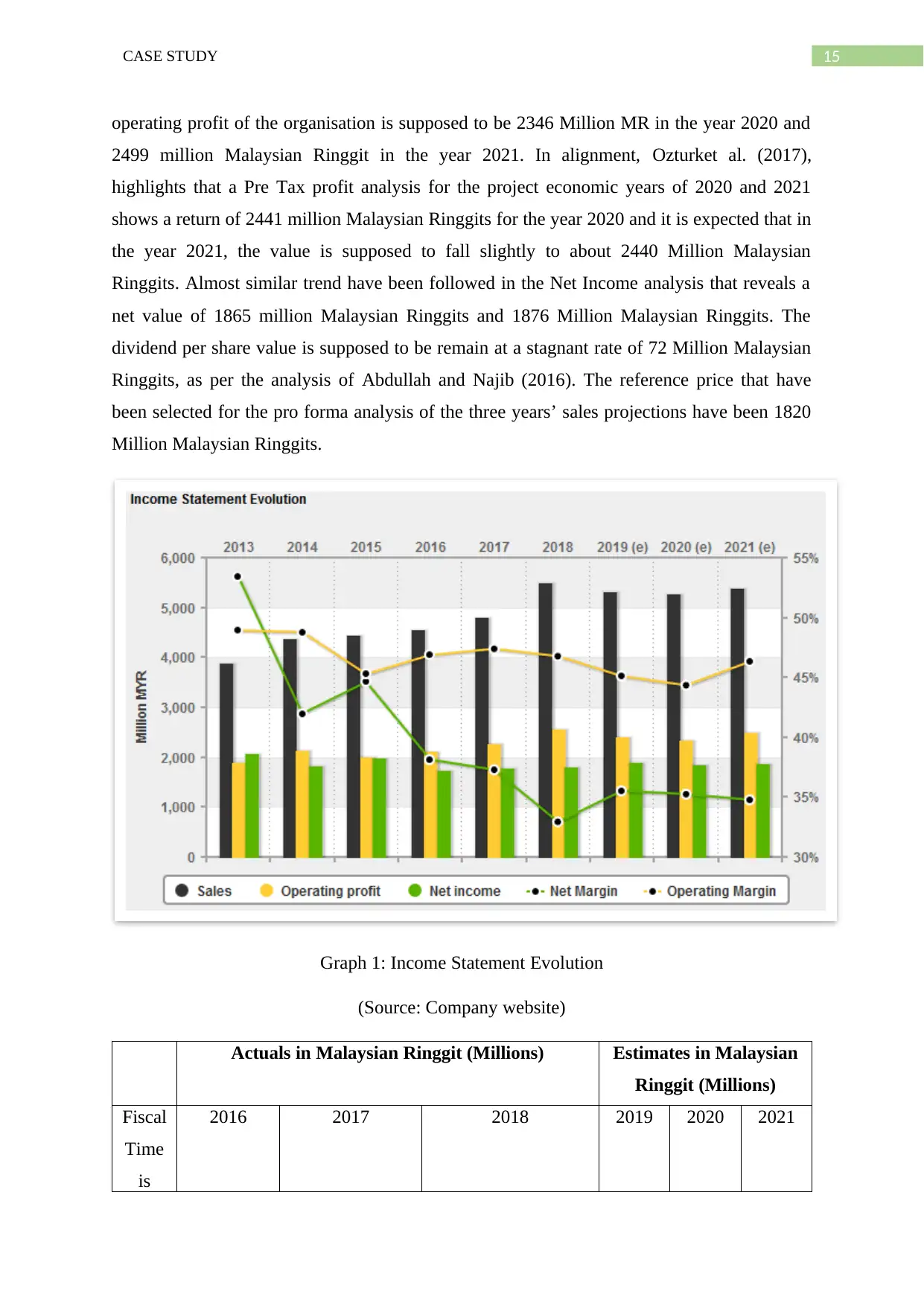
15CASE STUDY
operating profit of the organisation is supposed to be 2346 Million MR in the year 2020 and
2499 million Malaysian Ringgit in the year 2021. In alignment, Ozturket al. (2017),
highlights that a Pre Tax profit analysis for the project economic years of 2020 and 2021
shows a return of 2441 million Malaysian Ringgits for the year 2020 and it is expected that in
the year 2021, the value is supposed to fall slightly to about 2440 Million Malaysian
Ringgits. Almost similar trend have been followed in the Net Income analysis that reveals a
net value of 1865 million Malaysian Ringgits and 1876 Million Malaysian Ringgits. The
dividend per share value is supposed to be remain at a stagnant rate of 72 Million Malaysian
Ringgits, as per the analysis of Abdullah and Najib (2016). The reference price that have
been selected for the pro forma analysis of the three years’ sales projections have been 1820
Million Malaysian Ringgits.
Graph 1: Income Statement Evolution
(Source: Company website)
Actuals in Malaysian Ringgit (Millions) Estimates in Malaysian
Ringgit (Millions)
Fiscal
Time
is
2016 2017 2018 2019 2020 2021
operating profit of the organisation is supposed to be 2346 Million MR in the year 2020 and
2499 million Malaysian Ringgit in the year 2021. In alignment, Ozturket al. (2017),
highlights that a Pre Tax profit analysis for the project economic years of 2020 and 2021
shows a return of 2441 million Malaysian Ringgits for the year 2020 and it is expected that in
the year 2021, the value is supposed to fall slightly to about 2440 Million Malaysian
Ringgits. Almost similar trend have been followed in the Net Income analysis that reveals a
net value of 1865 million Malaysian Ringgits and 1876 Million Malaysian Ringgits. The
dividend per share value is supposed to be remain at a stagnant rate of 72 Million Malaysian
Ringgits, as per the analysis of Abdullah and Najib (2016). The reference price that have
been selected for the pro forma analysis of the three years’ sales projections have been 1820
Million Malaysian Ringgits.
Graph 1: Income Statement Evolution
(Source: Company website)
Actuals in Malaysian Ringgit (Millions) Estimates in Malaysian
Ringgit (Millions)
Fiscal
Time
is
2016 2017 2018 2019 2020 2021
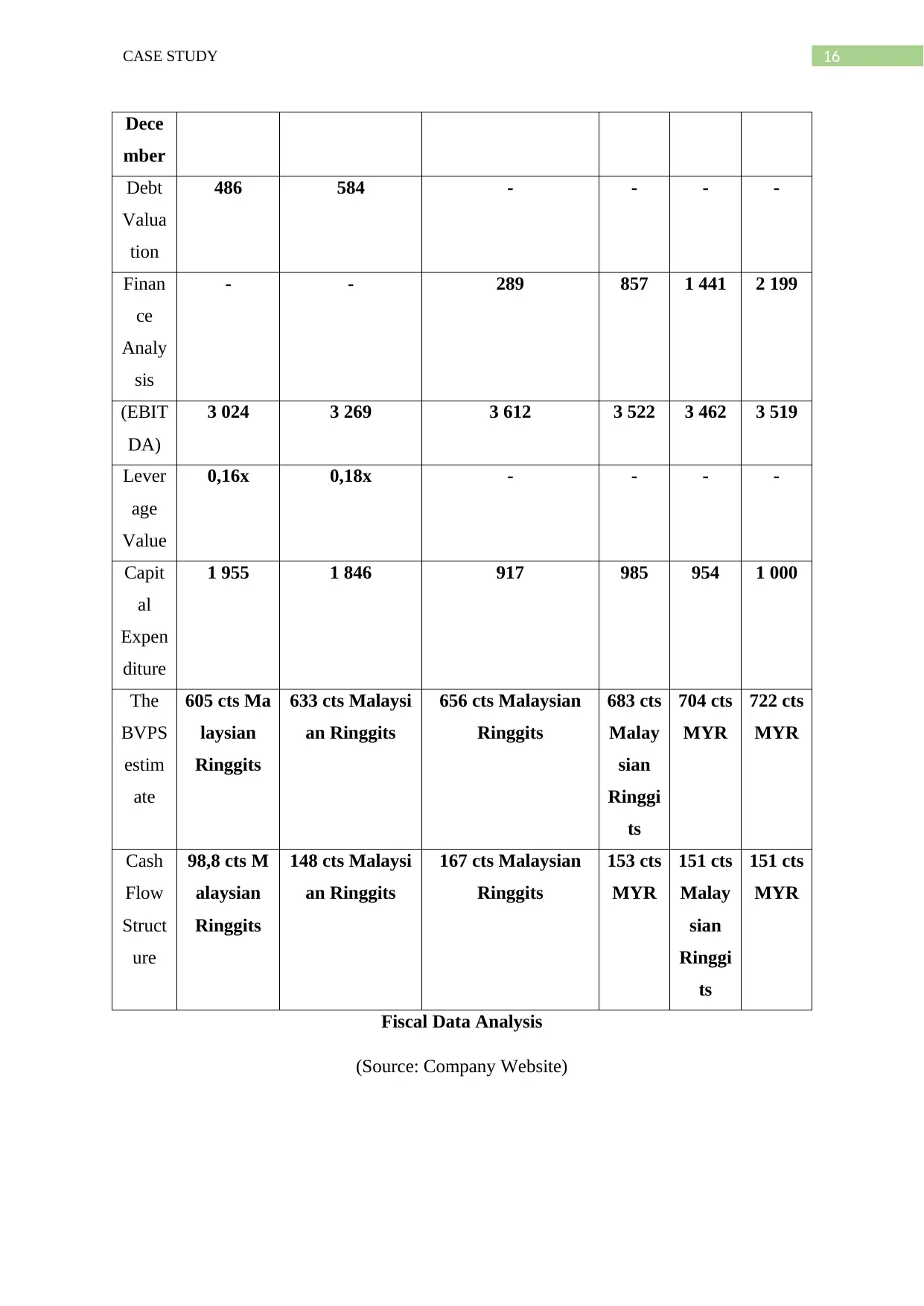
16CASE STUDY
Dece
mber
Debt
Valua
tion
486 584 - - - -
Finan
ce
Analy
sis
- - 289 857 1 441 2 199
(EBIT
DA)
3 024 3 269 3 612 3 522 3 462 3 519
Lever
age
Value
0,16x 0,18x - - - -
Capit
al
Expen
diture
1 955 1 846 917 985 954 1 000
The
BVPS
estim
ate
605 cts Ma
laysian
Ringgits
633 cts Malaysi
an Ringgits
656 cts Malaysian
Ringgits
683 cts
Malay
sian
Ringgi
ts
704 cts
MYR
722 cts
MYR
Cash
Flow
Struct
ure
98,8 cts M
alaysian
Ringgits
148 cts Malaysi
an Ringgits
167 cts Malaysian
Ringgits
153 cts
MYR
151 cts
Malay
sian
Ringgi
ts
151 cts
MYR
Fiscal Data Analysis
(Source: Company Website)
Dece
mber
Debt
Valua
tion
486 584 - - - -
Finan
ce
Analy
sis
- - 289 857 1 441 2 199
(EBIT
DA)
3 024 3 269 3 612 3 522 3 462 3 519
Lever
age
Value
0,16x 0,18x - - - -
Capit
al
Expen
diture
1 955 1 846 917 985 954 1 000
The
BVPS
estim
ate
605 cts Ma
laysian
Ringgits
633 cts Malaysi
an Ringgits
656 cts Malaysian
Ringgits
683 cts
Malay
sian
Ringgi
ts
704 cts
MYR
722 cts
MYR
Cash
Flow
Struct
ure
98,8 cts M
alaysian
Ringgits
148 cts Malaysi
an Ringgits
167 cts Malaysian
Ringgits
153 cts
MYR
151 cts
Malay
sian
Ringgi
ts
151 cts
MYR
Fiscal Data Analysis
(Source: Company Website)
Secure Best Marks with AI Grader
Need help grading? Try our AI Grader for instant feedback on your assignments.
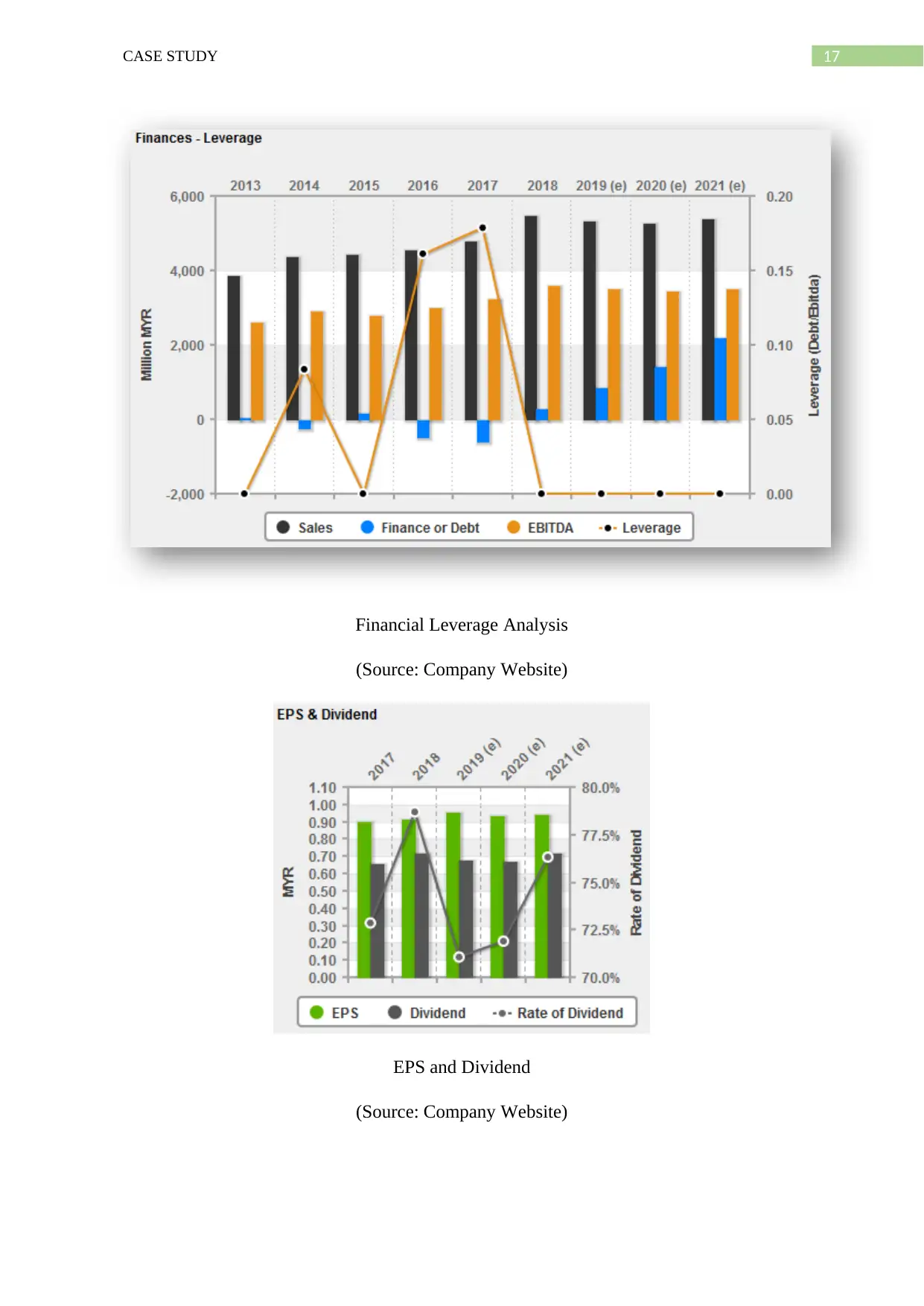
17CASE STUDY
Financial Leverage Analysis
(Source: Company Website)
EPS and Dividend
(Source: Company Website)
Financial Leverage Analysis
(Source: Company Website)
EPS and Dividend
(Source: Company Website)
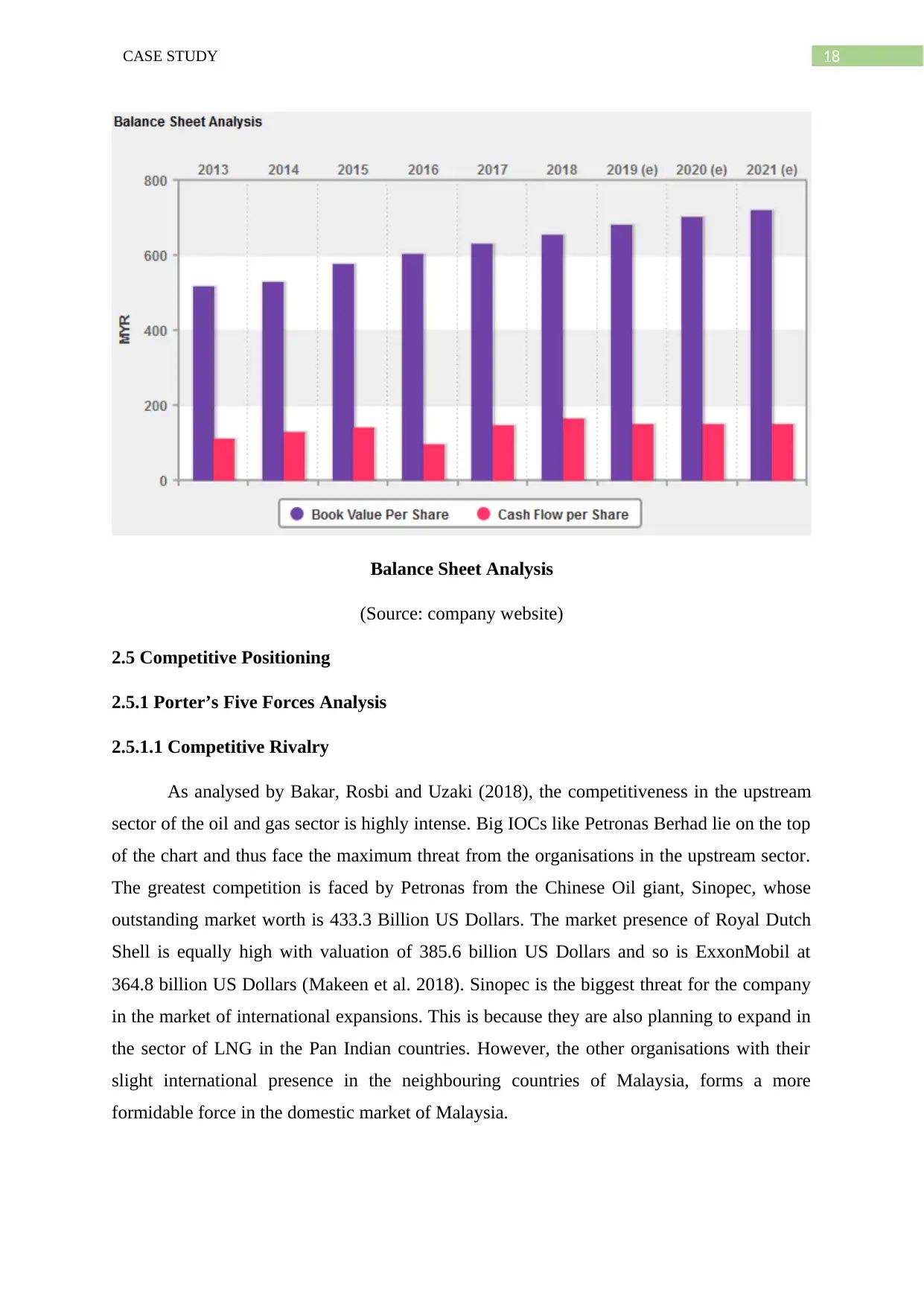
18CASE STUDY
Balance Sheet Analysis
(Source: company website)
2.5 Competitive Positioning
2.5.1 Porter’s Five Forces Analysis
2.5.1.1 Competitive Rivalry
As analysed by Bakar, Rosbi and Uzaki (2018), the competitiveness in the upstream
sector of the oil and gas sector is highly intense. Big IOCs like Petronas Berhad lie on the top
of the chart and thus face the maximum threat from the organisations in the upstream sector.
The greatest competition is faced by Petronas from the Chinese Oil giant, Sinopec, whose
outstanding market worth is 433.3 Billion US Dollars. The market presence of Royal Dutch
Shell is equally high with valuation of 385.6 billion US Dollars and so is ExxonMobil at
364.8 billion US Dollars (Makeen et al. 2018). Sinopec is the biggest threat for the company
in the market of international expansions. This is because they are also planning to expand in
the sector of LNG in the Pan Indian countries. However, the other organisations with their
slight international presence in the neighbouring countries of Malaysia, forms a more
formidable force in the domestic market of Malaysia.
Balance Sheet Analysis
(Source: company website)
2.5 Competitive Positioning
2.5.1 Porter’s Five Forces Analysis
2.5.1.1 Competitive Rivalry
As analysed by Bakar, Rosbi and Uzaki (2018), the competitiveness in the upstream
sector of the oil and gas sector is highly intense. Big IOCs like Petronas Berhad lie on the top
of the chart and thus face the maximum threat from the organisations in the upstream sector.
The greatest competition is faced by Petronas from the Chinese Oil giant, Sinopec, whose
outstanding market worth is 433.3 Billion US Dollars. The market presence of Royal Dutch
Shell is equally high with valuation of 385.6 billion US Dollars and so is ExxonMobil at
364.8 billion US Dollars (Makeen et al. 2018). Sinopec is the biggest threat for the company
in the market of international expansions. This is because they are also planning to expand in
the sector of LNG in the Pan Indian countries. However, the other organisations with their
slight international presence in the neighbouring countries of Malaysia, forms a more
formidable force in the domestic market of Malaysia.

19CASE STUDY
The internal market threat that Petronas faces from the existing competitors in
Malaysia is evident in the following graphical data presentation.
Image 1: Competitive Rivalry of Petronas in domestic and international market
(Source: Developed by the Researcher)
2.5.1.2 Threats of New Entrants
The lack of string distribution network of the organisation is a major factor that
intensifies the threat from the new entrants. The time as well as expense of making the goods
reach the market would be higher and as an impact, the price of the end products would
become higher. However, there are no substantial new entrant in the Malaysian market for the
last 5 years. This implies that the threat from the new market entrants is comparatively low.
Another important threat that needs to be considered is that the new market entrants
who have entered the market are all big brand names with considerable presence in the
international oil and gas sector. The entry of ExxonMobil had been a substantial example.
ExxonMobil impacted the market with a strong innovation in the line of advertising (Asad et
al. 2017). Although, there had been no immediate impact of the market entry of ExxonMobil
in the market, the market presence might become a matter of concern in the long run.
2.5.1.3 Threats of Substitution products
Threats of substitutes are of lower quality. Lower quality automatically implies that it is
unlikely that the customers would be switching on from Petronas to any other substitute
brand. Besides the cost of switching to a substitute is very high. This is because there is a
significant difference between the prices of the products of Petronas and that of the other
organisations of the oil and gas sector of Malaysia.
2.5.1 4 Bargaining power of Buyers
The internal market threat that Petronas faces from the existing competitors in
Malaysia is evident in the following graphical data presentation.
Image 1: Competitive Rivalry of Petronas in domestic and international market
(Source: Developed by the Researcher)
2.5.1.2 Threats of New Entrants
The lack of string distribution network of the organisation is a major factor that
intensifies the threat from the new entrants. The time as well as expense of making the goods
reach the market would be higher and as an impact, the price of the end products would
become higher. However, there are no substantial new entrant in the Malaysian market for the
last 5 years. This implies that the threat from the new market entrants is comparatively low.
Another important threat that needs to be considered is that the new market entrants
who have entered the market are all big brand names with considerable presence in the
international oil and gas sector. The entry of ExxonMobil had been a substantial example.
ExxonMobil impacted the market with a strong innovation in the line of advertising (Asad et
al. 2017). Although, there had been no immediate impact of the market entry of ExxonMobil
in the market, the market presence might become a matter of concern in the long run.
2.5.1.3 Threats of Substitution products
Threats of substitutes are of lower quality. Lower quality automatically implies that it is
unlikely that the customers would be switching on from Petronas to any other substitute
brand. Besides the cost of switching to a substitute is very high. This is because there is a
significant difference between the prices of the products of Petronas and that of the other
organisations of the oil and gas sector of Malaysia.
2.5.1 4 Bargaining power of Buyers
Paraphrase This Document
Need a fresh take? Get an instant paraphrase of this document with our AI Paraphraser
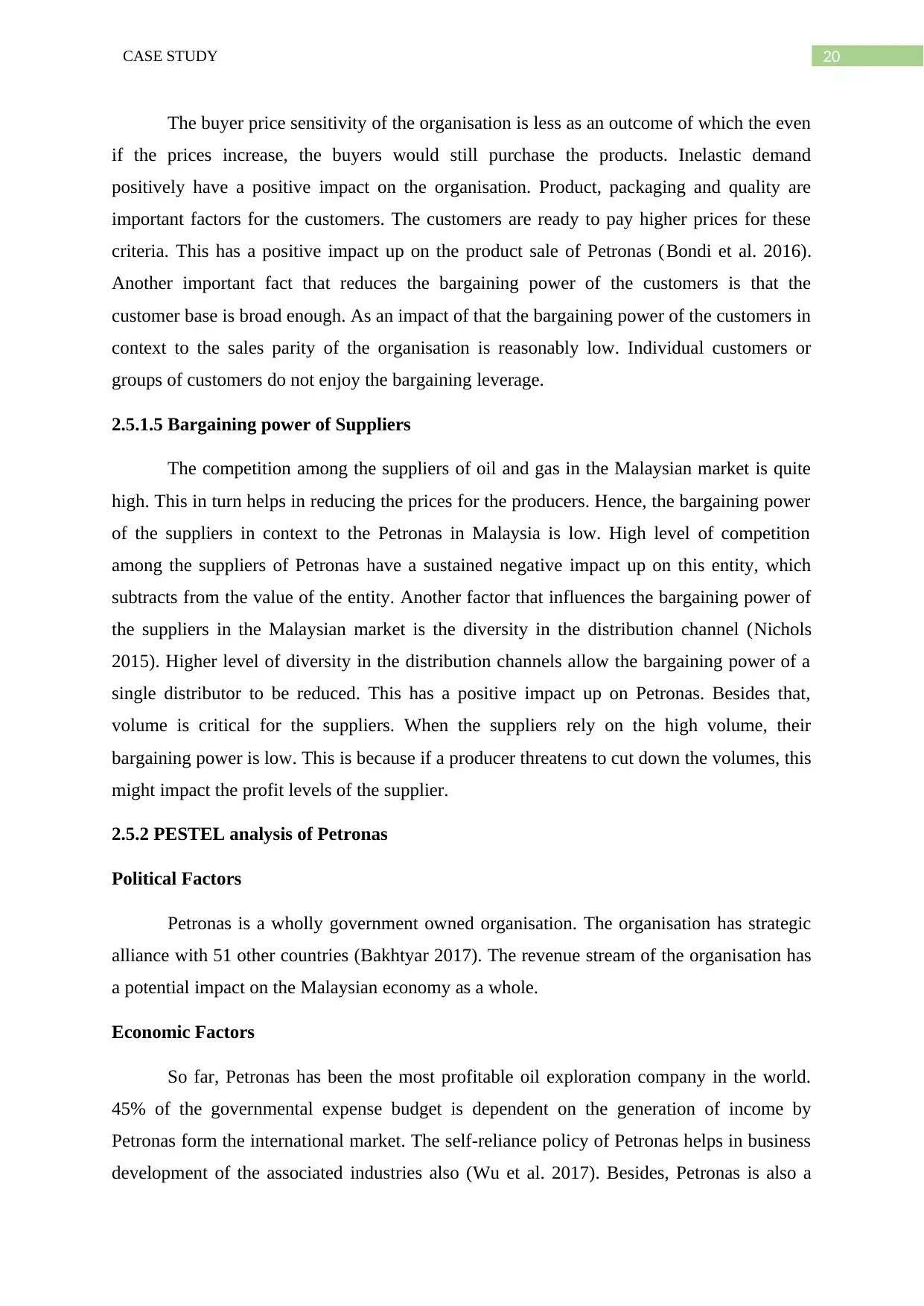
20CASE STUDY
The buyer price sensitivity of the organisation is less as an outcome of which the even
if the prices increase, the buyers would still purchase the products. Inelastic demand
positively have a positive impact on the organisation. Product, packaging and quality are
important factors for the customers. The customers are ready to pay higher prices for these
criteria. This has a positive impact up on the product sale of Petronas (Bondi et al. 2016).
Another important fact that reduces the bargaining power of the customers is that the
customer base is broad enough. As an impact of that the bargaining power of the customers in
context to the sales parity of the organisation is reasonably low. Individual customers or
groups of customers do not enjoy the bargaining leverage.
2.5.1.5 Bargaining power of Suppliers
The competition among the suppliers of oil and gas in the Malaysian market is quite
high. This in turn helps in reducing the prices for the producers. Hence, the bargaining power
of the suppliers in context to the Petronas in Malaysia is low. High level of competition
among the suppliers of Petronas have a sustained negative impact up on this entity, which
subtracts from the value of the entity. Another factor that influences the bargaining power of
the suppliers in the Malaysian market is the diversity in the distribution channel (Nichols
2015). Higher level of diversity in the distribution channels allow the bargaining power of a
single distributor to be reduced. This has a positive impact up on Petronas. Besides that,
volume is critical for the suppliers. When the suppliers rely on the high volume, their
bargaining power is low. This is because if a producer threatens to cut down the volumes, this
might impact the profit levels of the supplier.
2.5.2 PESTEL analysis of Petronas
Political Factors
Petronas is a wholly government owned organisation. The organisation has strategic
alliance with 51 other countries (Bakhtyar 2017). The revenue stream of the organisation has
a potential impact on the Malaysian economy as a whole.
Economic Factors
So far, Petronas has been the most profitable oil exploration company in the world.
45% of the governmental expense budget is dependent on the generation of income by
Petronas form the international market. The self-reliance policy of Petronas helps in business
development of the associated industries also (Wu et al. 2017). Besides, Petronas is also a
The buyer price sensitivity of the organisation is less as an outcome of which the even
if the prices increase, the buyers would still purchase the products. Inelastic demand
positively have a positive impact on the organisation. Product, packaging and quality are
important factors for the customers. The customers are ready to pay higher prices for these
criteria. This has a positive impact up on the product sale of Petronas (Bondi et al. 2016).
Another important fact that reduces the bargaining power of the customers is that the
customer base is broad enough. As an impact of that the bargaining power of the customers in
context to the sales parity of the organisation is reasonably low. Individual customers or
groups of customers do not enjoy the bargaining leverage.
2.5.1.5 Bargaining power of Suppliers
The competition among the suppliers of oil and gas in the Malaysian market is quite
high. This in turn helps in reducing the prices for the producers. Hence, the bargaining power
of the suppliers in context to the Petronas in Malaysia is low. High level of competition
among the suppliers of Petronas have a sustained negative impact up on this entity, which
subtracts from the value of the entity. Another factor that influences the bargaining power of
the suppliers in the Malaysian market is the diversity in the distribution channel (Nichols
2015). Higher level of diversity in the distribution channels allow the bargaining power of a
single distributor to be reduced. This has a positive impact up on Petronas. Besides that,
volume is critical for the suppliers. When the suppliers rely on the high volume, their
bargaining power is low. This is because if a producer threatens to cut down the volumes, this
might impact the profit levels of the supplier.
2.5.2 PESTEL analysis of Petronas
Political Factors
Petronas is a wholly government owned organisation. The organisation has strategic
alliance with 51 other countries (Bakhtyar 2017). The revenue stream of the organisation has
a potential impact on the Malaysian economy as a whole.
Economic Factors
So far, Petronas has been the most profitable oil exploration company in the world.
45% of the governmental expense budget is dependent on the generation of income by
Petronas form the international market. The self-reliance policy of Petronas helps in business
development of the associated industries also (Wu et al. 2017). Besides, Petronas is also a
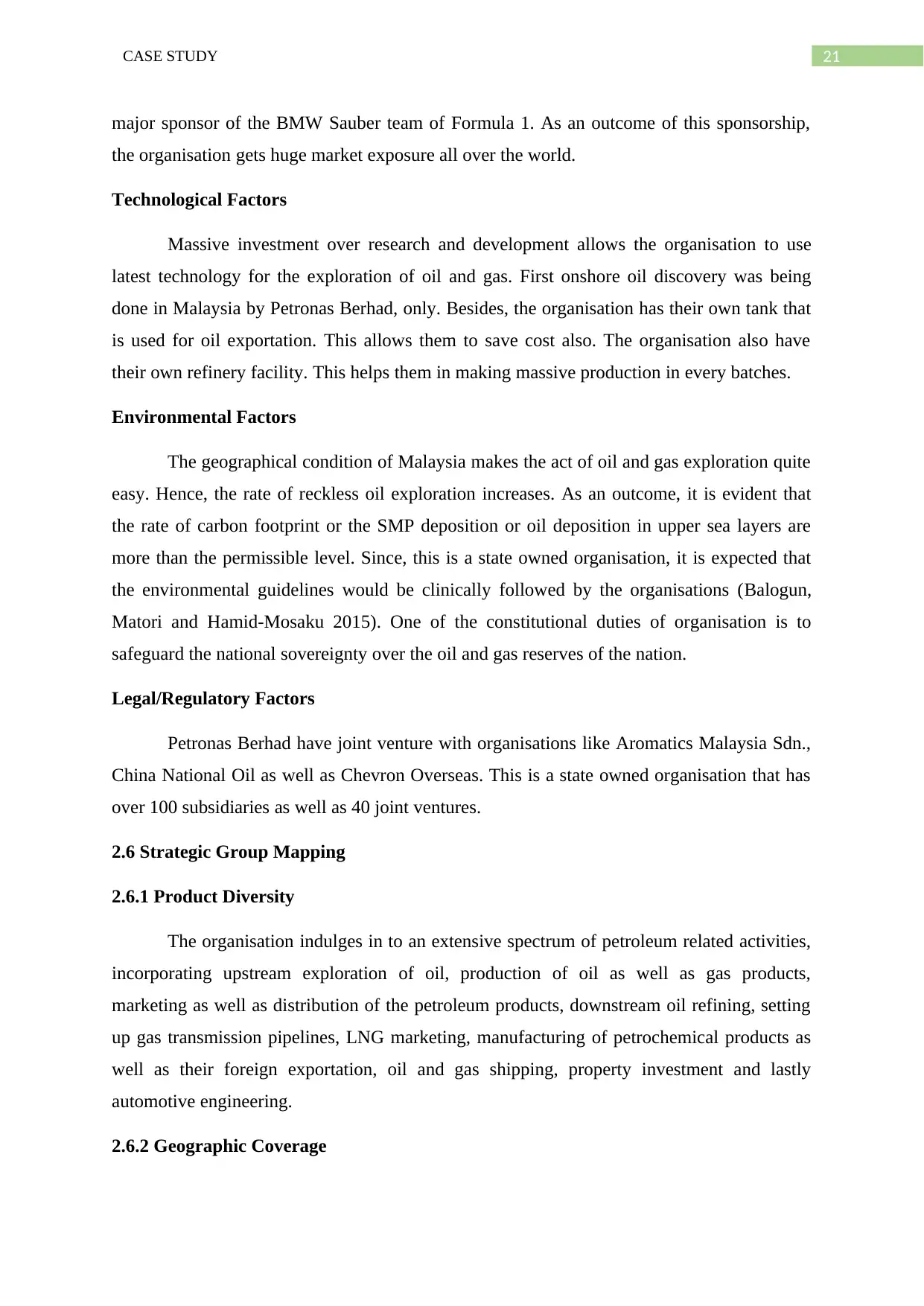
21CASE STUDY
major sponsor of the BMW Sauber team of Formula 1. As an outcome of this sponsorship,
the organisation gets huge market exposure all over the world.
Technological Factors
Massive investment over research and development allows the organisation to use
latest technology for the exploration of oil and gas. First onshore oil discovery was being
done in Malaysia by Petronas Berhad, only. Besides, the organisation has their own tank that
is used for oil exportation. This allows them to save cost also. The organisation also have
their own refinery facility. This helps them in making massive production in every batches.
Environmental Factors
The geographical condition of Malaysia makes the act of oil and gas exploration quite
easy. Hence, the rate of reckless oil exploration increases. As an outcome, it is evident that
the rate of carbon footprint or the SMP deposition or oil deposition in upper sea layers are
more than the permissible level. Since, this is a state owned organisation, it is expected that
the environmental guidelines would be clinically followed by the organisations (Balogun,
Matori and Hamid-Mosaku 2015). One of the constitutional duties of organisation is to
safeguard the national sovereignty over the oil and gas reserves of the nation.
Legal/Regulatory Factors
Petronas Berhad have joint venture with organisations like Aromatics Malaysia Sdn.,
China National Oil as well as Chevron Overseas. This is a state owned organisation that has
over 100 subsidiaries as well as 40 joint ventures.
2.6 Strategic Group Mapping
2.6.1 Product Diversity
The organisation indulges in to an extensive spectrum of petroleum related activities,
incorporating upstream exploration of oil, production of oil as well as gas products,
marketing as well as distribution of the petroleum products, downstream oil refining, setting
up gas transmission pipelines, LNG marketing, manufacturing of petrochemical products as
well as their foreign exportation, oil and gas shipping, property investment and lastly
automotive engineering.
2.6.2 Geographic Coverage
major sponsor of the BMW Sauber team of Formula 1. As an outcome of this sponsorship,
the organisation gets huge market exposure all over the world.
Technological Factors
Massive investment over research and development allows the organisation to use
latest technology for the exploration of oil and gas. First onshore oil discovery was being
done in Malaysia by Petronas Berhad, only. Besides, the organisation has their own tank that
is used for oil exportation. This allows them to save cost also. The organisation also have
their own refinery facility. This helps them in making massive production in every batches.
Environmental Factors
The geographical condition of Malaysia makes the act of oil and gas exploration quite
easy. Hence, the rate of reckless oil exploration increases. As an outcome, it is evident that
the rate of carbon footprint or the SMP deposition or oil deposition in upper sea layers are
more than the permissible level. Since, this is a state owned organisation, it is expected that
the environmental guidelines would be clinically followed by the organisations (Balogun,
Matori and Hamid-Mosaku 2015). One of the constitutional duties of organisation is to
safeguard the national sovereignty over the oil and gas reserves of the nation.
Legal/Regulatory Factors
Petronas Berhad have joint venture with organisations like Aromatics Malaysia Sdn.,
China National Oil as well as Chevron Overseas. This is a state owned organisation that has
over 100 subsidiaries as well as 40 joint ventures.
2.6 Strategic Group Mapping
2.6.1 Product Diversity
The organisation indulges in to an extensive spectrum of petroleum related activities,
incorporating upstream exploration of oil, production of oil as well as gas products,
marketing as well as distribution of the petroleum products, downstream oil refining, setting
up gas transmission pipelines, LNG marketing, manufacturing of petrochemical products as
well as their foreign exportation, oil and gas shipping, property investment and lastly
automotive engineering.
2.6.2 Geographic Coverage
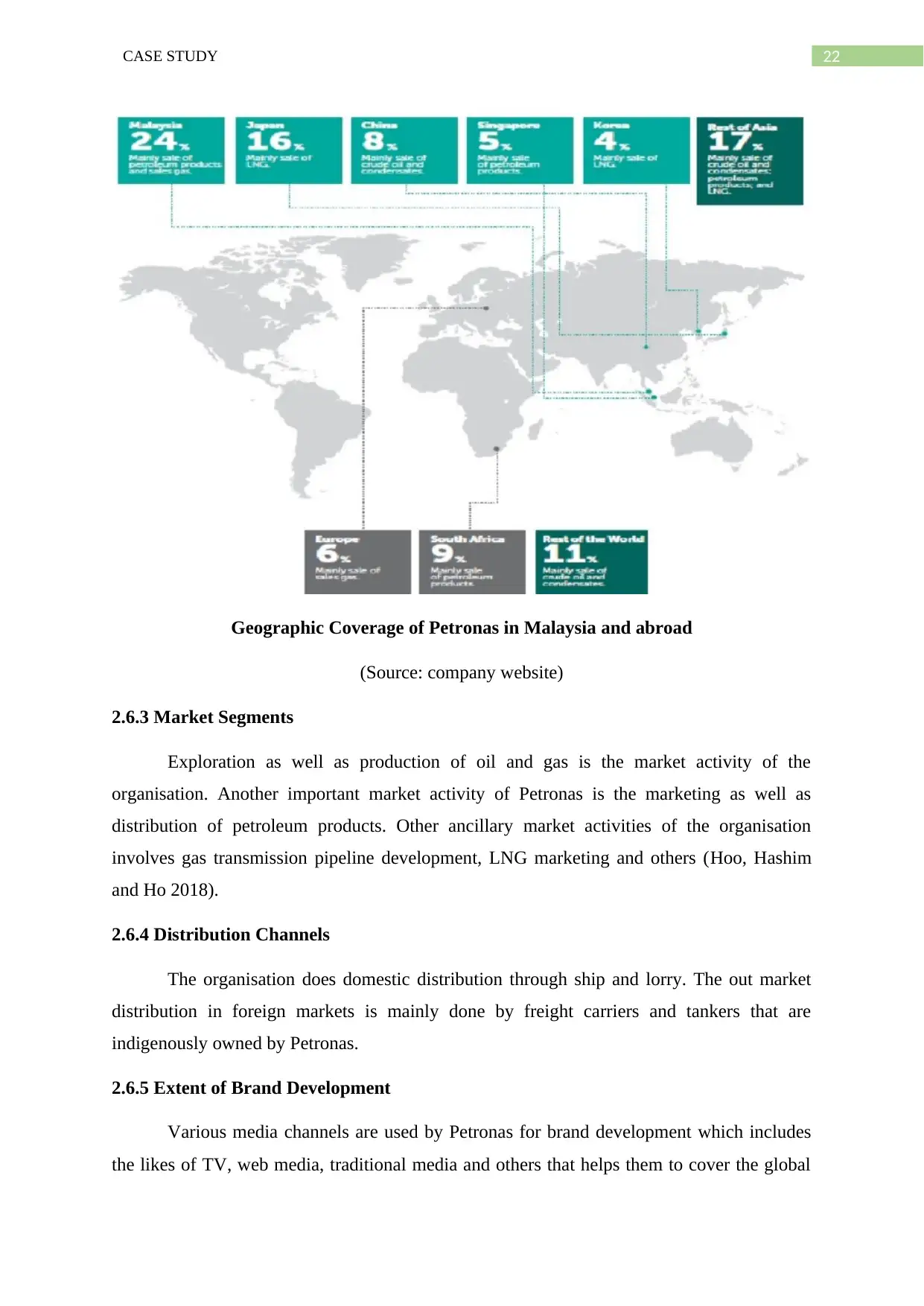
22CASE STUDY
Geographic Coverage of Petronas in Malaysia and abroad
(Source: company website)
2.6.3 Market Segments
Exploration as well as production of oil and gas is the market activity of the
organisation. Another important market activity of Petronas is the marketing as well as
distribution of petroleum products. Other ancillary market activities of the organisation
involves gas transmission pipeline development, LNG marketing and others (Hoo, Hashim
and Ho 2018).
2.6.4 Distribution Channels
The organisation does domestic distribution through ship and lorry. The out market
distribution in foreign markets is mainly done by freight carriers and tankers that are
indigenously owned by Petronas.
2.6.5 Extent of Brand Development
Various media channels are used by Petronas for brand development which includes
the likes of TV, web media, traditional media and others that helps them to cover the global
Geographic Coverage of Petronas in Malaysia and abroad
(Source: company website)
2.6.3 Market Segments
Exploration as well as production of oil and gas is the market activity of the
organisation. Another important market activity of Petronas is the marketing as well as
distribution of petroleum products. Other ancillary market activities of the organisation
involves gas transmission pipeline development, LNG marketing and others (Hoo, Hashim
and Ho 2018).
2.6.4 Distribution Channels
The organisation does domestic distribution through ship and lorry. The out market
distribution in foreign markets is mainly done by freight carriers and tankers that are
indigenously owned by Petronas.
2.6.5 Extent of Brand Development
Various media channels are used by Petronas for brand development which includes
the likes of TV, web media, traditional media and others that helps them to cover the global
Secure Best Marks with AI Grader
Need help grading? Try our AI Grader for instant feedback on your assignments.
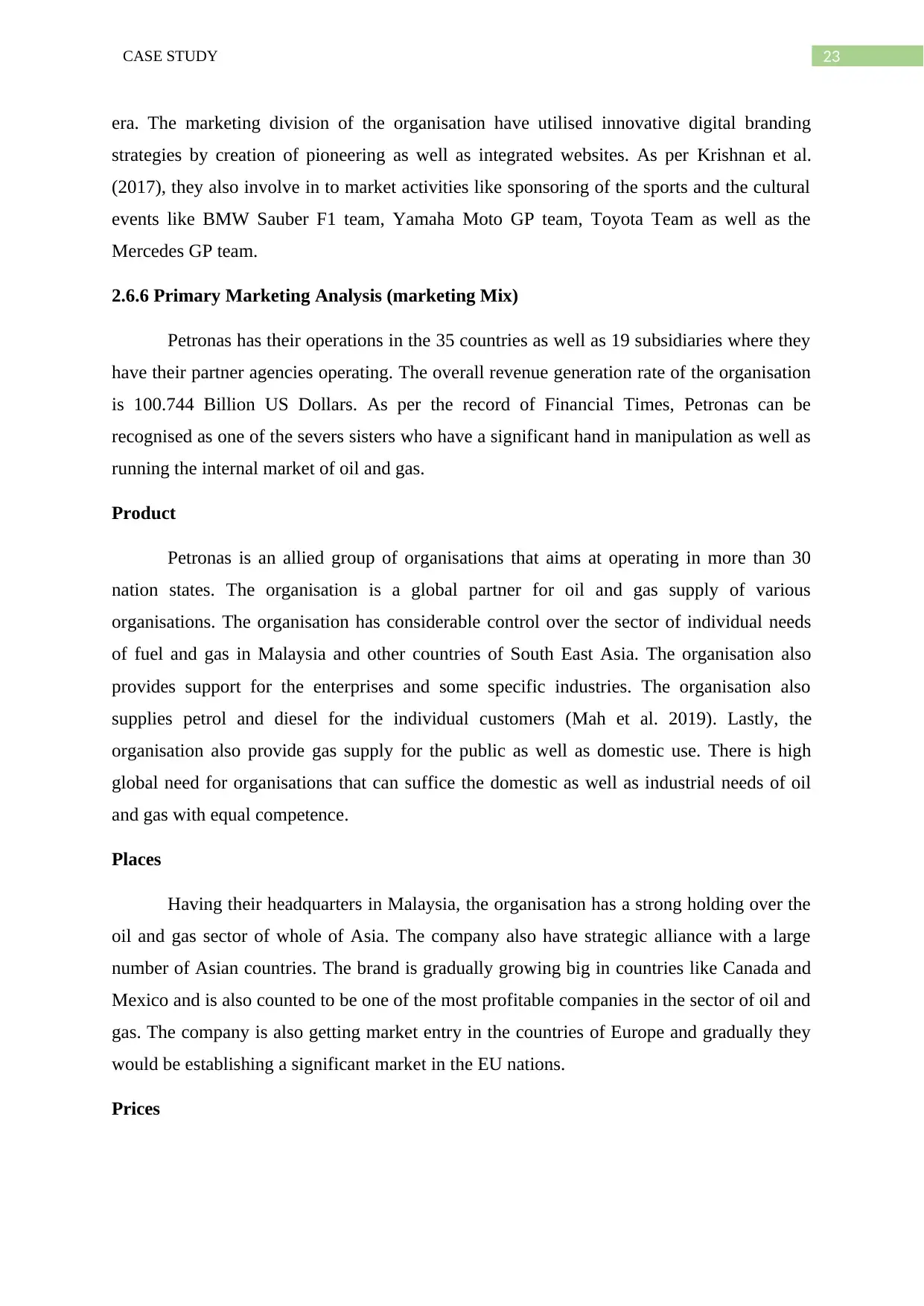
23CASE STUDY
era. The marketing division of the organisation have utilised innovative digital branding
strategies by creation of pioneering as well as integrated websites. As per Krishnan et al.
(2017), they also involve in to market activities like sponsoring of the sports and the cultural
events like BMW Sauber F1 team, Yamaha Moto GP team, Toyota Team as well as the
Mercedes GP team.
2.6.6 Primary Marketing Analysis (marketing Mix)
Petronas has their operations in the 35 countries as well as 19 subsidiaries where they
have their partner agencies operating. The overall revenue generation rate of the organisation
is 100.744 Billion US Dollars. As per the record of Financial Times, Petronas can be
recognised as one of the severs sisters who have a significant hand in manipulation as well as
running the internal market of oil and gas.
Product
Petronas is an allied group of organisations that aims at operating in more than 30
nation states. The organisation is a global partner for oil and gas supply of various
organisations. The organisation has considerable control over the sector of individual needs
of fuel and gas in Malaysia and other countries of South East Asia. The organisation also
provides support for the enterprises and some specific industries. The organisation also
supplies petrol and diesel for the individual customers (Mah et al. 2019). Lastly, the
organisation also provide gas supply for the public as well as domestic use. There is high
global need for organisations that can suffice the domestic as well as industrial needs of oil
and gas with equal competence.
Places
Having their headquarters in Malaysia, the organisation has a strong holding over the
oil and gas sector of whole of Asia. The company also have strategic alliance with a large
number of Asian countries. The brand is gradually growing big in countries like Canada and
Mexico and is also counted to be one of the most profitable companies in the sector of oil and
gas. The company is also getting market entry in the countries of Europe and gradually they
would be establishing a significant market in the EU nations.
Prices
era. The marketing division of the organisation have utilised innovative digital branding
strategies by creation of pioneering as well as integrated websites. As per Krishnan et al.
(2017), they also involve in to market activities like sponsoring of the sports and the cultural
events like BMW Sauber F1 team, Yamaha Moto GP team, Toyota Team as well as the
Mercedes GP team.
2.6.6 Primary Marketing Analysis (marketing Mix)
Petronas has their operations in the 35 countries as well as 19 subsidiaries where they
have their partner agencies operating. The overall revenue generation rate of the organisation
is 100.744 Billion US Dollars. As per the record of Financial Times, Petronas can be
recognised as one of the severs sisters who have a significant hand in manipulation as well as
running the internal market of oil and gas.
Product
Petronas is an allied group of organisations that aims at operating in more than 30
nation states. The organisation is a global partner for oil and gas supply of various
organisations. The organisation has considerable control over the sector of individual needs
of fuel and gas in Malaysia and other countries of South East Asia. The organisation also
provides support for the enterprises and some specific industries. The organisation also
supplies petrol and diesel for the individual customers (Mah et al. 2019). Lastly, the
organisation also provide gas supply for the public as well as domestic use. There is high
global need for organisations that can suffice the domestic as well as industrial needs of oil
and gas with equal competence.
Places
Having their headquarters in Malaysia, the organisation has a strong holding over the
oil and gas sector of whole of Asia. The company also have strategic alliance with a large
number of Asian countries. The brand is gradually growing big in countries like Canada and
Mexico and is also counted to be one of the most profitable companies in the sector of oil and
gas. The company is also getting market entry in the countries of Europe and gradually they
would be establishing a significant market in the EU nations.
Prices
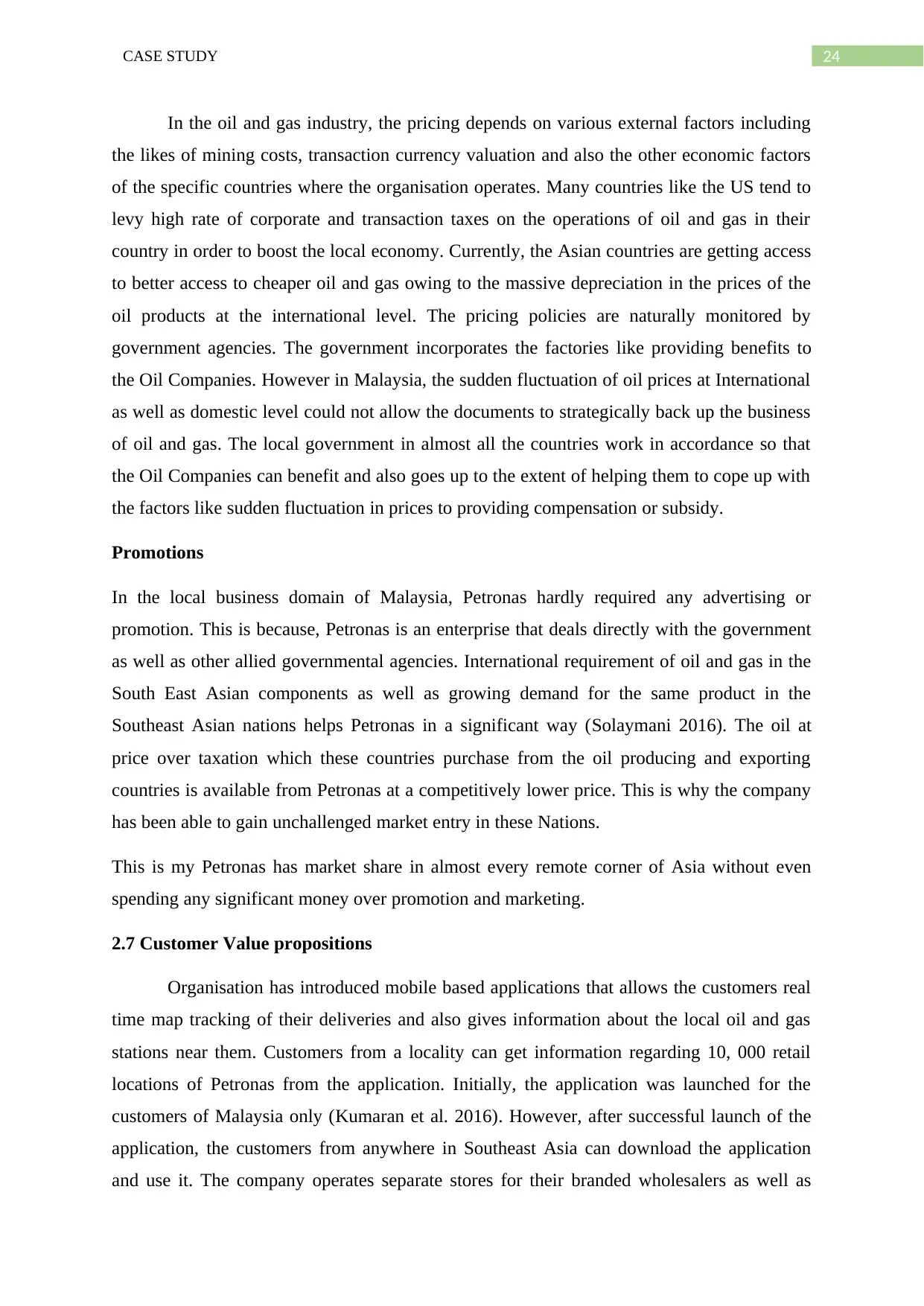
24CASE STUDY
In the oil and gas industry, the pricing depends on various external factors including
the likes of mining costs, transaction currency valuation and also the other economic factors
of the specific countries where the organisation operates. Many countries like the US tend to
levy high rate of corporate and transaction taxes on the operations of oil and gas in their
country in order to boost the local economy. Currently, the Asian countries are getting access
to better access to cheaper oil and gas owing to the massive depreciation in the prices of the
oil products at the international level. The pricing policies are naturally monitored by
government agencies. The government incorporates the factories like providing benefits to
the Oil Companies. However in Malaysia, the sudden fluctuation of oil prices at International
as well as domestic level could not allow the documents to strategically back up the business
of oil and gas. The local government in almost all the countries work in accordance so that
the Oil Companies can benefit and also goes up to the extent of helping them to cope up with
the factors like sudden fluctuation in prices to providing compensation or subsidy.
Promotions
In the local business domain of Malaysia, Petronas hardly required any advertising or
promotion. This is because, Petronas is an enterprise that deals directly with the government
as well as other allied governmental agencies. International requirement of oil and gas in the
South East Asian components as well as growing demand for the same product in the
Southeast Asian nations helps Petronas in a significant way (Solaymani 2016). The oil at
price over taxation which these countries purchase from the oil producing and exporting
countries is available from Petronas at a competitively lower price. This is why the company
has been able to gain unchallenged market entry in these Nations.
This is my Petronas has market share in almost every remote corner of Asia without even
spending any significant money over promotion and marketing.
2.7 Customer Value propositions
Organisation has introduced mobile based applications that allows the customers real
time map tracking of their deliveries and also gives information about the local oil and gas
stations near them. Customers from a locality can get information regarding 10, 000 retail
locations of Petronas from the application. Initially, the application was launched for the
customers of Malaysia only (Kumaran et al. 2016). However, after successful launch of the
application, the customers from anywhere in Southeast Asia can download the application
and use it. The company operates separate stores for their branded wholesalers as well as
In the oil and gas industry, the pricing depends on various external factors including
the likes of mining costs, transaction currency valuation and also the other economic factors
of the specific countries where the organisation operates. Many countries like the US tend to
levy high rate of corporate and transaction taxes on the operations of oil and gas in their
country in order to boost the local economy. Currently, the Asian countries are getting access
to better access to cheaper oil and gas owing to the massive depreciation in the prices of the
oil products at the international level. The pricing policies are naturally monitored by
government agencies. The government incorporates the factories like providing benefits to
the Oil Companies. However in Malaysia, the sudden fluctuation of oil prices at International
as well as domestic level could not allow the documents to strategically back up the business
of oil and gas. The local government in almost all the countries work in accordance so that
the Oil Companies can benefit and also goes up to the extent of helping them to cope up with
the factors like sudden fluctuation in prices to providing compensation or subsidy.
Promotions
In the local business domain of Malaysia, Petronas hardly required any advertising or
promotion. This is because, Petronas is an enterprise that deals directly with the government
as well as other allied governmental agencies. International requirement of oil and gas in the
South East Asian components as well as growing demand for the same product in the
Southeast Asian nations helps Petronas in a significant way (Solaymani 2016). The oil at
price over taxation which these countries purchase from the oil producing and exporting
countries is available from Petronas at a competitively lower price. This is why the company
has been able to gain unchallenged market entry in these Nations.
This is my Petronas has market share in almost every remote corner of Asia without even
spending any significant money over promotion and marketing.
2.7 Customer Value propositions
Organisation has introduced mobile based applications that allows the customers real
time map tracking of their deliveries and also gives information about the local oil and gas
stations near them. Customers from a locality can get information regarding 10, 000 retail
locations of Petronas from the application. Initially, the application was launched for the
customers of Malaysia only (Kumaran et al. 2016). However, after successful launch of the
application, the customers from anywhere in Southeast Asia can download the application
and use it. The company operates separate stores for their branded wholesalers as well as
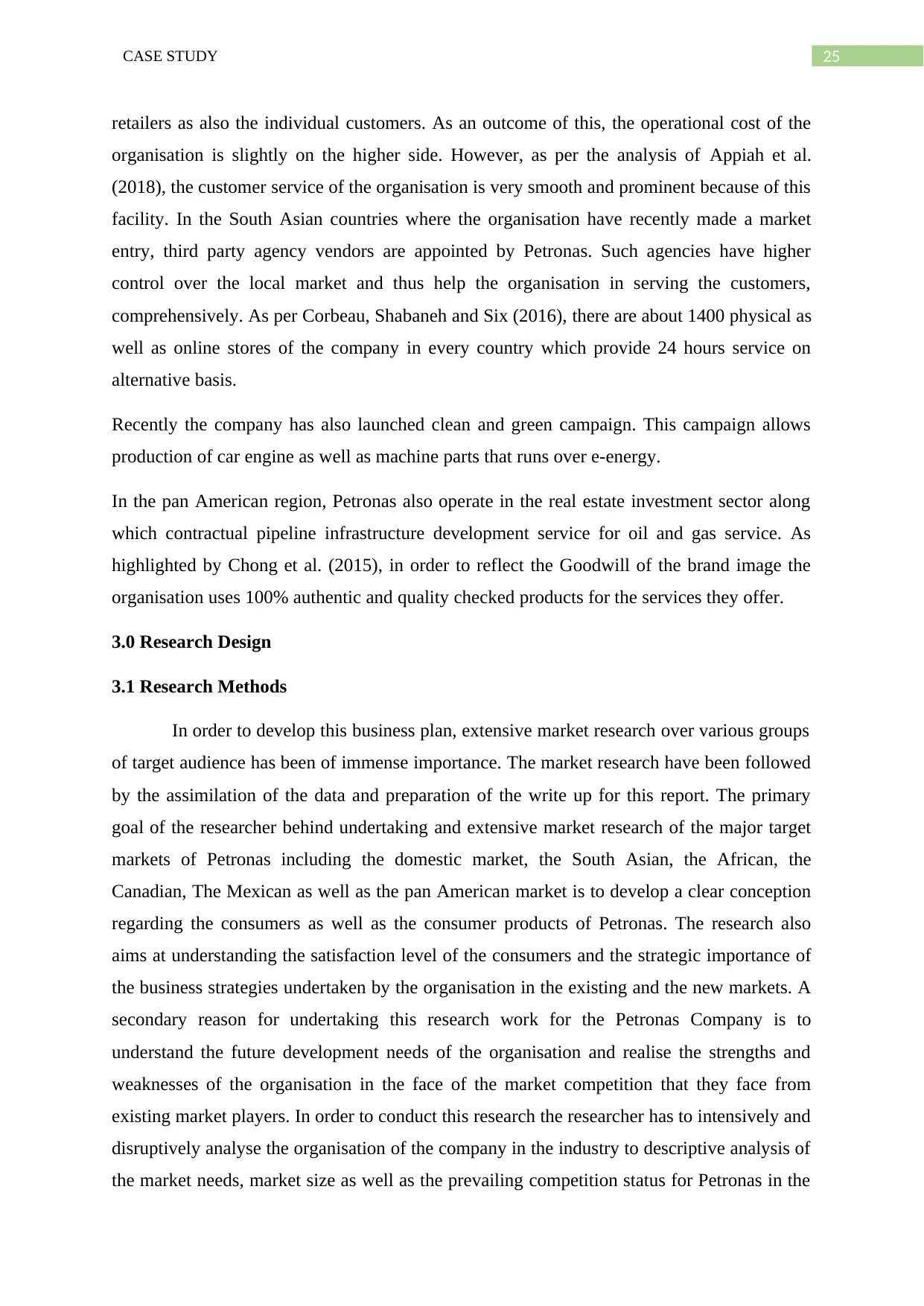
25CASE STUDY
retailers as also the individual customers. As an outcome of this, the operational cost of the
organisation is slightly on the higher side. However, as per the analysis of Appiah et al.
(2018), the customer service of the organisation is very smooth and prominent because of this
facility. In the South Asian countries where the organisation have recently made a market
entry, third party agency vendors are appointed by Petronas. Such agencies have higher
control over the local market and thus help the organisation in serving the customers,
comprehensively. As per Corbeau, Shabaneh and Six (2016), there are about 1400 physical as
well as online stores of the company in every country which provide 24 hours service on
alternative basis.
Recently the company has also launched clean and green campaign. This campaign allows
production of car engine as well as machine parts that runs over e-energy.
In the pan American region, Petronas also operate in the real estate investment sector along
which contractual pipeline infrastructure development service for oil and gas service. As
highlighted by Chong et al. (2015), in order to reflect the Goodwill of the brand image the
organisation uses 100% authentic and quality checked products for the services they offer.
3.0 Research Design
3.1 Research Methods
In order to develop this business plan, extensive market research over various groups
of target audience has been of immense importance. The market research have been followed
by the assimilation of the data and preparation of the write up for this report. The primary
goal of the researcher behind undertaking and extensive market research of the major target
markets of Petronas including the domestic market, the South Asian, the African, the
Canadian, The Mexican as well as the pan American market is to develop a clear conception
regarding the consumers as well as the consumer products of Petronas. The research also
aims at understanding the satisfaction level of the consumers and the strategic importance of
the business strategies undertaken by the organisation in the existing and the new markets. A
secondary reason for undertaking this research work for the Petronas Company is to
understand the future development needs of the organisation and realise the strengths and
weaknesses of the organisation in the face of the market competition that they face from
existing market players. In order to conduct this research the researcher has to intensively and
disruptively analyse the organisation of the company in the industry to descriptive analysis of
the market needs, market size as well as the prevailing competition status for Petronas in the
retailers as also the individual customers. As an outcome of this, the operational cost of the
organisation is slightly on the higher side. However, as per the analysis of Appiah et al.
(2018), the customer service of the organisation is very smooth and prominent because of this
facility. In the South Asian countries where the organisation have recently made a market
entry, third party agency vendors are appointed by Petronas. Such agencies have higher
control over the local market and thus help the organisation in serving the customers,
comprehensively. As per Corbeau, Shabaneh and Six (2016), there are about 1400 physical as
well as online stores of the company in every country which provide 24 hours service on
alternative basis.
Recently the company has also launched clean and green campaign. This campaign allows
production of car engine as well as machine parts that runs over e-energy.
In the pan American region, Petronas also operate in the real estate investment sector along
which contractual pipeline infrastructure development service for oil and gas service. As
highlighted by Chong et al. (2015), in order to reflect the Goodwill of the brand image the
organisation uses 100% authentic and quality checked products for the services they offer.
3.0 Research Design
3.1 Research Methods
In order to develop this business plan, extensive market research over various groups
of target audience has been of immense importance. The market research have been followed
by the assimilation of the data and preparation of the write up for this report. The primary
goal of the researcher behind undertaking and extensive market research of the major target
markets of Petronas including the domestic market, the South Asian, the African, the
Canadian, The Mexican as well as the pan American market is to develop a clear conception
regarding the consumers as well as the consumer products of Petronas. The research also
aims at understanding the satisfaction level of the consumers and the strategic importance of
the business strategies undertaken by the organisation in the existing and the new markets. A
secondary reason for undertaking this research work for the Petronas Company is to
understand the future development needs of the organisation and realise the strengths and
weaknesses of the organisation in the face of the market competition that they face from
existing market players. In order to conduct this research the researcher has to intensively and
disruptively analyse the organisation of the company in the industry to descriptive analysis of
the market needs, market size as well as the prevailing competition status for Petronas in the
Paraphrase This Document
Need a fresh take? Get an instant paraphrase of this document with our AI Paraphraser
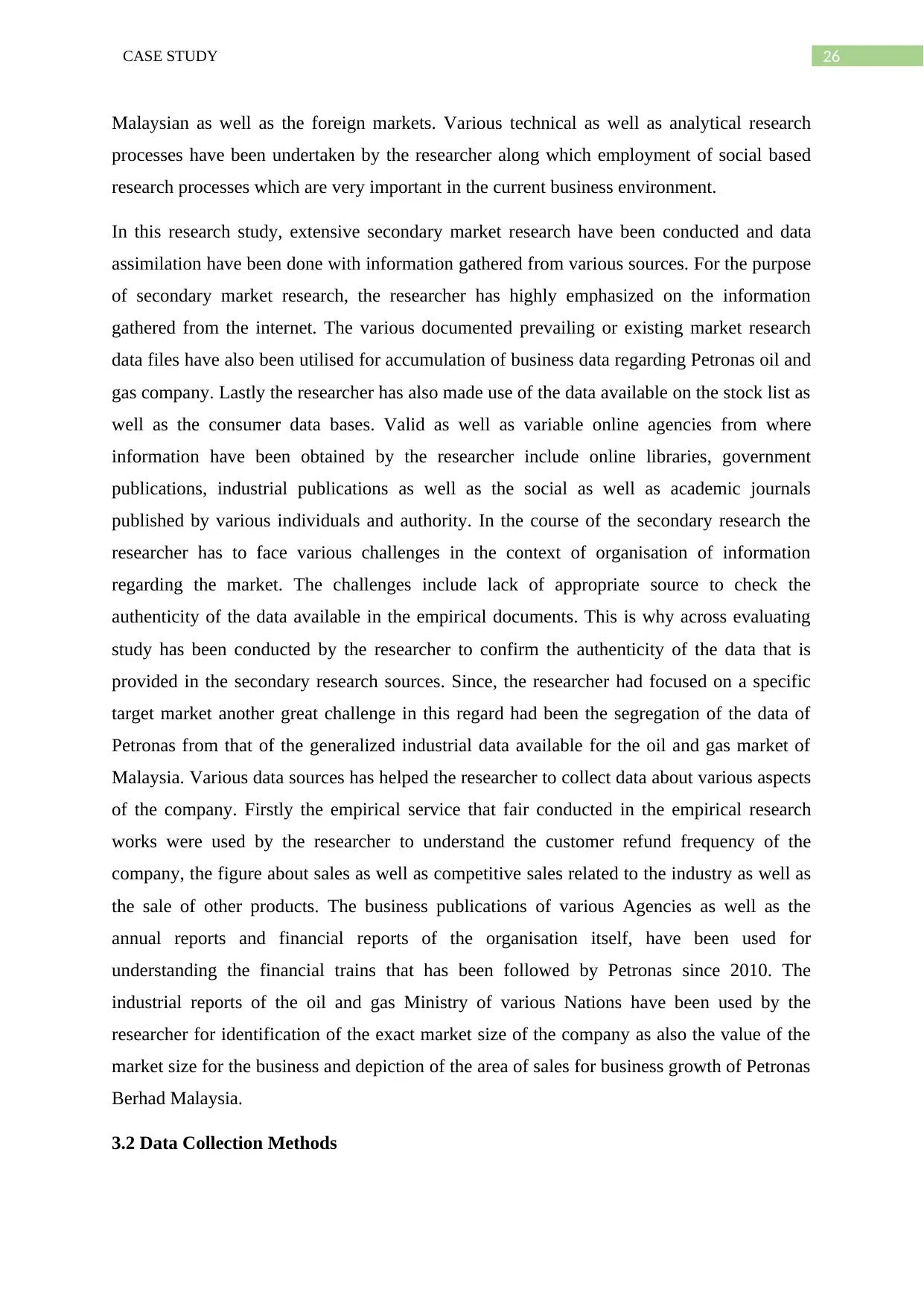
26CASE STUDY
Malaysian as well as the foreign markets. Various technical as well as analytical research
processes have been undertaken by the researcher along which employment of social based
research processes which are very important in the current business environment.
In this research study, extensive secondary market research have been conducted and data
assimilation have been done with information gathered from various sources. For the purpose
of secondary market research, the researcher has highly emphasized on the information
gathered from the internet. The various documented prevailing or existing market research
data files have also been utilised for accumulation of business data regarding Petronas oil and
gas company. Lastly the researcher has also made use of the data available on the stock list as
well as the consumer data bases. Valid as well as variable online agencies from where
information have been obtained by the researcher include online libraries, government
publications, industrial publications as well as the social as well as academic journals
published by various individuals and authority. In the course of the secondary research the
researcher has to face various challenges in the context of organisation of information
regarding the market. The challenges include lack of appropriate source to check the
authenticity of the data available in the empirical documents. This is why across evaluating
study has been conducted by the researcher to confirm the authenticity of the data that is
provided in the secondary research sources. Since, the researcher had focused on a specific
target market another great challenge in this regard had been the segregation of the data of
Petronas from that of the generalized industrial data available for the oil and gas market of
Malaysia. Various data sources has helped the researcher to collect data about various aspects
of the company. Firstly the empirical service that fair conducted in the empirical research
works were used by the researcher to understand the customer refund frequency of the
company, the figure about sales as well as competitive sales related to the industry as well as
the sale of other products. The business publications of various Agencies as well as the
annual reports and financial reports of the organisation itself, have been used for
understanding the financial trains that has been followed by Petronas since 2010. The
industrial reports of the oil and gas Ministry of various Nations have been used by the
researcher for identification of the exact market size of the company as also the value of the
market size for the business and depiction of the area of sales for business growth of Petronas
Berhad Malaysia.
3.2 Data Collection Methods
Malaysian as well as the foreign markets. Various technical as well as analytical research
processes have been undertaken by the researcher along which employment of social based
research processes which are very important in the current business environment.
In this research study, extensive secondary market research have been conducted and data
assimilation have been done with information gathered from various sources. For the purpose
of secondary market research, the researcher has highly emphasized on the information
gathered from the internet. The various documented prevailing or existing market research
data files have also been utilised for accumulation of business data regarding Petronas oil and
gas company. Lastly the researcher has also made use of the data available on the stock list as
well as the consumer data bases. Valid as well as variable online agencies from where
information have been obtained by the researcher include online libraries, government
publications, industrial publications as well as the social as well as academic journals
published by various individuals and authority. In the course of the secondary research the
researcher has to face various challenges in the context of organisation of information
regarding the market. The challenges include lack of appropriate source to check the
authenticity of the data available in the empirical documents. This is why across evaluating
study has been conducted by the researcher to confirm the authenticity of the data that is
provided in the secondary research sources. Since, the researcher had focused on a specific
target market another great challenge in this regard had been the segregation of the data of
Petronas from that of the generalized industrial data available for the oil and gas market of
Malaysia. Various data sources has helped the researcher to collect data about various aspects
of the company. Firstly the empirical service that fair conducted in the empirical research
works were used by the researcher to understand the customer refund frequency of the
company, the figure about sales as well as competitive sales related to the industry as well as
the sale of other products. The business publications of various Agencies as well as the
annual reports and financial reports of the organisation itself, have been used for
understanding the financial trains that has been followed by Petronas since 2010. The
industrial reports of the oil and gas Ministry of various Nations have been used by the
researcher for identification of the exact market size of the company as also the value of the
market size for the business and depiction of the area of sales for business growth of Petronas
Berhad Malaysia.
3.2 Data Collection Methods
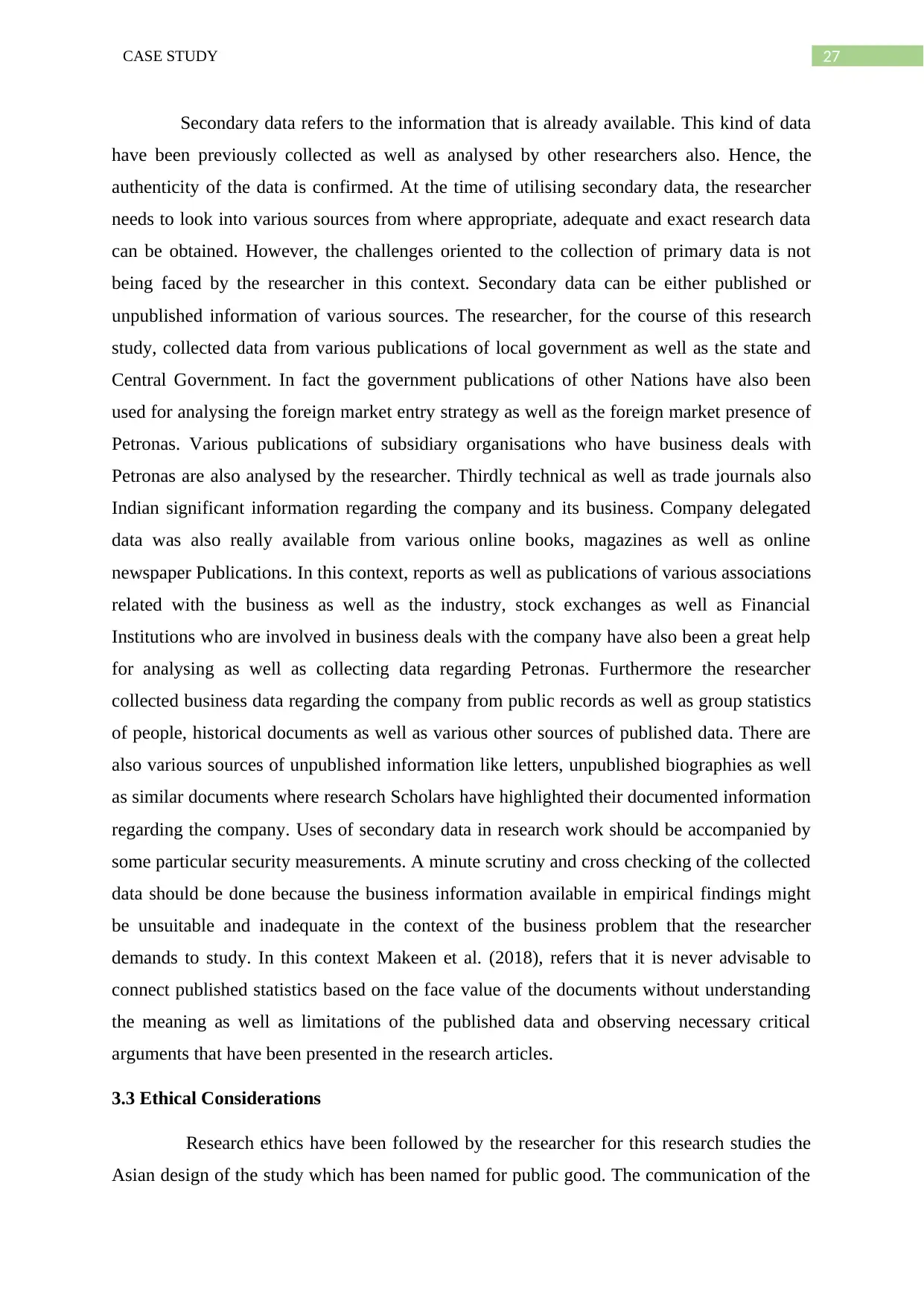
27CASE STUDY
Secondary data refers to the information that is already available. This kind of data
have been previously collected as well as analysed by other researchers also. Hence, the
authenticity of the data is confirmed. At the time of utilising secondary data, the researcher
needs to look into various sources from where appropriate, adequate and exact research data
can be obtained. However, the challenges oriented to the collection of primary data is not
being faced by the researcher in this context. Secondary data can be either published or
unpublished information of various sources. The researcher, for the course of this research
study, collected data from various publications of local government as well as the state and
Central Government. In fact the government publications of other Nations have also been
used for analysing the foreign market entry strategy as well as the foreign market presence of
Petronas. Various publications of subsidiary organisations who have business deals with
Petronas are also analysed by the researcher. Thirdly technical as well as trade journals also
Indian significant information regarding the company and its business. Company delegated
data was also really available from various online books, magazines as well as online
newspaper Publications. In this context, reports as well as publications of various associations
related with the business as well as the industry, stock exchanges as well as Financial
Institutions who are involved in business deals with the company have also been a great help
for analysing as well as collecting data regarding Petronas. Furthermore the researcher
collected business data regarding the company from public records as well as group statistics
of people, historical documents as well as various other sources of published data. There are
also various sources of unpublished information like letters, unpublished biographies as well
as similar documents where research Scholars have highlighted their documented information
regarding the company. Uses of secondary data in research work should be accompanied by
some particular security measurements. A minute scrutiny and cross checking of the collected
data should be done because the business information available in empirical findings might
be unsuitable and inadequate in the context of the business problem that the researcher
demands to study. In this context Makeen et al. (2018), refers that it is never advisable to
connect published statistics based on the face value of the documents without understanding
the meaning as well as limitations of the published data and observing necessary critical
arguments that have been presented in the research articles.
3.3 Ethical Considerations
Research ethics have been followed by the researcher for this research studies the
Asian design of the study which has been named for public good. The communication of the
Secondary data refers to the information that is already available. This kind of data
have been previously collected as well as analysed by other researchers also. Hence, the
authenticity of the data is confirmed. At the time of utilising secondary data, the researcher
needs to look into various sources from where appropriate, adequate and exact research data
can be obtained. However, the challenges oriented to the collection of primary data is not
being faced by the researcher in this context. Secondary data can be either published or
unpublished information of various sources. The researcher, for the course of this research
study, collected data from various publications of local government as well as the state and
Central Government. In fact the government publications of other Nations have also been
used for analysing the foreign market entry strategy as well as the foreign market presence of
Petronas. Various publications of subsidiary organisations who have business deals with
Petronas are also analysed by the researcher. Thirdly technical as well as trade journals also
Indian significant information regarding the company and its business. Company delegated
data was also really available from various online books, magazines as well as online
newspaper Publications. In this context, reports as well as publications of various associations
related with the business as well as the industry, stock exchanges as well as Financial
Institutions who are involved in business deals with the company have also been a great help
for analysing as well as collecting data regarding Petronas. Furthermore the researcher
collected business data regarding the company from public records as well as group statistics
of people, historical documents as well as various other sources of published data. There are
also various sources of unpublished information like letters, unpublished biographies as well
as similar documents where research Scholars have highlighted their documented information
regarding the company. Uses of secondary data in research work should be accompanied by
some particular security measurements. A minute scrutiny and cross checking of the collected
data should be done because the business information available in empirical findings might
be unsuitable and inadequate in the context of the business problem that the researcher
demands to study. In this context Makeen et al. (2018), refers that it is never advisable to
connect published statistics based on the face value of the documents without understanding
the meaning as well as limitations of the published data and observing necessary critical
arguments that have been presented in the research articles.
3.3 Ethical Considerations
Research ethics have been followed by the researcher for this research studies the
Asian design of the study which has been named for public good. The communication of the
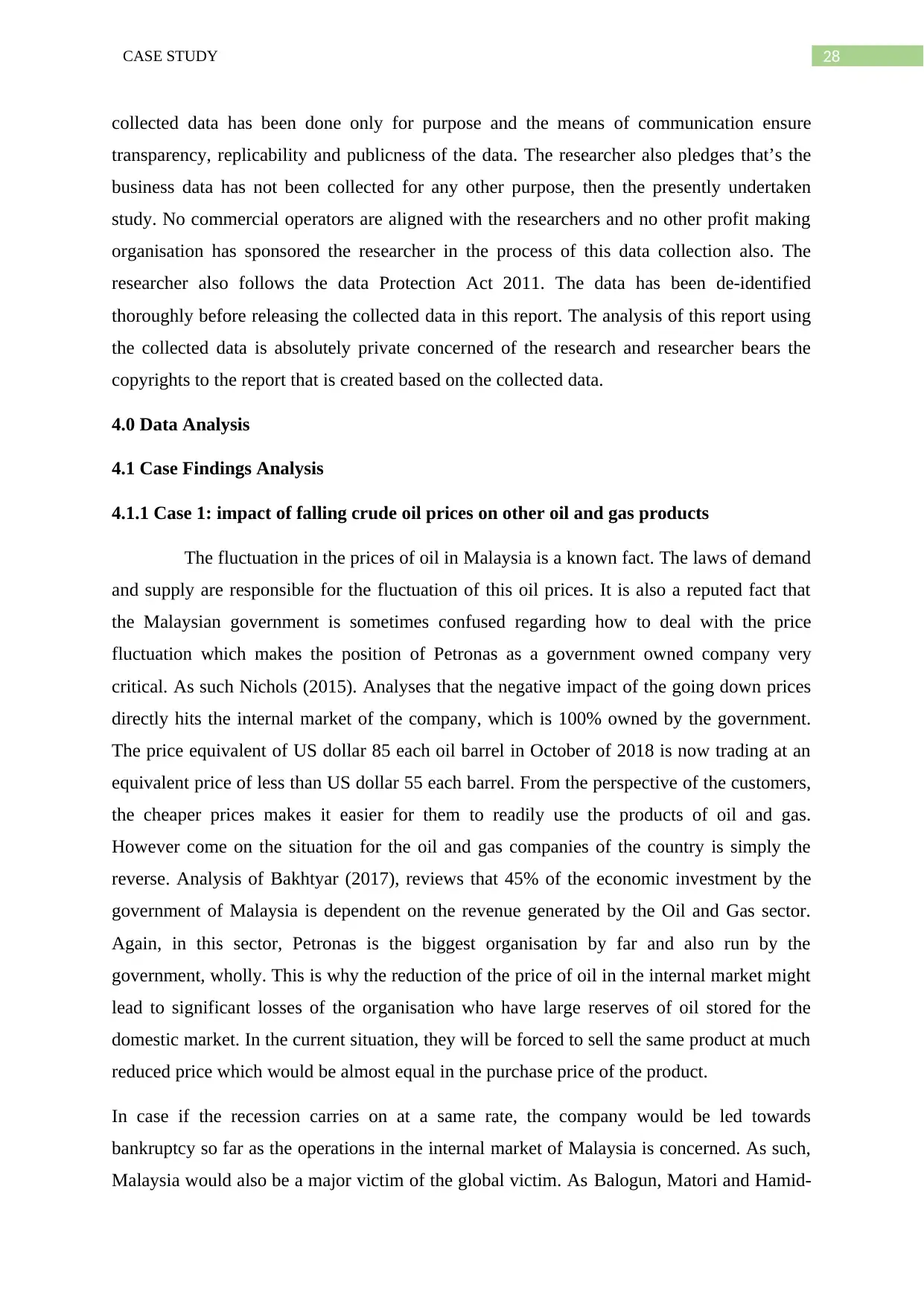
28CASE STUDY
collected data has been done only for purpose and the means of communication ensure
transparency, replicability and publicness of the data. The researcher also pledges that’s the
business data has not been collected for any other purpose, then the presently undertaken
study. No commercial operators are aligned with the researchers and no other profit making
organisation has sponsored the researcher in the process of this data collection also. The
researcher also follows the data Protection Act 2011. The data has been de-identified
thoroughly before releasing the collected data in this report. The analysis of this report using
the collected data is absolutely private concerned of the research and researcher bears the
copyrights to the report that is created based on the collected data.
4.0 Data Analysis
4.1 Case Findings Analysis
4.1.1 Case 1: impact of falling crude oil prices on other oil and gas products
The fluctuation in the prices of oil in Malaysia is a known fact. The laws of demand
and supply are responsible for the fluctuation of this oil prices. It is also a reputed fact that
the Malaysian government is sometimes confused regarding how to deal with the price
fluctuation which makes the position of Petronas as a government owned company very
critical. As such Nichols (2015). Analyses that the negative impact of the going down prices
directly hits the internal market of the company, which is 100% owned by the government.
The price equivalent of US dollar 85 each oil barrel in October of 2018 is now trading at an
equivalent price of less than US dollar 55 each barrel. From the perspective of the customers,
the cheaper prices makes it easier for them to readily use the products of oil and gas.
However come on the situation for the oil and gas companies of the country is simply the
reverse. Analysis of Bakhtyar (2017), reviews that 45% of the economic investment by the
government of Malaysia is dependent on the revenue generated by the Oil and Gas sector.
Again, in this sector, Petronas is the biggest organisation by far and also run by the
government, wholly. This is why the reduction of the price of oil in the internal market might
lead to significant losses of the organisation who have large reserves of oil stored for the
domestic market. In the current situation, they will be forced to sell the same product at much
reduced price which would be almost equal in the purchase price of the product.
In case if the recession carries on at a same rate, the company would be led towards
bankruptcy so far as the operations in the internal market of Malaysia is concerned. As such,
Malaysia would also be a major victim of the global victim. As Balogun, Matori and Hamid-
collected data has been done only for purpose and the means of communication ensure
transparency, replicability and publicness of the data. The researcher also pledges that’s the
business data has not been collected for any other purpose, then the presently undertaken
study. No commercial operators are aligned with the researchers and no other profit making
organisation has sponsored the researcher in the process of this data collection also. The
researcher also follows the data Protection Act 2011. The data has been de-identified
thoroughly before releasing the collected data in this report. The analysis of this report using
the collected data is absolutely private concerned of the research and researcher bears the
copyrights to the report that is created based on the collected data.
4.0 Data Analysis
4.1 Case Findings Analysis
4.1.1 Case 1: impact of falling crude oil prices on other oil and gas products
The fluctuation in the prices of oil in Malaysia is a known fact. The laws of demand
and supply are responsible for the fluctuation of this oil prices. It is also a reputed fact that
the Malaysian government is sometimes confused regarding how to deal with the price
fluctuation which makes the position of Petronas as a government owned company very
critical. As such Nichols (2015). Analyses that the negative impact of the going down prices
directly hits the internal market of the company, which is 100% owned by the government.
The price equivalent of US dollar 85 each oil barrel in October of 2018 is now trading at an
equivalent price of less than US dollar 55 each barrel. From the perspective of the customers,
the cheaper prices makes it easier for them to readily use the products of oil and gas.
However come on the situation for the oil and gas companies of the country is simply the
reverse. Analysis of Bakhtyar (2017), reviews that 45% of the economic investment by the
government of Malaysia is dependent on the revenue generated by the Oil and Gas sector.
Again, in this sector, Petronas is the biggest organisation by far and also run by the
government, wholly. This is why the reduction of the price of oil in the internal market might
lead to significant losses of the organisation who have large reserves of oil stored for the
domestic market. In the current situation, they will be forced to sell the same product at much
reduced price which would be almost equal in the purchase price of the product.
In case if the recession carries on at a same rate, the company would be led towards
bankruptcy so far as the operations in the internal market of Malaysia is concerned. As such,
Malaysia would also be a major victim of the global victim. As Balogun, Matori and Hamid-
Secure Best Marks with AI Grader
Need help grading? Try our AI Grader for instant feedback on your assignments.
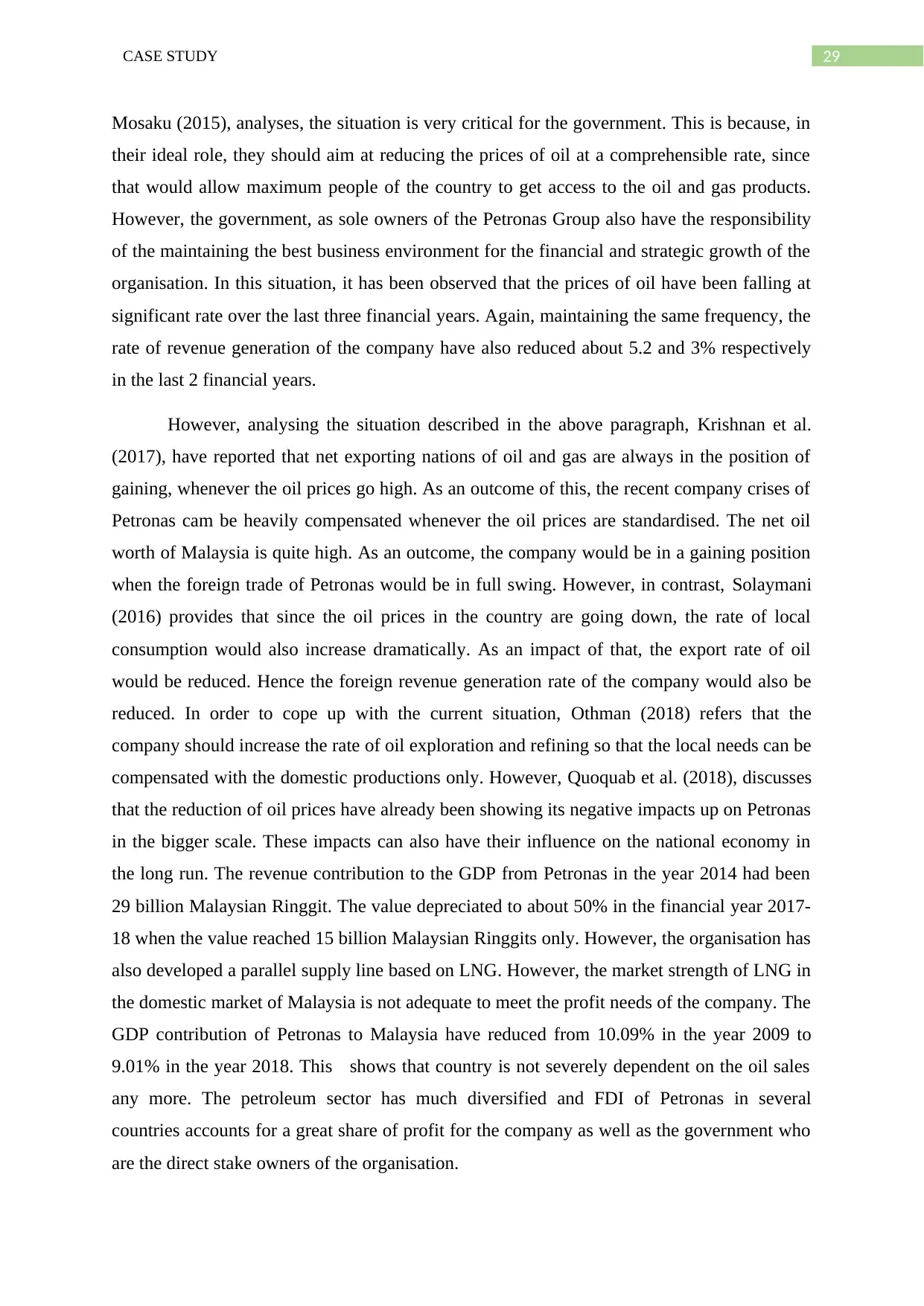
29CASE STUDY
Mosaku (2015), analyses, the situation is very critical for the government. This is because, in
their ideal role, they should aim at reducing the prices of oil at a comprehensible rate, since
that would allow maximum people of the country to get access to the oil and gas products.
However, the government, as sole owners of the Petronas Group also have the responsibility
of the maintaining the best business environment for the financial and strategic growth of the
organisation. In this situation, it has been observed that the prices of oil have been falling at
significant rate over the last three financial years. Again, maintaining the same frequency, the
rate of revenue generation of the company have also reduced about 5.2 and 3% respectively
in the last 2 financial years.
However, analysing the situation described in the above paragraph, Krishnan et al.
(2017), have reported that net exporting nations of oil and gas are always in the position of
gaining, whenever the oil prices go high. As an outcome of this, the recent company crises of
Petronas cam be heavily compensated whenever the oil prices are standardised. The net oil
worth of Malaysia is quite high. As an outcome, the company would be in a gaining position
when the foreign trade of Petronas would be in full swing. However, in contrast, Solaymani
(2016) provides that since the oil prices in the country are going down, the rate of local
consumption would also increase dramatically. As an impact of that, the export rate of oil
would be reduced. Hence the foreign revenue generation rate of the company would also be
reduced. In order to cope up with the current situation, Othman (2018) refers that the
company should increase the rate of oil exploration and refining so that the local needs can be
compensated with the domestic productions only. However, Quoquab et al. (2018), discusses
that the reduction of oil prices have already been showing its negative impacts up on Petronas
in the bigger scale. These impacts can also have their influence on the national economy in
the long run. The revenue contribution to the GDP from Petronas in the year 2014 had been
29 billion Malaysian Ringgit. The value depreciated to about 50% in the financial year 2017-
18 when the value reached 15 billion Malaysian Ringgits only. However, the organisation has
also developed a parallel supply line based on LNG. However, the market strength of LNG in
the domestic market of Malaysia is not adequate to meet the profit needs of the company. The
GDP contribution of Petronas to Malaysia have reduced from 10.09% in the year 2009 to
9.01% in the year 2018. This shows that country is not severely dependent on the oil sales
any more. The petroleum sector has much diversified and FDI of Petronas in several
countries accounts for a great share of profit for the company as well as the government who
are the direct stake owners of the organisation.
Mosaku (2015), analyses, the situation is very critical for the government. This is because, in
their ideal role, they should aim at reducing the prices of oil at a comprehensible rate, since
that would allow maximum people of the country to get access to the oil and gas products.
However, the government, as sole owners of the Petronas Group also have the responsibility
of the maintaining the best business environment for the financial and strategic growth of the
organisation. In this situation, it has been observed that the prices of oil have been falling at
significant rate over the last three financial years. Again, maintaining the same frequency, the
rate of revenue generation of the company have also reduced about 5.2 and 3% respectively
in the last 2 financial years.
However, analysing the situation described in the above paragraph, Krishnan et al.
(2017), have reported that net exporting nations of oil and gas are always in the position of
gaining, whenever the oil prices go high. As an outcome of this, the recent company crises of
Petronas cam be heavily compensated whenever the oil prices are standardised. The net oil
worth of Malaysia is quite high. As an outcome, the company would be in a gaining position
when the foreign trade of Petronas would be in full swing. However, in contrast, Solaymani
(2016) provides that since the oil prices in the country are going down, the rate of local
consumption would also increase dramatically. As an impact of that, the export rate of oil
would be reduced. Hence the foreign revenue generation rate of the company would also be
reduced. In order to cope up with the current situation, Othman (2018) refers that the
company should increase the rate of oil exploration and refining so that the local needs can be
compensated with the domestic productions only. However, Quoquab et al. (2018), discusses
that the reduction of oil prices have already been showing its negative impacts up on Petronas
in the bigger scale. These impacts can also have their influence on the national economy in
the long run. The revenue contribution to the GDP from Petronas in the year 2014 had been
29 billion Malaysian Ringgit. The value depreciated to about 50% in the financial year 2017-
18 when the value reached 15 billion Malaysian Ringgits only. However, the organisation has
also developed a parallel supply line based on LNG. However, the market strength of LNG in
the domestic market of Malaysia is not adequate to meet the profit needs of the company. The
GDP contribution of Petronas to Malaysia have reduced from 10.09% in the year 2009 to
9.01% in the year 2018. This shows that country is not severely dependent on the oil sales
any more. The petroleum sector has much diversified and FDI of Petronas in several
countries accounts for a great share of profit for the company as well as the government who
are the direct stake owners of the organisation.
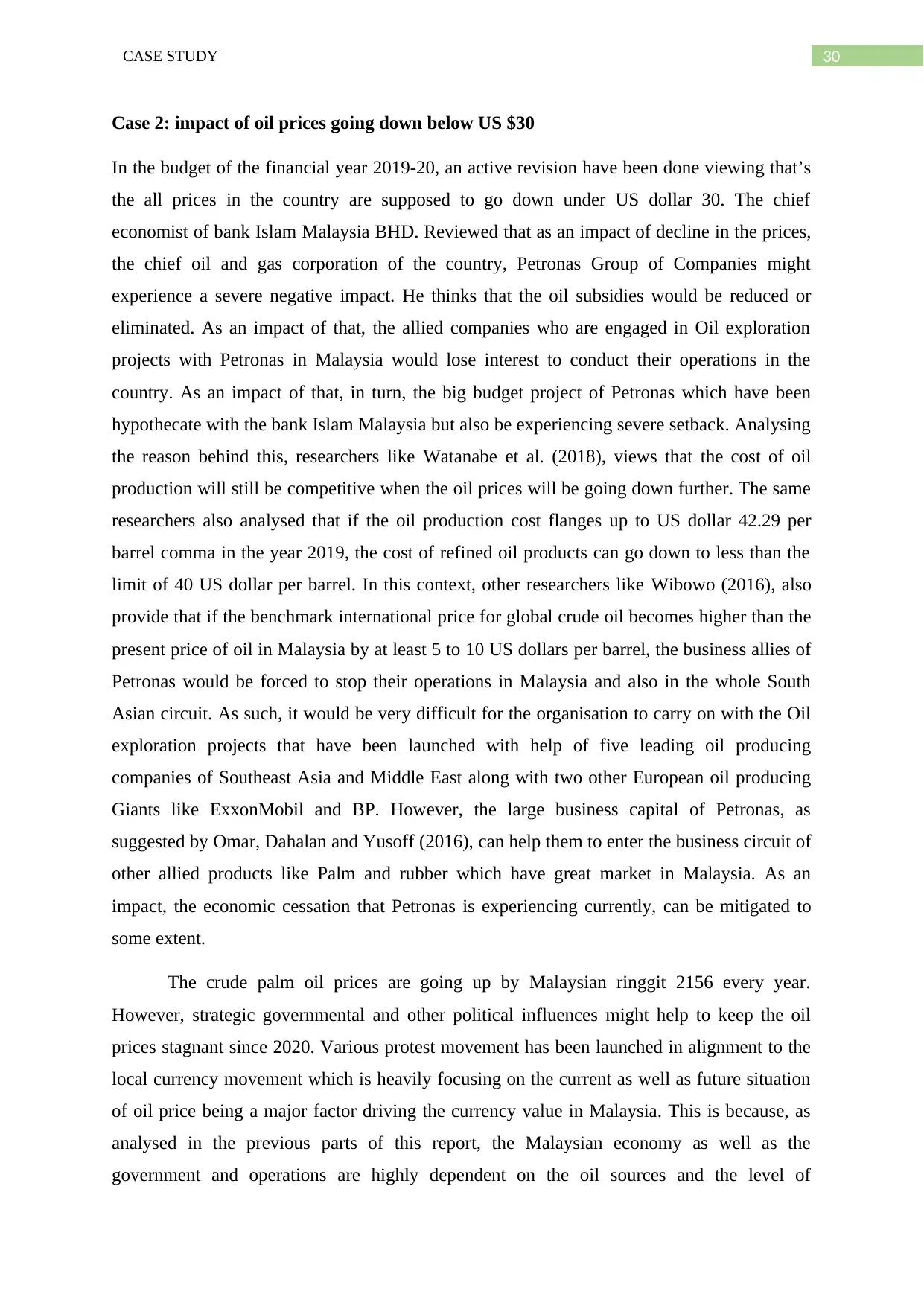
30CASE STUDY
Case 2: impact of oil prices going down below US $30
In the budget of the financial year 2019-20, an active revision have been done viewing that’s
the all prices in the country are supposed to go down under US dollar 30. The chief
economist of bank Islam Malaysia BHD. Reviewed that as an impact of decline in the prices,
the chief oil and gas corporation of the country, Petronas Group of Companies might
experience a severe negative impact. He thinks that the oil subsidies would be reduced or
eliminated. As an impact of that, the allied companies who are engaged in Oil exploration
projects with Petronas in Malaysia would lose interest to conduct their operations in the
country. As an impact of that, in turn, the big budget project of Petronas which have been
hypothecate with the bank Islam Malaysia but also be experiencing severe setback. Analysing
the reason behind this, researchers like Watanabe et al. (2018), views that the cost of oil
production will still be competitive when the oil prices will be going down further. The same
researchers also analysed that if the oil production cost flanges up to US dollar 42.29 per
barrel comma in the year 2019, the cost of refined oil products can go down to less than the
limit of 40 US dollar per barrel. In this context, other researchers like Wibowo (2016), also
provide that if the benchmark international price for global crude oil becomes higher than the
present price of oil in Malaysia by at least 5 to 10 US dollars per barrel, the business allies of
Petronas would be forced to stop their operations in Malaysia and also in the whole South
Asian circuit. As such, it would be very difficult for the organisation to carry on with the Oil
exploration projects that have been launched with help of five leading oil producing
companies of Southeast Asia and Middle East along with two other European oil producing
Giants like ExxonMobil and BP. However, the large business capital of Petronas, as
suggested by Omar, Dahalan and Yusoff (2016), can help them to enter the business circuit of
other allied products like Palm and rubber which have great market in Malaysia. As an
impact, the economic cessation that Petronas is experiencing currently, can be mitigated to
some extent.
The crude palm oil prices are going up by Malaysian ringgit 2156 every year.
However, strategic governmental and other political influences might help to keep the oil
prices stagnant since 2020. Various protest movement has been launched in alignment to the
local currency movement which is heavily focusing on the current as well as future situation
of oil price being a major factor driving the currency value in Malaysia. This is because, as
analysed in the previous parts of this report, the Malaysian economy as well as the
government and operations are highly dependent on the oil sources and the level of
Case 2: impact of oil prices going down below US $30
In the budget of the financial year 2019-20, an active revision have been done viewing that’s
the all prices in the country are supposed to go down under US dollar 30. The chief
economist of bank Islam Malaysia BHD. Reviewed that as an impact of decline in the prices,
the chief oil and gas corporation of the country, Petronas Group of Companies might
experience a severe negative impact. He thinks that the oil subsidies would be reduced or
eliminated. As an impact of that, the allied companies who are engaged in Oil exploration
projects with Petronas in Malaysia would lose interest to conduct their operations in the
country. As an impact of that, in turn, the big budget project of Petronas which have been
hypothecate with the bank Islam Malaysia but also be experiencing severe setback. Analysing
the reason behind this, researchers like Watanabe et al. (2018), views that the cost of oil
production will still be competitive when the oil prices will be going down further. The same
researchers also analysed that if the oil production cost flanges up to US dollar 42.29 per
barrel comma in the year 2019, the cost of refined oil products can go down to less than the
limit of 40 US dollar per barrel. In this context, other researchers like Wibowo (2016), also
provide that if the benchmark international price for global crude oil becomes higher than the
present price of oil in Malaysia by at least 5 to 10 US dollars per barrel, the business allies of
Petronas would be forced to stop their operations in Malaysia and also in the whole South
Asian circuit. As such, it would be very difficult for the organisation to carry on with the Oil
exploration projects that have been launched with help of five leading oil producing
companies of Southeast Asia and Middle East along with two other European oil producing
Giants like ExxonMobil and BP. However, the large business capital of Petronas, as
suggested by Omar, Dahalan and Yusoff (2016), can help them to enter the business circuit of
other allied products like Palm and rubber which have great market in Malaysia. As an
impact, the economic cessation that Petronas is experiencing currently, can be mitigated to
some extent.
The crude palm oil prices are going up by Malaysian ringgit 2156 every year.
However, strategic governmental and other political influences might help to keep the oil
prices stagnant since 2020. Various protest movement has been launched in alignment to the
local currency movement which is heavily focusing on the current as well as future situation
of oil price being a major factor driving the currency value in Malaysia. This is because, as
analysed in the previous parts of this report, the Malaysian economy as well as the
government and operations are highly dependent on the oil sources and the level of
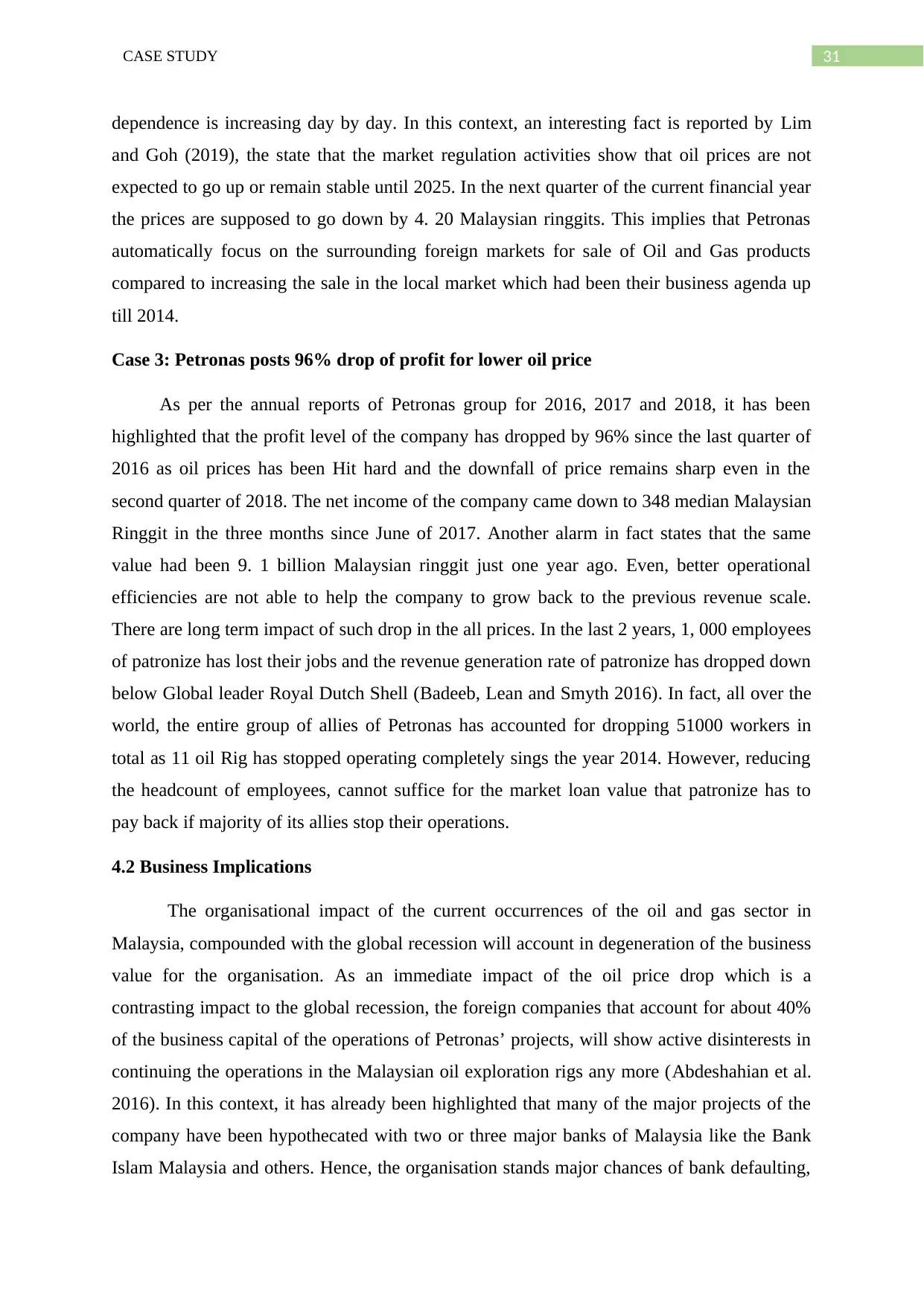
31CASE STUDY
dependence is increasing day by day. In this context, an interesting fact is reported by Lim
and Goh (2019), the state that the market regulation activities show that oil prices are not
expected to go up or remain stable until 2025. In the next quarter of the current financial year
the prices are supposed to go down by 4. 20 Malaysian ringgits. This implies that Petronas
automatically focus on the surrounding foreign markets for sale of Oil and Gas products
compared to increasing the sale in the local market which had been their business agenda up
till 2014.
Case 3: Petronas posts 96% drop of profit for lower oil price
As per the annual reports of Petronas group for 2016, 2017 and 2018, it has been
highlighted that the profit level of the company has dropped by 96% since the last quarter of
2016 as oil prices has been Hit hard and the downfall of price remains sharp even in the
second quarter of 2018. The net income of the company came down to 348 median Malaysian
Ringgit in the three months since June of 2017. Another alarm in fact states that the same
value had been 9. 1 billion Malaysian ringgit just one year ago. Even, better operational
efficiencies are not able to help the company to grow back to the previous revenue scale.
There are long term impact of such drop in the all prices. In the last 2 years, 1, 000 employees
of patronize has lost their jobs and the revenue generation rate of patronize has dropped down
below Global leader Royal Dutch Shell (Badeeb, Lean and Smyth 2016). In fact, all over the
world, the entire group of allies of Petronas has accounted for dropping 51000 workers in
total as 11 oil Rig has stopped operating completely sings the year 2014. However, reducing
the headcount of employees, cannot suffice for the market loan value that patronize has to
pay back if majority of its allies stop their operations.
4.2 Business Implications
The organisational impact of the current occurrences of the oil and gas sector in
Malaysia, compounded with the global recession will account in degeneration of the business
value for the organisation. As an immediate impact of the oil price drop which is a
contrasting impact to the global recession, the foreign companies that account for about 40%
of the business capital of the operations of Petronas’ projects, will show active disinterests in
continuing the operations in the Malaysian oil exploration rigs any more (Abdeshahian et al.
2016). In this context, it has already been highlighted that many of the major projects of the
company have been hypothecated with two or three major banks of Malaysia like the Bank
Islam Malaysia and others. Hence, the organisation stands major chances of bank defaulting,
dependence is increasing day by day. In this context, an interesting fact is reported by Lim
and Goh (2019), the state that the market regulation activities show that oil prices are not
expected to go up or remain stable until 2025. In the next quarter of the current financial year
the prices are supposed to go down by 4. 20 Malaysian ringgits. This implies that Petronas
automatically focus on the surrounding foreign markets for sale of Oil and Gas products
compared to increasing the sale in the local market which had been their business agenda up
till 2014.
Case 3: Petronas posts 96% drop of profit for lower oil price
As per the annual reports of Petronas group for 2016, 2017 and 2018, it has been
highlighted that the profit level of the company has dropped by 96% since the last quarter of
2016 as oil prices has been Hit hard and the downfall of price remains sharp even in the
second quarter of 2018. The net income of the company came down to 348 median Malaysian
Ringgit in the three months since June of 2017. Another alarm in fact states that the same
value had been 9. 1 billion Malaysian ringgit just one year ago. Even, better operational
efficiencies are not able to help the company to grow back to the previous revenue scale.
There are long term impact of such drop in the all prices. In the last 2 years, 1, 000 employees
of patronize has lost their jobs and the revenue generation rate of patronize has dropped down
below Global leader Royal Dutch Shell (Badeeb, Lean and Smyth 2016). In fact, all over the
world, the entire group of allies of Petronas has accounted for dropping 51000 workers in
total as 11 oil Rig has stopped operating completely sings the year 2014. However, reducing
the headcount of employees, cannot suffice for the market loan value that patronize has to
pay back if majority of its allies stop their operations.
4.2 Business Implications
The organisational impact of the current occurrences of the oil and gas sector in
Malaysia, compounded with the global recession will account in degeneration of the business
value for the organisation. As an immediate impact of the oil price drop which is a
contrasting impact to the global recession, the foreign companies that account for about 40%
of the business capital of the operations of Petronas’ projects, will show active disinterests in
continuing the operations in the Malaysian oil exploration rigs any more (Abdeshahian et al.
2016). In this context, it has already been highlighted that many of the major projects of the
company have been hypothecated with two or three major banks of Malaysia like the Bank
Islam Malaysia and others. Hence, the organisation stands major chances of bank defaulting,
Paraphrase This Document
Need a fresh take? Get an instant paraphrase of this document with our AI Paraphraser
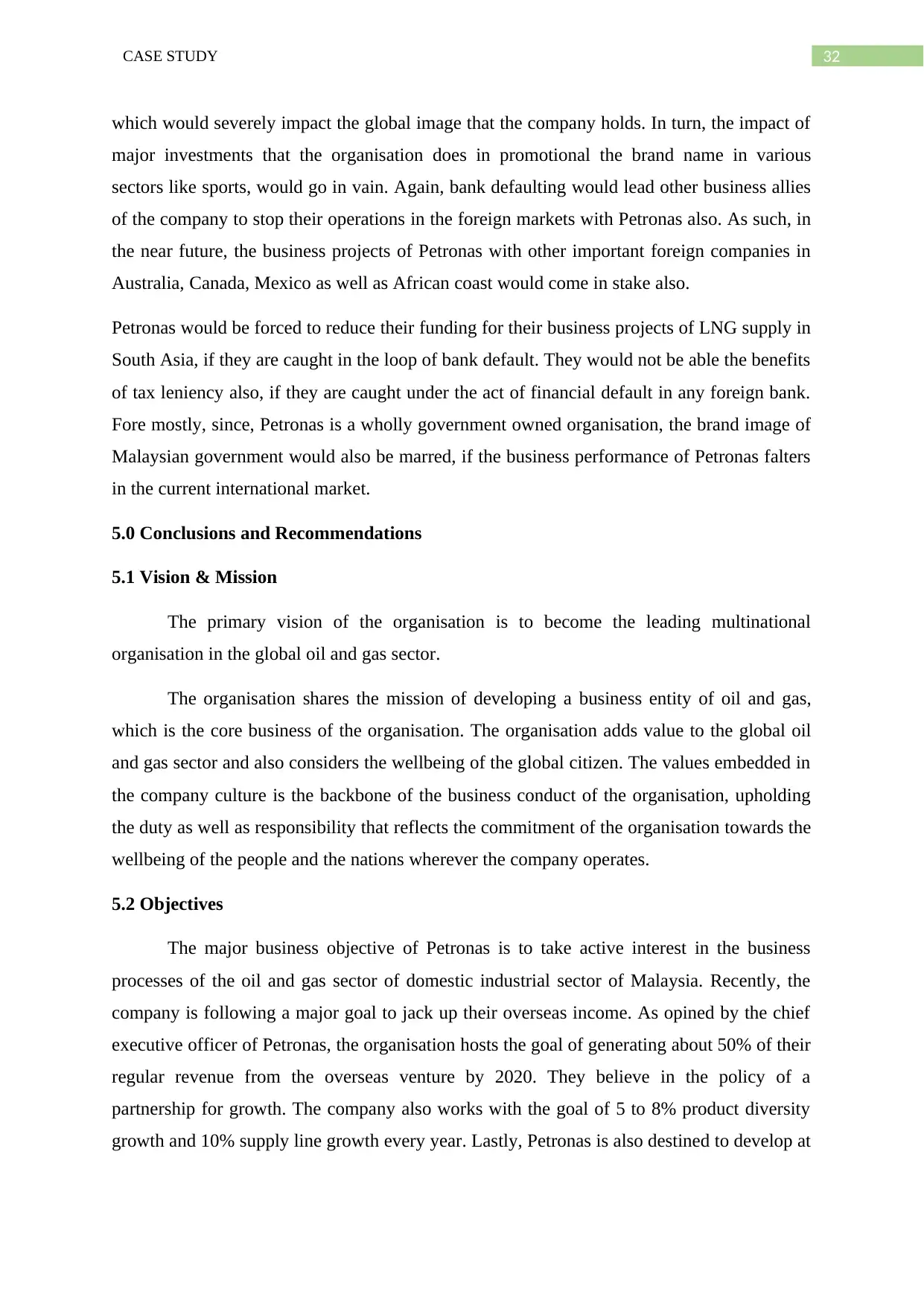
32CASE STUDY
which would severely impact the global image that the company holds. In turn, the impact of
major investments that the organisation does in promotional the brand name in various
sectors like sports, would go in vain. Again, bank defaulting would lead other business allies
of the company to stop their operations in the foreign markets with Petronas also. As such, in
the near future, the business projects of Petronas with other important foreign companies in
Australia, Canada, Mexico as well as African coast would come in stake also.
Petronas would be forced to reduce their funding for their business projects of LNG supply in
South Asia, if they are caught in the loop of bank default. They would not be able the benefits
of tax leniency also, if they are caught under the act of financial default in any foreign bank.
Fore mostly, since, Petronas is a wholly government owned organisation, the brand image of
Malaysian government would also be marred, if the business performance of Petronas falters
in the current international market.
5.0 Conclusions and Recommendations
5.1 Vision & Mission
The primary vision of the organisation is to become the leading multinational
organisation in the global oil and gas sector.
The organisation shares the mission of developing a business entity of oil and gas,
which is the core business of the organisation. The organisation adds value to the global oil
and gas sector and also considers the wellbeing of the global citizen. The values embedded in
the company culture is the backbone of the business conduct of the organisation, upholding
the duty as well as responsibility that reflects the commitment of the organisation towards the
wellbeing of the people and the nations wherever the company operates.
5.2 Objectives
The major business objective of Petronas is to take active interest in the business
processes of the oil and gas sector of domestic industrial sector of Malaysia. Recently, the
company is following a major goal to jack up their overseas income. As opined by the chief
executive officer of Petronas, the organisation hosts the goal of generating about 50% of their
regular revenue from the overseas venture by 2020. They believe in the policy of a
partnership for growth. The company also works with the goal of 5 to 8% product diversity
growth and 10% supply line growth every year. Lastly, Petronas is also destined to develop at
which would severely impact the global image that the company holds. In turn, the impact of
major investments that the organisation does in promotional the brand name in various
sectors like sports, would go in vain. Again, bank defaulting would lead other business allies
of the company to stop their operations in the foreign markets with Petronas also. As such, in
the near future, the business projects of Petronas with other important foreign companies in
Australia, Canada, Mexico as well as African coast would come in stake also.
Petronas would be forced to reduce their funding for their business projects of LNG supply in
South Asia, if they are caught in the loop of bank default. They would not be able the benefits
of tax leniency also, if they are caught under the act of financial default in any foreign bank.
Fore mostly, since, Petronas is a wholly government owned organisation, the brand image of
Malaysian government would also be marred, if the business performance of Petronas falters
in the current international market.
5.0 Conclusions and Recommendations
5.1 Vision & Mission
The primary vision of the organisation is to become the leading multinational
organisation in the global oil and gas sector.
The organisation shares the mission of developing a business entity of oil and gas,
which is the core business of the organisation. The organisation adds value to the global oil
and gas sector and also considers the wellbeing of the global citizen. The values embedded in
the company culture is the backbone of the business conduct of the organisation, upholding
the duty as well as responsibility that reflects the commitment of the organisation towards the
wellbeing of the people and the nations wherever the company operates.
5.2 Objectives
The major business objective of Petronas is to take active interest in the business
processes of the oil and gas sector of domestic industrial sector of Malaysia. Recently, the
company is following a major goal to jack up their overseas income. As opined by the chief
executive officer of Petronas, the organisation hosts the goal of generating about 50% of their
regular revenue from the overseas venture by 2020. They believe in the policy of a
partnership for growth. The company also works with the goal of 5 to 8% product diversity
growth and 10% supply line growth every year. Lastly, Petronas is also destined to develop at
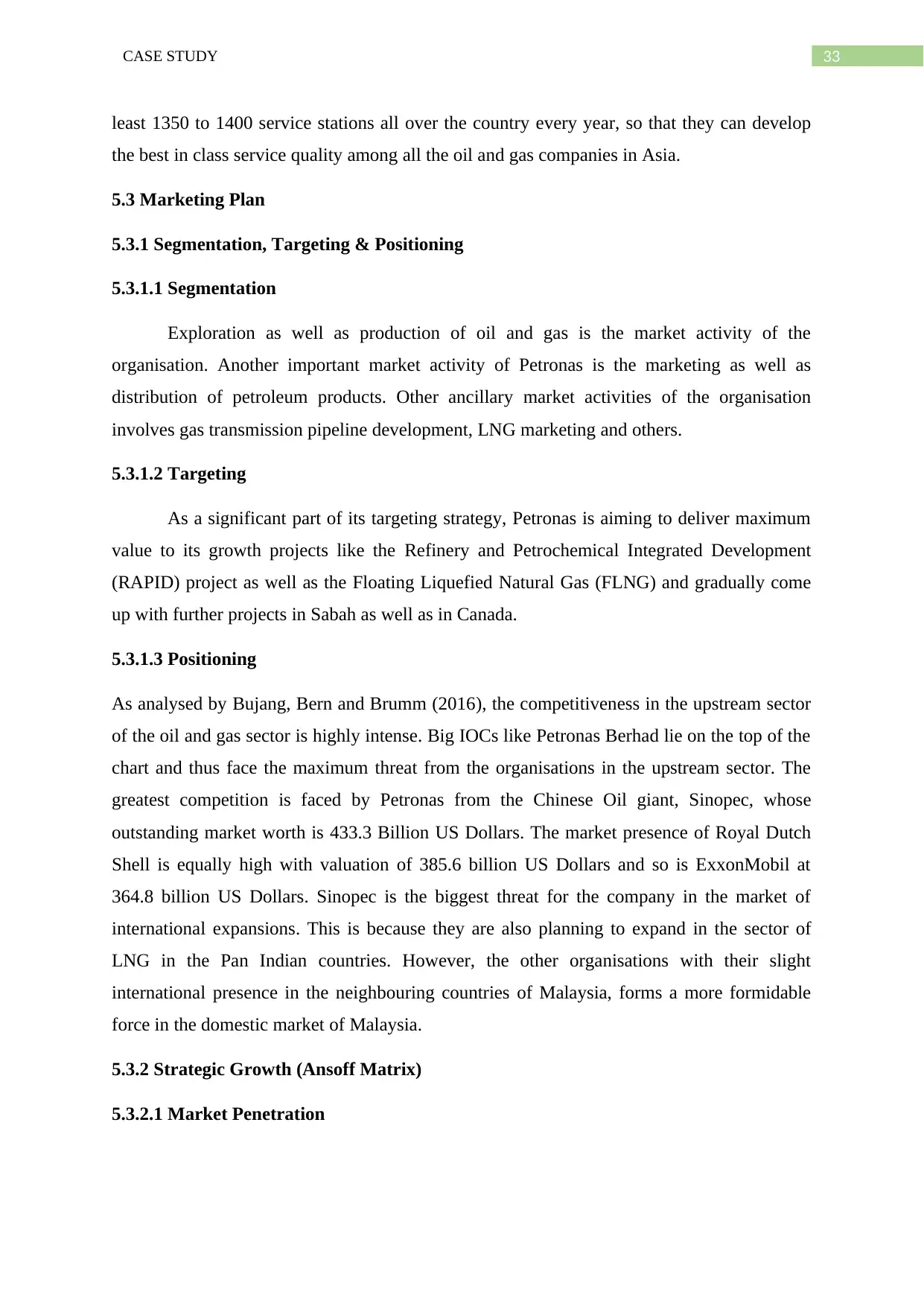
33CASE STUDY
least 1350 to 1400 service stations all over the country every year, so that they can develop
the best in class service quality among all the oil and gas companies in Asia.
5.3 Marketing Plan
5.3.1 Segmentation, Targeting & Positioning
5.3.1.1 Segmentation
Exploration as well as production of oil and gas is the market activity of the
organisation. Another important market activity of Petronas is the marketing as well as
distribution of petroleum products. Other ancillary market activities of the organisation
involves gas transmission pipeline development, LNG marketing and others.
5.3.1.2 Targeting
As a significant part of its targeting strategy, Petronas is aiming to deliver maximum
value to its growth projects like the Refinery and Petrochemical Integrated Development
(RAPID) project as well as the Floating Liquefied Natural Gas (FLNG) and gradually come
up with further projects in Sabah as well as in Canada.
5.3.1.3 Positioning
As analysed by Bujang, Bern and Brumm (2016), the competitiveness in the upstream sector
of the oil and gas sector is highly intense. Big IOCs like Petronas Berhad lie on the top of the
chart and thus face the maximum threat from the organisations in the upstream sector. The
greatest competition is faced by Petronas from the Chinese Oil giant, Sinopec, whose
outstanding market worth is 433.3 Billion US Dollars. The market presence of Royal Dutch
Shell is equally high with valuation of 385.6 billion US Dollars and so is ExxonMobil at
364.8 billion US Dollars. Sinopec is the biggest threat for the company in the market of
international expansions. This is because they are also planning to expand in the sector of
LNG in the Pan Indian countries. However, the other organisations with their slight
international presence in the neighbouring countries of Malaysia, forms a more formidable
force in the domestic market of Malaysia.
5.3.2 Strategic Growth (Ansoff Matrix)
5.3.2.1 Market Penetration
least 1350 to 1400 service stations all over the country every year, so that they can develop
the best in class service quality among all the oil and gas companies in Asia.
5.3 Marketing Plan
5.3.1 Segmentation, Targeting & Positioning
5.3.1.1 Segmentation
Exploration as well as production of oil and gas is the market activity of the
organisation. Another important market activity of Petronas is the marketing as well as
distribution of petroleum products. Other ancillary market activities of the organisation
involves gas transmission pipeline development, LNG marketing and others.
5.3.1.2 Targeting
As a significant part of its targeting strategy, Petronas is aiming to deliver maximum
value to its growth projects like the Refinery and Petrochemical Integrated Development
(RAPID) project as well as the Floating Liquefied Natural Gas (FLNG) and gradually come
up with further projects in Sabah as well as in Canada.
5.3.1.3 Positioning
As analysed by Bujang, Bern and Brumm (2016), the competitiveness in the upstream sector
of the oil and gas sector is highly intense. Big IOCs like Petronas Berhad lie on the top of the
chart and thus face the maximum threat from the organisations in the upstream sector. The
greatest competition is faced by Petronas from the Chinese Oil giant, Sinopec, whose
outstanding market worth is 433.3 Billion US Dollars. The market presence of Royal Dutch
Shell is equally high with valuation of 385.6 billion US Dollars and so is ExxonMobil at
364.8 billion US Dollars. Sinopec is the biggest threat for the company in the market of
international expansions. This is because they are also planning to expand in the sector of
LNG in the Pan Indian countries. However, the other organisations with their slight
international presence in the neighbouring countries of Malaysia, forms a more formidable
force in the domestic market of Malaysia.
5.3.2 Strategic Growth (Ansoff Matrix)
5.3.2.1 Market Penetration
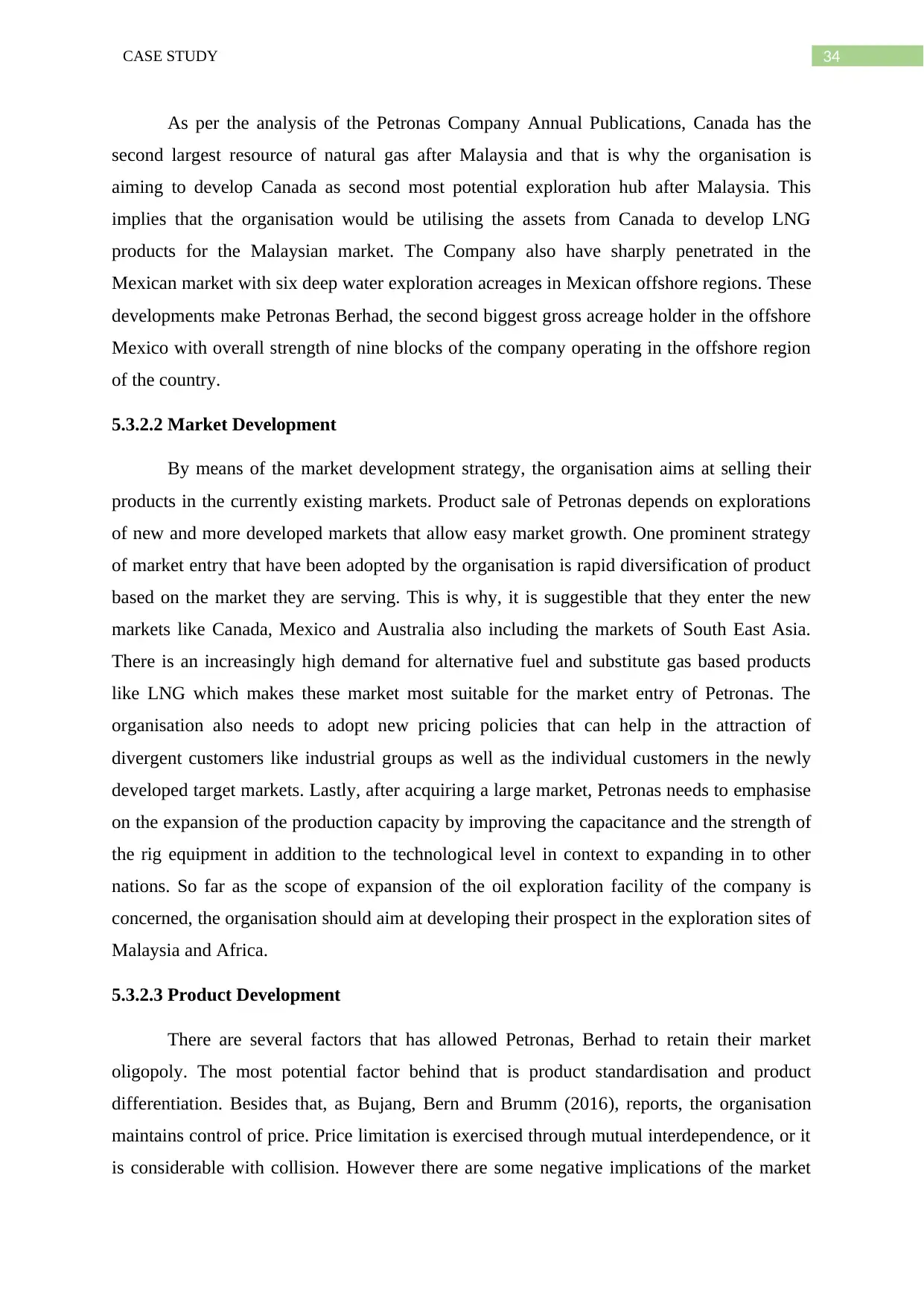
34CASE STUDY
As per the analysis of the Petronas Company Annual Publications, Canada has the
second largest resource of natural gas after Malaysia and that is why the organisation is
aiming to develop Canada as second most potential exploration hub after Malaysia. This
implies that the organisation would be utilising the assets from Canada to develop LNG
products for the Malaysian market. The Company also have sharply penetrated in the
Mexican market with six deep water exploration acreages in Mexican offshore regions. These
developments make Petronas Berhad, the second biggest gross acreage holder in the offshore
Mexico with overall strength of nine blocks of the company operating in the offshore region
of the country.
5.3.2.2 Market Development
By means of the market development strategy, the organisation aims at selling their
products in the currently existing markets. Product sale of Petronas depends on explorations
of new and more developed markets that allow easy market growth. One prominent strategy
of market entry that have been adopted by the organisation is rapid diversification of product
based on the market they are serving. This is why, it is suggestible that they enter the new
markets like Canada, Mexico and Australia also including the markets of South East Asia.
There is an increasingly high demand for alternative fuel and substitute gas based products
like LNG which makes these market most suitable for the market entry of Petronas. The
organisation also needs to adopt new pricing policies that can help in the attraction of
divergent customers like industrial groups as well as the individual customers in the newly
developed target markets. Lastly, after acquiring a large market, Petronas needs to emphasise
on the expansion of the production capacity by improving the capacitance and the strength of
the rig equipment in addition to the technological level in context to expanding in to other
nations. So far as the scope of expansion of the oil exploration facility of the company is
concerned, the organisation should aim at developing their prospect in the exploration sites of
Malaysia and Africa.
5.3.2.3 Product Development
There are several factors that has allowed Petronas, Berhad to retain their market
oligopoly. The most potential factor behind that is product standardisation and product
differentiation. Besides that, as Bujang, Bern and Brumm (2016), reports, the organisation
maintains control of price. Price limitation is exercised through mutual interdependence, or it
is considerable with collision. However there are some negative implications of the market
As per the analysis of the Petronas Company Annual Publications, Canada has the
second largest resource of natural gas after Malaysia and that is why the organisation is
aiming to develop Canada as second most potential exploration hub after Malaysia. This
implies that the organisation would be utilising the assets from Canada to develop LNG
products for the Malaysian market. The Company also have sharply penetrated in the
Mexican market with six deep water exploration acreages in Mexican offshore regions. These
developments make Petronas Berhad, the second biggest gross acreage holder in the offshore
Mexico with overall strength of nine blocks of the company operating in the offshore region
of the country.
5.3.2.2 Market Development
By means of the market development strategy, the organisation aims at selling their
products in the currently existing markets. Product sale of Petronas depends on explorations
of new and more developed markets that allow easy market growth. One prominent strategy
of market entry that have been adopted by the organisation is rapid diversification of product
based on the market they are serving. This is why, it is suggestible that they enter the new
markets like Canada, Mexico and Australia also including the markets of South East Asia.
There is an increasingly high demand for alternative fuel and substitute gas based products
like LNG which makes these market most suitable for the market entry of Petronas. The
organisation also needs to adopt new pricing policies that can help in the attraction of
divergent customers like industrial groups as well as the individual customers in the newly
developed target markets. Lastly, after acquiring a large market, Petronas needs to emphasise
on the expansion of the production capacity by improving the capacitance and the strength of
the rig equipment in addition to the technological level in context to expanding in to other
nations. So far as the scope of expansion of the oil exploration facility of the company is
concerned, the organisation should aim at developing their prospect in the exploration sites of
Malaysia and Africa.
5.3.2.3 Product Development
There are several factors that has allowed Petronas, Berhad to retain their market
oligopoly. The most potential factor behind that is product standardisation and product
differentiation. Besides that, as Bujang, Bern and Brumm (2016), reports, the organisation
maintains control of price. Price limitation is exercised through mutual interdependence, or it
is considerable with collision. However there are some negative implications of the market
Secure Best Marks with AI Grader
Need help grading? Try our AI Grader for instant feedback on your assignments.
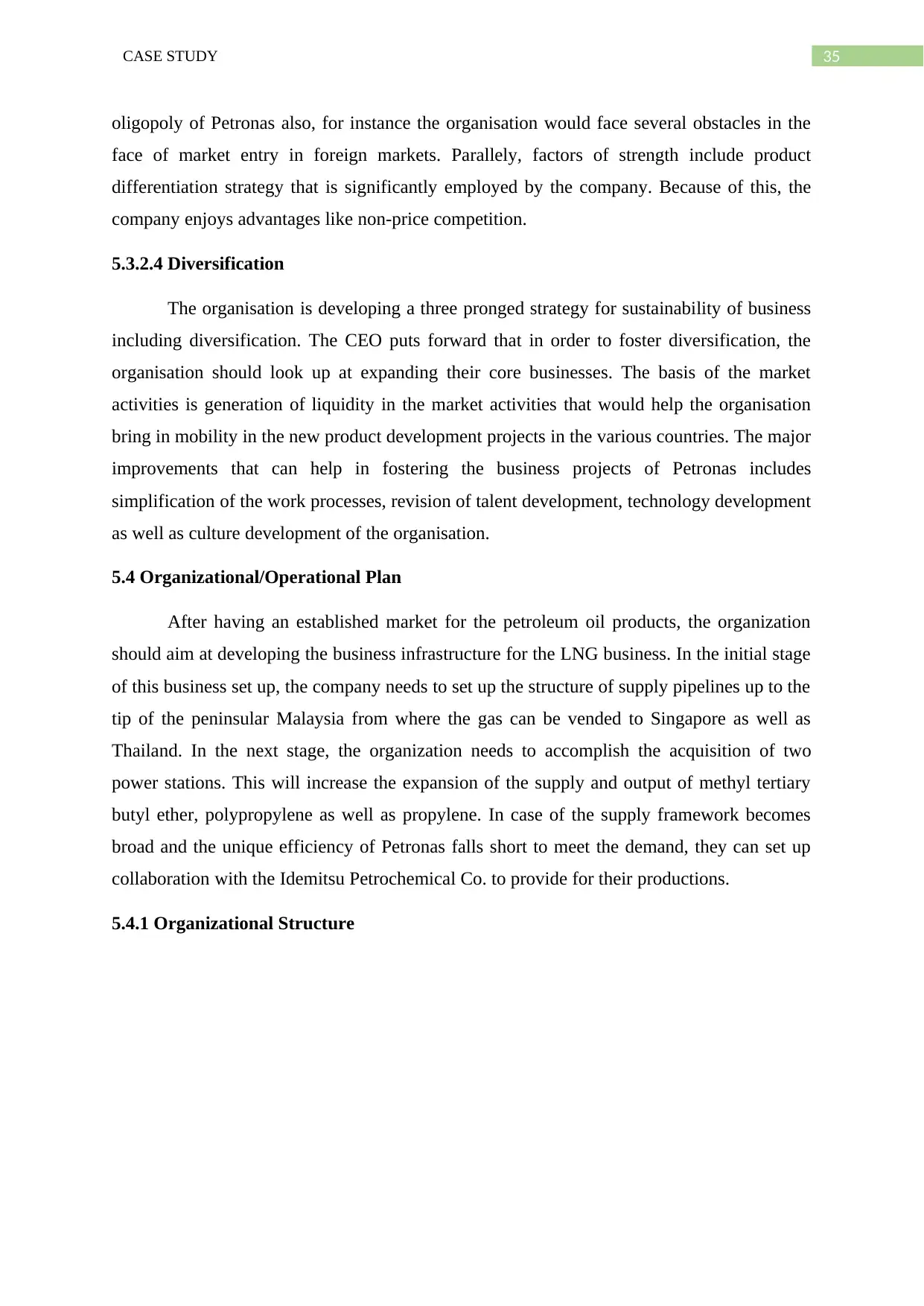
35CASE STUDY
oligopoly of Petronas also, for instance the organisation would face several obstacles in the
face of market entry in foreign markets. Parallely, factors of strength include product
differentiation strategy that is significantly employed by the company. Because of this, the
company enjoys advantages like non-price competition.
5.3.2.4 Diversification
The organisation is developing a three pronged strategy for sustainability of business
including diversification. The CEO puts forward that in order to foster diversification, the
organisation should look up at expanding their core businesses. The basis of the market
activities is generation of liquidity in the market activities that would help the organisation
bring in mobility in the new product development projects in the various countries. The major
improvements that can help in fostering the business projects of Petronas includes
simplification of the work processes, revision of talent development, technology development
as well as culture development of the organisation.
5.4 Organizational/Operational Plan
After having an established market for the petroleum oil products, the organization
should aim at developing the business infrastructure for the LNG business. In the initial stage
of this business set up, the company needs to set up the structure of supply pipelines up to the
tip of the peninsular Malaysia from where the gas can be vended to Singapore as well as
Thailand. In the next stage, the organization needs to accomplish the acquisition of two
power stations. This will increase the expansion of the supply and output of methyl tertiary
butyl ether, polypropylene as well as propylene. In case of the supply framework becomes
broad and the unique efficiency of Petronas falls short to meet the demand, they can set up
collaboration with the Idemitsu Petrochemical Co. to provide for their productions.
5.4.1 Organizational Structure
oligopoly of Petronas also, for instance the organisation would face several obstacles in the
face of market entry in foreign markets. Parallely, factors of strength include product
differentiation strategy that is significantly employed by the company. Because of this, the
company enjoys advantages like non-price competition.
5.3.2.4 Diversification
The organisation is developing a three pronged strategy for sustainability of business
including diversification. The CEO puts forward that in order to foster diversification, the
organisation should look up at expanding their core businesses. The basis of the market
activities is generation of liquidity in the market activities that would help the organisation
bring in mobility in the new product development projects in the various countries. The major
improvements that can help in fostering the business projects of Petronas includes
simplification of the work processes, revision of talent development, technology development
as well as culture development of the organisation.
5.4 Organizational/Operational Plan
After having an established market for the petroleum oil products, the organization
should aim at developing the business infrastructure for the LNG business. In the initial stage
of this business set up, the company needs to set up the structure of supply pipelines up to the
tip of the peninsular Malaysia from where the gas can be vended to Singapore as well as
Thailand. In the next stage, the organization needs to accomplish the acquisition of two
power stations. This will increase the expansion of the supply and output of methyl tertiary
butyl ether, polypropylene as well as propylene. In case of the supply framework becomes
broad and the unique efficiency of Petronas falls short to meet the demand, they can set up
collaboration with the Idemitsu Petrochemical Co. to provide for their productions.
5.4.1 Organizational Structure
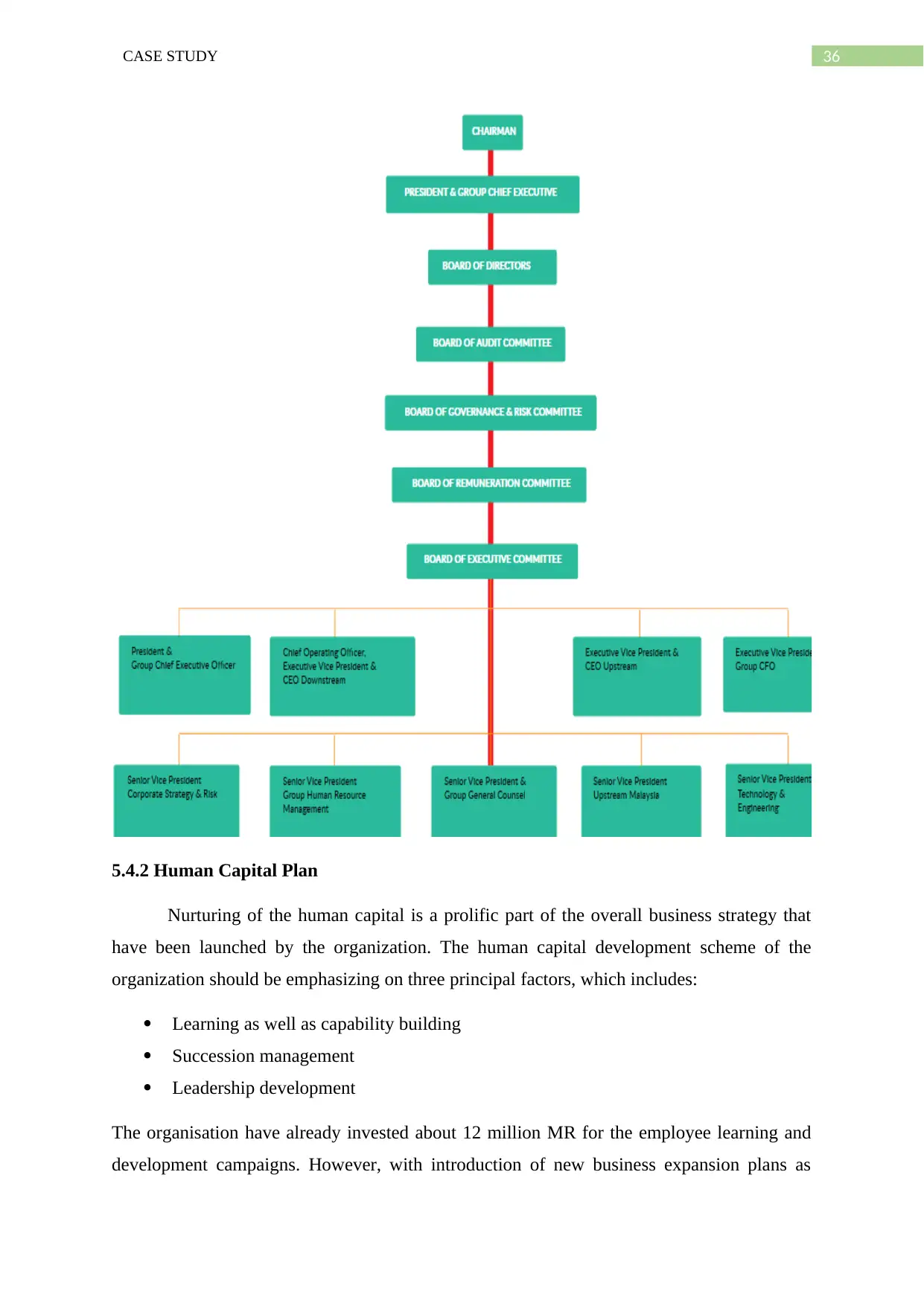
36CASE STUDY
5.4.2 Human Capital Plan
Nurturing of the human capital is a prolific part of the overall business strategy that
have been launched by the organization. The human capital development scheme of the
organization should be emphasizing on three principal factors, which includes:
Learning as well as capability building
Succession management
Leadership development
The organisation have already invested about 12 million MR for the employee learning and
development campaigns. However, with introduction of new business expansion plans as
5.4.2 Human Capital Plan
Nurturing of the human capital is a prolific part of the overall business strategy that
have been launched by the organization. The human capital development scheme of the
organization should be emphasizing on three principal factors, which includes:
Learning as well as capability building
Succession management
Leadership development
The organisation have already invested about 12 million MR for the employee learning and
development campaigns. However, with introduction of new business expansion plans as

37CASE STUDY
well as product diversification, the company needs to increase the training and development
expense by 30%. In terms of the LNG supply in many new countries including Malaysia
itself, the organisation needs to employ people in 39 critical position in order to develop a
parallel managerial structure in the major foreign business hubs like Canada, Mexico and
South East Asia.
5.4.3 Business Process/Value Chain
Value Chain Model Analysis of Petronas
(Source: Developed by the Researcher)
5.5 Financial Plan / Business Metrics
5.5.1 Financial statements
Startup Funds
Sources of Capital Startup Expenses
Owners' Investment (name
& % ownership)
Buildings / Real
Estate
Your name & % ownership 40000000% Purchase
RM.
300,000
Other Investor
600,00
0 Construction
230,
000
Other Investor
3,000,00
0 Remodeling
12,
000
Upstream
Exploration, development as well as production of crude oil in Malaysia as well as overseas
Middle
Stream
liquefaction, sales as well as transportation of liquefied natural gas
shipping as well as logistics related to LNG, crude oil as well as petroleum products
Downstream
refining of oil and marketing of petroleum products
procesing as well as transmission of natural gas as well as sale of petroluem products including
LNG
Manufacture as well as sale of the natural gas products
Trading over crude oil, petroleum products as well as petrochemical products
well as product diversification, the company needs to increase the training and development
expense by 30%. In terms of the LNG supply in many new countries including Malaysia
itself, the organisation needs to employ people in 39 critical position in order to develop a
parallel managerial structure in the major foreign business hubs like Canada, Mexico and
South East Asia.
5.4.3 Business Process/Value Chain
Value Chain Model Analysis of Petronas
(Source: Developed by the Researcher)
5.5 Financial Plan / Business Metrics
5.5.1 Financial statements
Startup Funds
Sources of Capital Startup Expenses
Owners' Investment (name
& % ownership)
Buildings / Real
Estate
Your name & % ownership 40000000% Purchase
RM.
300,000
Other Investor
600,00
0 Construction
230,
000
Other Investor
3,000,00
0 Remodeling
12,
000
Upstream
Exploration, development as well as production of crude oil in Malaysia as well as overseas
Middle
Stream
liquefaction, sales as well as transportation of liquefied natural gas
shipping as well as logistics related to LNG, crude oil as well as petroleum products
Downstream
refining of oil and marketing of petroleum products
procesing as well as transmission of natural gas as well as sale of petroluem products including
LNG
Manufacture as well as sale of the natural gas products
Trading over crude oil, petroleum products as well as petrochemical products
Paraphrase This Document
Need a fresh take? Get an instant paraphrase of this document with our AI Paraphraser
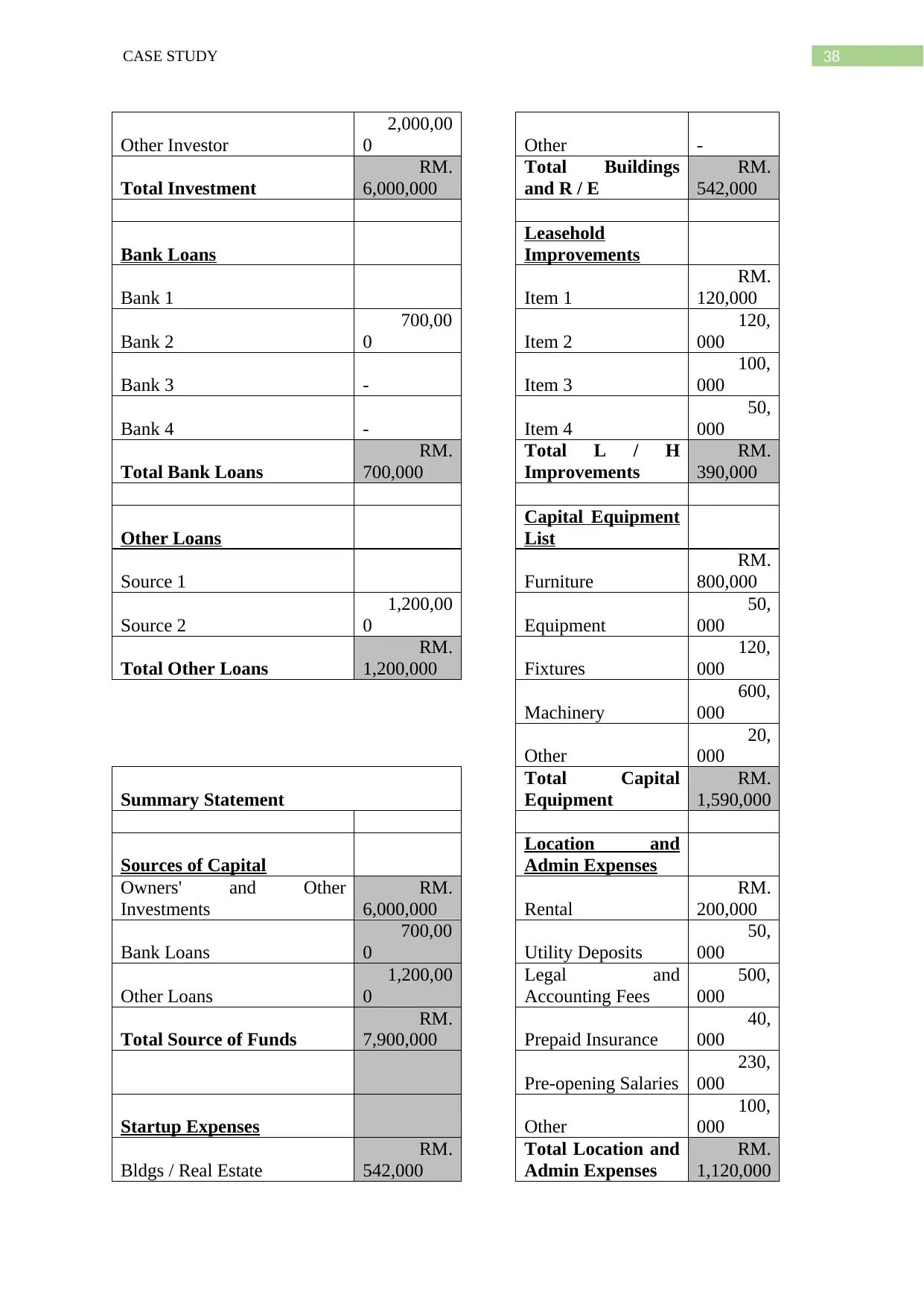
38CASE STUDY
Other Investor
2,000,00
0 Other -
Total Investment
RM.
6,000,000
Total Buildings
and R / E
RM.
542,000
Bank Loans
Leasehold
Improvements
Bank 1 Item 1
RM.
120,000
Bank 2
700,00
0 Item 2
120,
000
Bank 3 - Item 3
100,
000
Bank 4 - Item 4
50,
000
Total Bank Loans
RM.
700,000
Total L / H
Improvements
RM.
390,000
Other Loans
Capital Equipment
List
Source 1 Furniture
RM.
800,000
Source 2
1,200,00
0 Equipment
50,
000
Total Other Loans
RM.
1,200,000 Fixtures
120,
000
Machinery
600,
000
Other
20,
000
Summary Statement
Total Capital
Equipment
RM.
1,590,000
Sources of Capital
Location and
Admin Expenses
Owners' and Other
Investments
RM.
6,000,000 Rental
RM.
200,000
Bank Loans
700,00
0 Utility Deposits
50,
000
Other Loans
1,200,00
0
Legal and
Accounting Fees
500,
000
Total Source of Funds
RM.
7,900,000 Prepaid Insurance
40,
000
Pre-opening Salaries
230,
000
Startup Expenses Other
100,
000
Bldgs / Real Estate
RM.
542,000
Total Location and
Admin Expenses
RM.
1,120,000
Other Investor
2,000,00
0 Other -
Total Investment
RM.
6,000,000
Total Buildings
and R / E
RM.
542,000
Bank Loans
Leasehold
Improvements
Bank 1 Item 1
RM.
120,000
Bank 2
700,00
0 Item 2
120,
000
Bank 3 - Item 3
100,
000
Bank 4 - Item 4
50,
000
Total Bank Loans
RM.
700,000
Total L / H
Improvements
RM.
390,000
Other Loans
Capital Equipment
List
Source 1 Furniture
RM.
800,000
Source 2
1,200,00
0 Equipment
50,
000
Total Other Loans
RM.
1,200,000 Fixtures
120,
000
Machinery
600,
000
Other
20,
000
Summary Statement
Total Capital
Equipment
RM.
1,590,000
Sources of Capital
Location and
Admin Expenses
Owners' and Other
Investments
RM.
6,000,000 Rental
RM.
200,000
Bank Loans
700,00
0 Utility Deposits
50,
000
Other Loans
1,200,00
0
Legal and
Accounting Fees
500,
000
Total Source of Funds
RM.
7,900,000 Prepaid Insurance
40,
000
Pre-opening Salaries
230,
000
Startup Expenses Other
100,
000
Bldgs / Real Estate
RM.
542,000
Total Location and
Admin Expenses
RM.
1,120,000
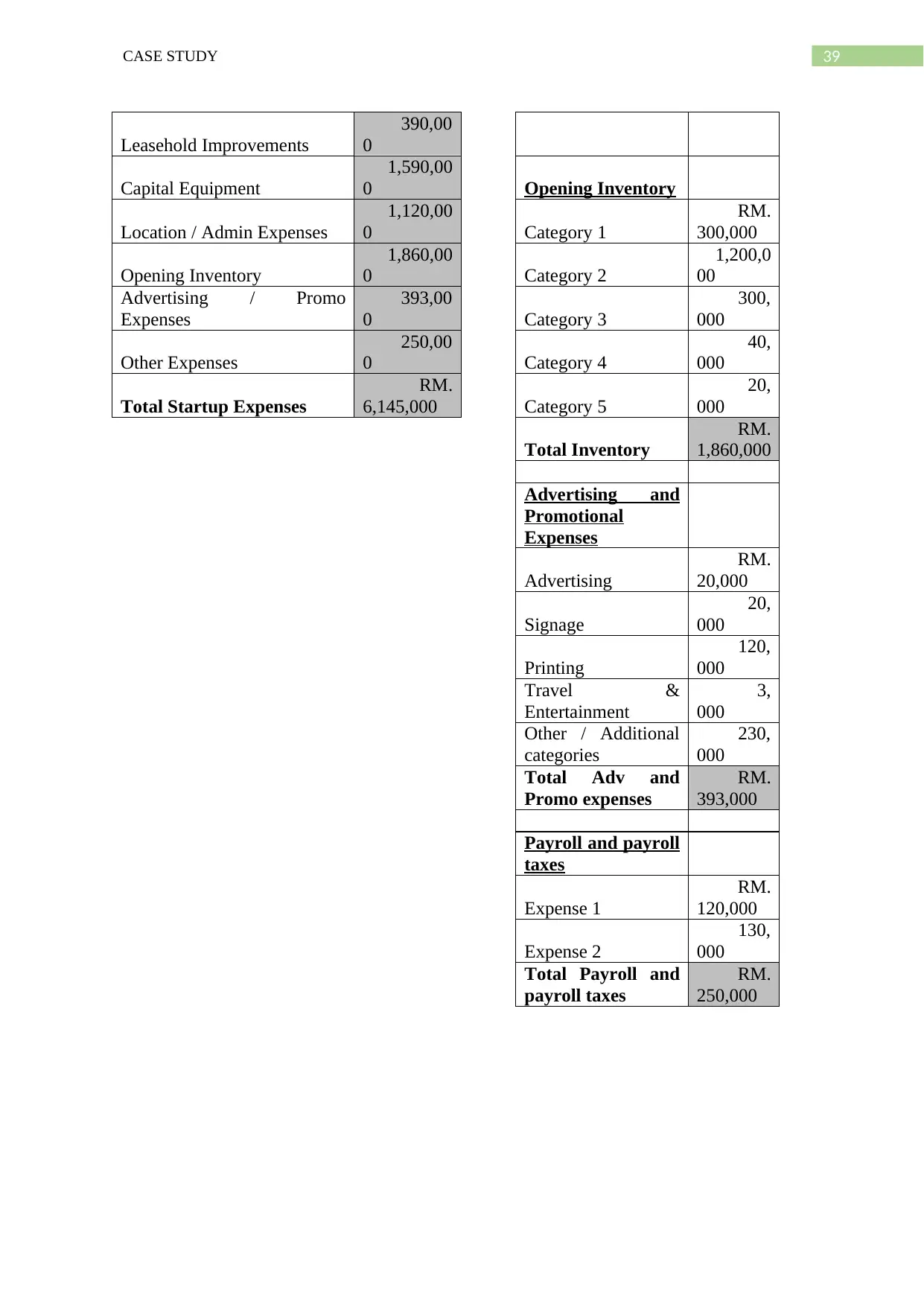
39CASE STUDY
Leasehold Improvements
390,00
0
Capital Equipment
1,590,00
0 Opening Inventory
Location / Admin Expenses
1,120,00
0 Category 1
RM.
300,000
Opening Inventory
1,860,00
0 Category 2
1,200,0
00
Advertising / Promo
Expenses
393,00
0 Category 3
300,
000
Other Expenses
250,00
0 Category 4
40,
000
Total Startup Expenses
RM.
6,145,000 Category 5
20,
000
Total Inventory
RM.
1,860,000
Advertising and
Promotional
Expenses
Advertising
RM.
20,000
Signage
20,
000
Printing
120,
000
Travel &
Entertainment
3,
000
Other / Additional
categories
230,
000
Total Adv and
Promo expenses
RM.
393,000
Payroll and payroll
taxes
Expense 1
RM.
120,000
Expense 2
130,
000
Total Payroll and
payroll taxes
RM.
250,000
Leasehold Improvements
390,00
0
Capital Equipment
1,590,00
0 Opening Inventory
Location / Admin Expenses
1,120,00
0 Category 1
RM.
300,000
Opening Inventory
1,860,00
0 Category 2
1,200,0
00
Advertising / Promo
Expenses
393,00
0 Category 3
300,
000
Other Expenses
250,00
0 Category 4
40,
000
Total Startup Expenses
RM.
6,145,000 Category 5
20,
000
Total Inventory
RM.
1,860,000
Advertising and
Promotional
Expenses
Advertising
RM.
20,000
Signage
20,
000
Printing
120,
000
Travel &
Entertainment
3,
000
Other / Additional
categories
230,
000
Total Adv and
Promo expenses
RM.
393,000
Payroll and payroll
taxes
Expense 1
RM.
120,000
Expense 2
130,
000
Total Payroll and
payroll taxes
RM.
250,000
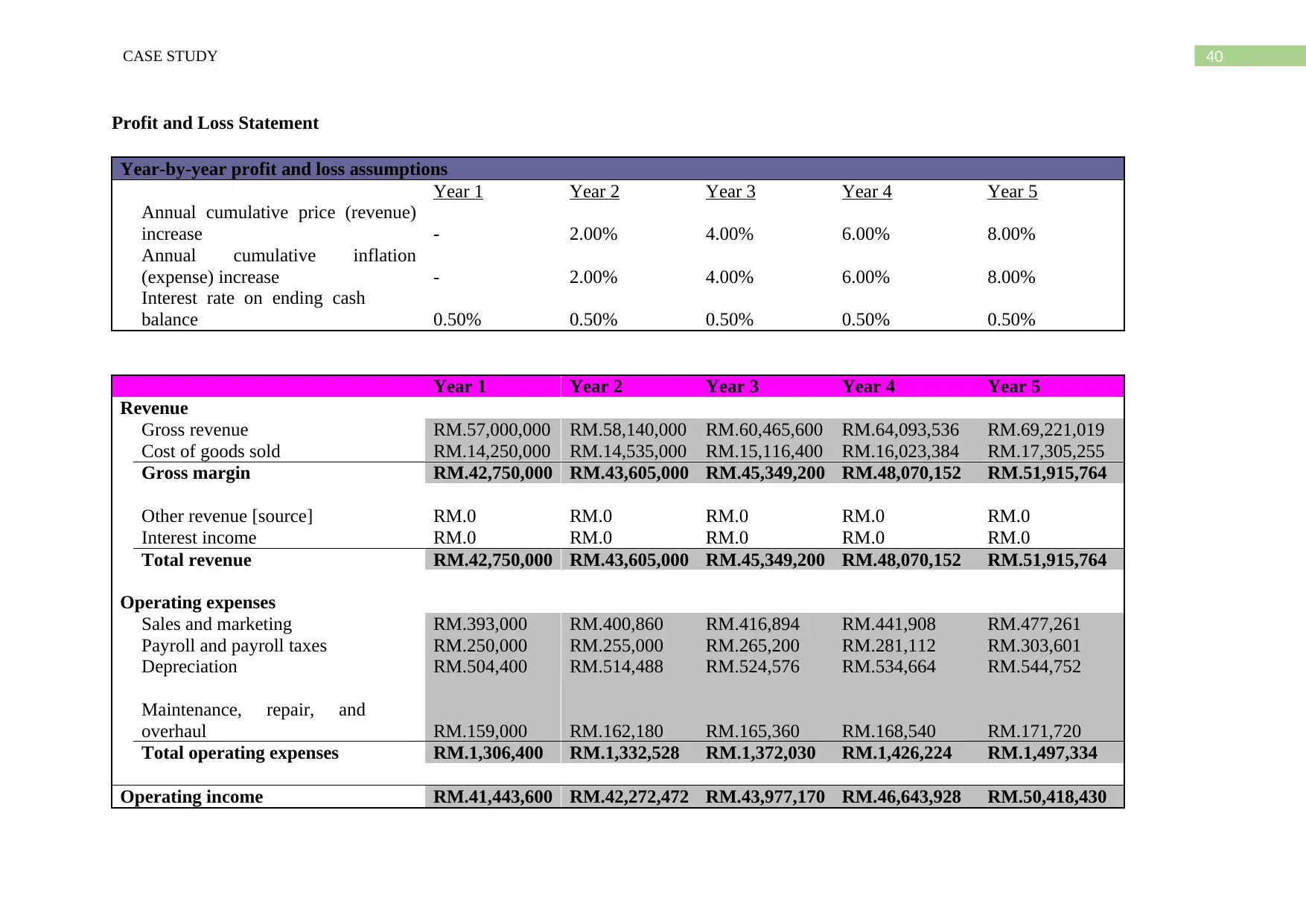
40CASE STUDY
Profit and Loss Statement
Year-by-year profit and loss assumptions
Year 1 Year 2 Year 3 Year 4 Year 5
Annual cumulative price (revenue)
increase - 2.00% 4.00% 6.00% 8.00%
Annual cumulative inflation
(expense) increase - 2.00% 4.00% 6.00% 8.00%
Interest rate on ending cash
balance 0.50% 0.50% 0.50% 0.50% 0.50%
Year 1 Year 2 Year 3 Year 4 Year 5
Revenue
Gross revenue RM.57,000,000 RM.58,140,000 RM.60,465,600 RM.64,093,536 RM.69,221,019
Cost of goods sold RM.14,250,000 RM.14,535,000 RM.15,116,400 RM.16,023,384 RM.17,305,255
Gross margin RM.42,750,000 RM.43,605,000 RM.45,349,200 RM.48,070,152 RM.51,915,764
Other revenue [source] RM.0 RM.0 RM.0 RM.0 RM.0
Interest income RM.0 RM.0 RM.0 RM.0 RM.0
Total revenue RM.42,750,000 RM.43,605,000 RM.45,349,200 RM.48,070,152 RM.51,915,764
Operating expenses
Sales and marketing RM.393,000 RM.400,860 RM.416,894 RM.441,908 RM.477,261
Payroll and payroll taxes RM.250,000 RM.255,000 RM.265,200 RM.281,112 RM.303,601
Depreciation RM.504,400 RM.514,488 RM.524,576 RM.534,664 RM.544,752
Maintenance, repair, and
overhaul RM.159,000 RM.162,180 RM.165,360 RM.168,540 RM.171,720
Total operating expenses RM.1,306,400 RM.1,332,528 RM.1,372,030 RM.1,426,224 RM.1,497,334
Operating income RM.41,443,600 RM.42,272,472 RM.43,977,170 RM.46,643,928 RM.50,418,430
Profit and Loss Statement
Year-by-year profit and loss assumptions
Year 1 Year 2 Year 3 Year 4 Year 5
Annual cumulative price (revenue)
increase - 2.00% 4.00% 6.00% 8.00%
Annual cumulative inflation
(expense) increase - 2.00% 4.00% 6.00% 8.00%
Interest rate on ending cash
balance 0.50% 0.50% 0.50% 0.50% 0.50%
Year 1 Year 2 Year 3 Year 4 Year 5
Revenue
Gross revenue RM.57,000,000 RM.58,140,000 RM.60,465,600 RM.64,093,536 RM.69,221,019
Cost of goods sold RM.14,250,000 RM.14,535,000 RM.15,116,400 RM.16,023,384 RM.17,305,255
Gross margin RM.42,750,000 RM.43,605,000 RM.45,349,200 RM.48,070,152 RM.51,915,764
Other revenue [source] RM.0 RM.0 RM.0 RM.0 RM.0
Interest income RM.0 RM.0 RM.0 RM.0 RM.0
Total revenue RM.42,750,000 RM.43,605,000 RM.45,349,200 RM.48,070,152 RM.51,915,764
Operating expenses
Sales and marketing RM.393,000 RM.400,860 RM.416,894 RM.441,908 RM.477,261
Payroll and payroll taxes RM.250,000 RM.255,000 RM.265,200 RM.281,112 RM.303,601
Depreciation RM.504,400 RM.514,488 RM.524,576 RM.534,664 RM.544,752
Maintenance, repair, and
overhaul RM.159,000 RM.162,180 RM.165,360 RM.168,540 RM.171,720
Total operating expenses RM.1,306,400 RM.1,332,528 RM.1,372,030 RM.1,426,224 RM.1,497,334
Operating income RM.41,443,600 RM.42,272,472 RM.43,977,170 RM.46,643,928 RM.50,418,430
Secure Best Marks with AI Grader
Need help grading? Try our AI Grader for instant feedback on your assignments.
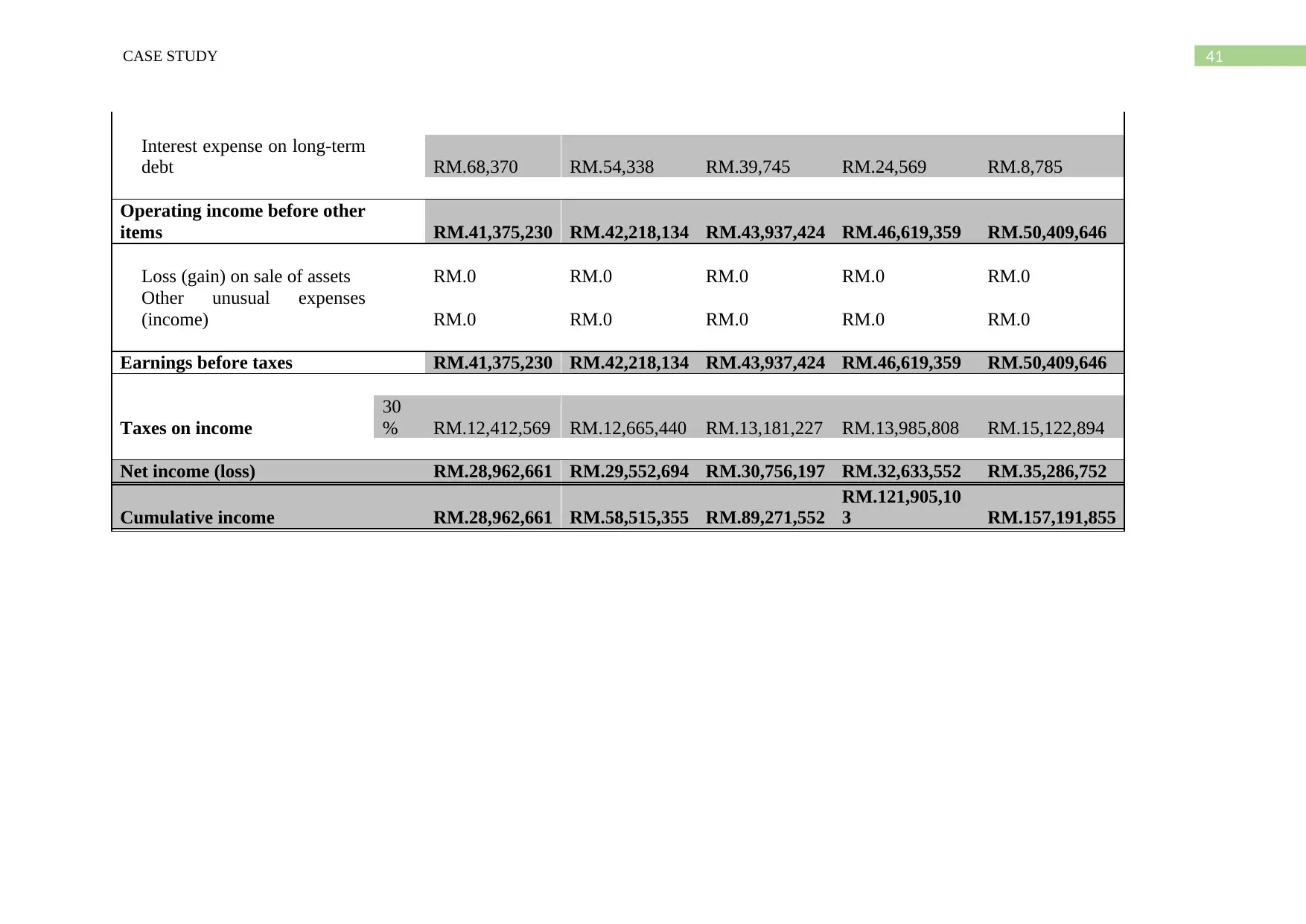
41CASE STUDY
Interest expense on long-term
debt RM.68,370 RM.54,338 RM.39,745 RM.24,569 RM.8,785
Operating income before other
items RM.41,375,230 RM.42,218,134 RM.43,937,424 RM.46,619,359 RM.50,409,646
Loss (gain) on sale of assets RM.0 RM.0 RM.0 RM.0 RM.0
Other unusual expenses
(income) RM.0 RM.0 RM.0 RM.0 RM.0
Earnings before taxes RM.41,375,230 RM.42,218,134 RM.43,937,424 RM.46,619,359 RM.50,409,646
Taxes on income
30
% RM.12,412,569 RM.12,665,440 RM.13,181,227 RM.13,985,808 RM.15,122,894
Net income (loss) RM.28,962,661 RM.29,552,694 RM.30,756,197 RM.32,633,552 RM.35,286,752
Cumulative income RM.28,962,661 RM.58,515,355 RM.89,271,552
RM.121,905,10
3 RM.157,191,855
Interest expense on long-term
debt RM.68,370 RM.54,338 RM.39,745 RM.24,569 RM.8,785
Operating income before other
items RM.41,375,230 RM.42,218,134 RM.43,937,424 RM.46,619,359 RM.50,409,646
Loss (gain) on sale of assets RM.0 RM.0 RM.0 RM.0 RM.0
Other unusual expenses
(income) RM.0 RM.0 RM.0 RM.0 RM.0
Earnings before taxes RM.41,375,230 RM.42,218,134 RM.43,937,424 RM.46,619,359 RM.50,409,646
Taxes on income
30
% RM.12,412,569 RM.12,665,440 RM.13,181,227 RM.13,985,808 RM.15,122,894
Net income (loss) RM.28,962,661 RM.29,552,694 RM.30,756,197 RM.32,633,552 RM.35,286,752
Cumulative income RM.28,962,661 RM.58,515,355 RM.89,271,552
RM.121,905,10
3 RM.157,191,855
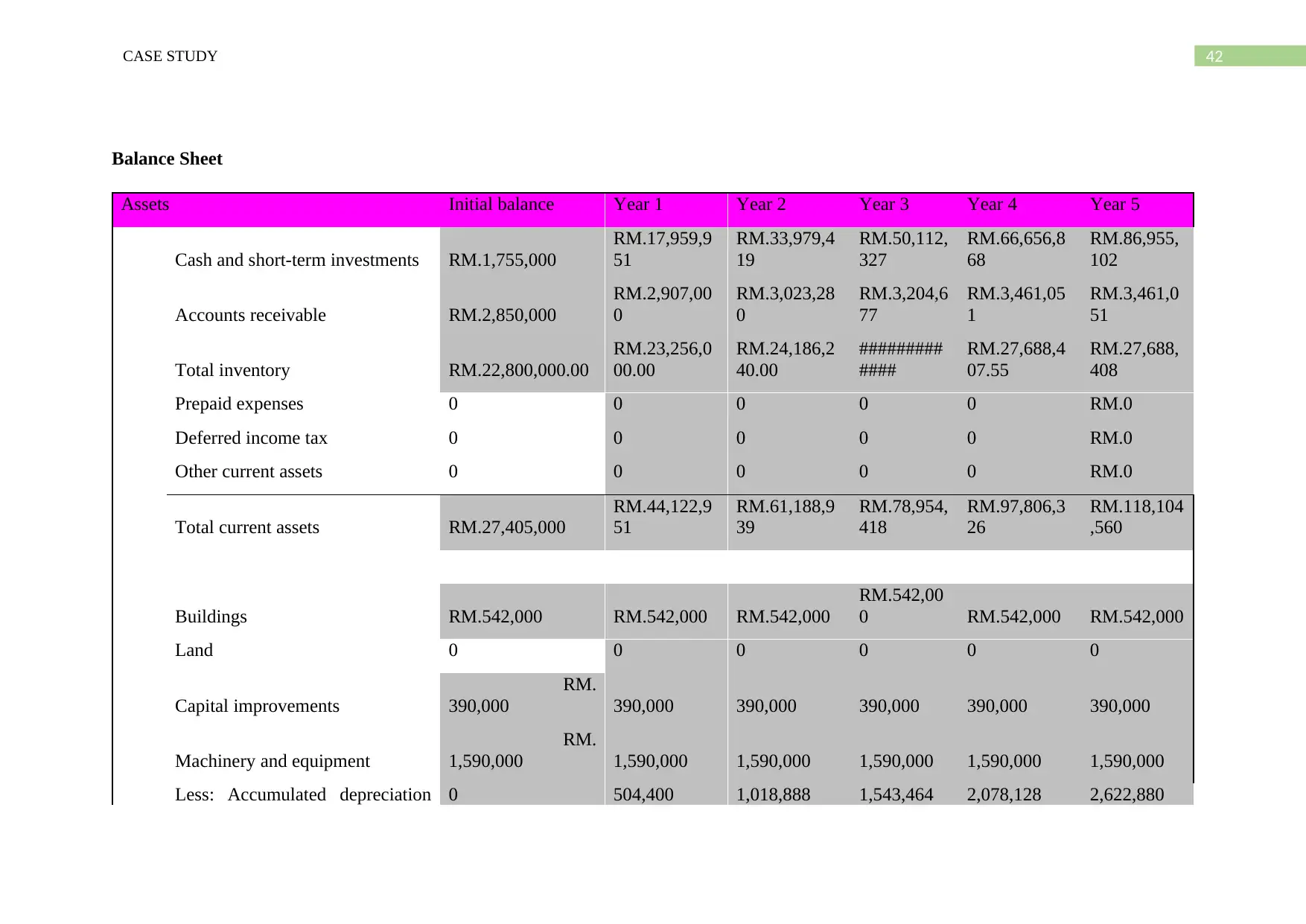
42CASE STUDY
Balance Sheet
Assets Initial balance Year 1 Year 2 Year 3 Year 4 Year 5
Cash and short-term investments RM.1,755,000
RM.17,959,9
51
RM.33,979,4
19
RM.50,112,
327
RM.66,656,8
68
RM.86,955,
102
Accounts receivable RM.2,850,000
RM.2,907,00
0
RM.3,023,28
0
RM.3,204,6
77
RM.3,461,05
1
RM.3,461,0
51
Total inventory RM.22,800,000.00
RM.23,256,0
00.00
RM.24,186,2
40.00
#########
####
RM.27,688,4
07.55
RM.27,688,
408
Prepaid expenses 0 0 0 0 0 RM.0
Deferred income tax 0 0 0 0 0 RM.0
Other current assets 0 0 0 0 0 RM.0
Total current assets RM.27,405,000
RM.44,122,9
51
RM.61,188,9
39
RM.78,954,
418
RM.97,806,3
26
RM.118,104
,560
Buildings RM.542,000 RM.542,000 RM.542,000
RM.542,00
0 RM.542,000 RM.542,000
Land 0 0 0 0 0 0
Capital improvements
RM.
390,000 390,000 390,000 390,000 390,000 390,000
Machinery and equipment
RM.
1,590,000 1,590,000 1,590,000 1,590,000 1,590,000 1,590,000
Less: Accumulated depreciation 0 504,400 1,018,888 1,543,464 2,078,128 2,622,880
Balance Sheet
Assets Initial balance Year 1 Year 2 Year 3 Year 4 Year 5
Cash and short-term investments RM.1,755,000
RM.17,959,9
51
RM.33,979,4
19
RM.50,112,
327
RM.66,656,8
68
RM.86,955,
102
Accounts receivable RM.2,850,000
RM.2,907,00
0
RM.3,023,28
0
RM.3,204,6
77
RM.3,461,05
1
RM.3,461,0
51
Total inventory RM.22,800,000.00
RM.23,256,0
00.00
RM.24,186,2
40.00
#########
####
RM.27,688,4
07.55
RM.27,688,
408
Prepaid expenses 0 0 0 0 0 RM.0
Deferred income tax 0 0 0 0 0 RM.0
Other current assets 0 0 0 0 0 RM.0
Total current assets RM.27,405,000
RM.44,122,9
51
RM.61,188,9
39
RM.78,954,
418
RM.97,806,3
26
RM.118,104
,560
Buildings RM.542,000 RM.542,000 RM.542,000
RM.542,00
0 RM.542,000 RM.542,000
Land 0 0 0 0 0 0
Capital improvements
RM.
390,000 390,000 390,000 390,000 390,000 390,000
Machinery and equipment
RM.
1,590,000 1,590,000 1,590,000 1,590,000 1,590,000 1,590,000
Less: Accumulated depreciation 0 504,400 1,018,888 1,543,464 2,078,128 2,622,880
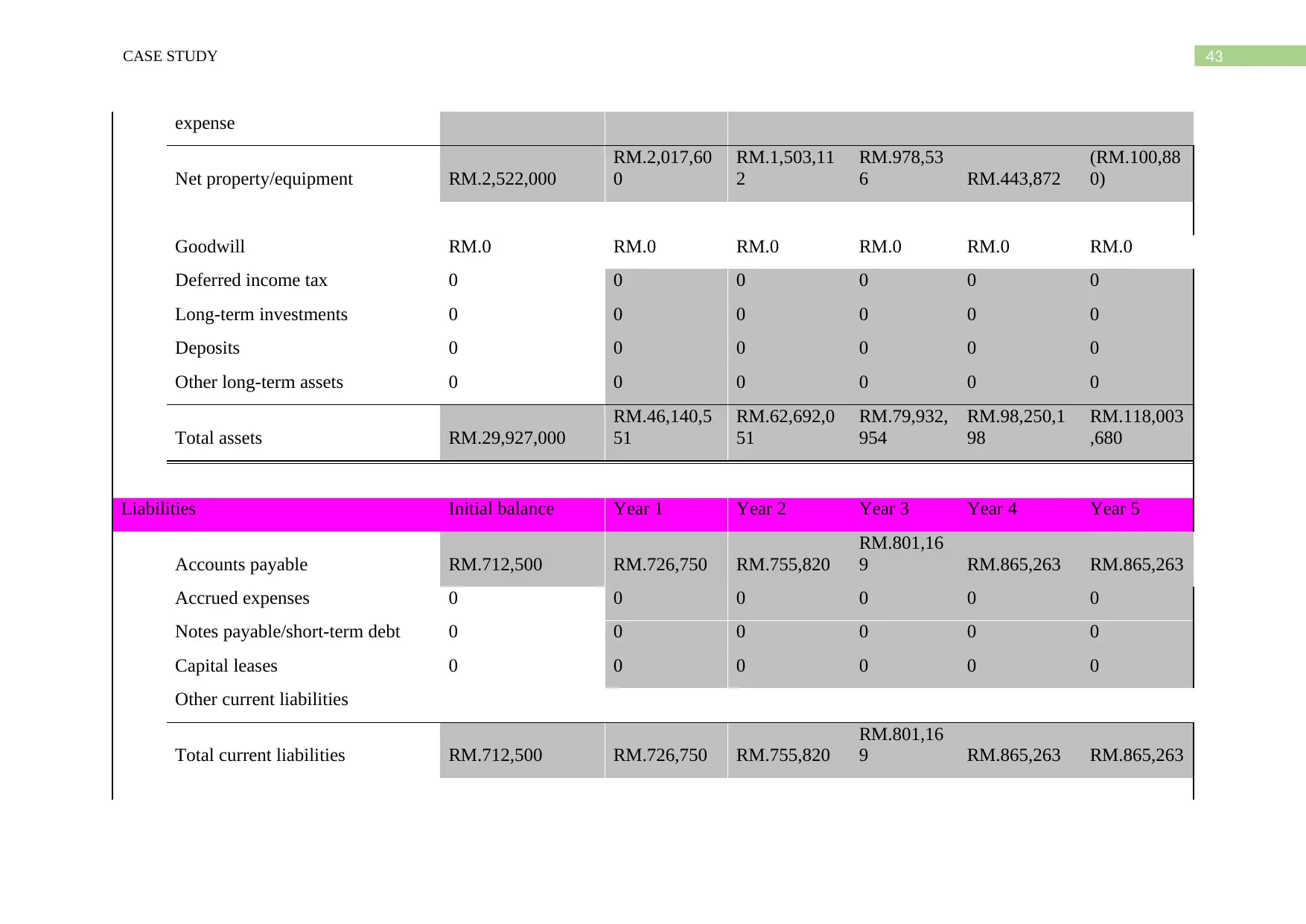
43CASE STUDY
expense
Net property/equipment RM.2,522,000
RM.2,017,60
0
RM.1,503,11
2
RM.978,53
6 RM.443,872
(RM.100,88
0)
Goodwill RM.0 RM.0 RM.0 RM.0 RM.0 RM.0
Deferred income tax 0 0 0 0 0 0
Long-term investments 0 0 0 0 0 0
Deposits 0 0 0 0 0 0
Other long-term assets 0 0 0 0 0 0
Total assets RM.29,927,000
RM.46,140,5
51
RM.62,692,0
51
RM.79,932,
954
RM.98,250,1
98
RM.118,003
,680
Liabilities Initial balance Year 1 Year 2 Year 3 Year 4 Year 5
Accounts payable RM.712,500 RM.726,750 RM.755,820
RM.801,16
9 RM.865,263 RM.865,263
Accrued expenses 0 0 0 0 0 0
Notes payable/short-term debt 0 0 0 0 0 0
Capital leases 0 0 0 0 0 0
Other current liabilities
Total current liabilities RM.712,500 RM.726,750 RM.755,820
RM.801,16
9 RM.865,263 RM.865,263
expense
Net property/equipment RM.2,522,000
RM.2,017,60
0
RM.1,503,11
2
RM.978,53
6 RM.443,872
(RM.100,88
0)
Goodwill RM.0 RM.0 RM.0 RM.0 RM.0 RM.0
Deferred income tax 0 0 0 0 0 0
Long-term investments 0 0 0 0 0 0
Deposits 0 0 0 0 0 0
Other long-term assets 0 0 0 0 0 0
Total assets RM.29,927,000
RM.46,140,5
51
RM.62,692,0
51
RM.79,932,
954
RM.98,250,1
98
RM.118,003
,680
Liabilities Initial balance Year 1 Year 2 Year 3 Year 4 Year 5
Accounts payable RM.712,500 RM.726,750 RM.755,820
RM.801,16
9 RM.865,263 RM.865,263
Accrued expenses 0 0 0 0 0 0
Notes payable/short-term debt 0 0 0 0 0 0
Capital leases 0 0 0 0 0 0
Other current liabilities
Total current liabilities RM.712,500 RM.726,750 RM.755,820
RM.801,16
9 RM.865,263 RM.865,263
Paraphrase This Document
Need a fresh take? Get an instant paraphrase of this document with our AI Paraphraser
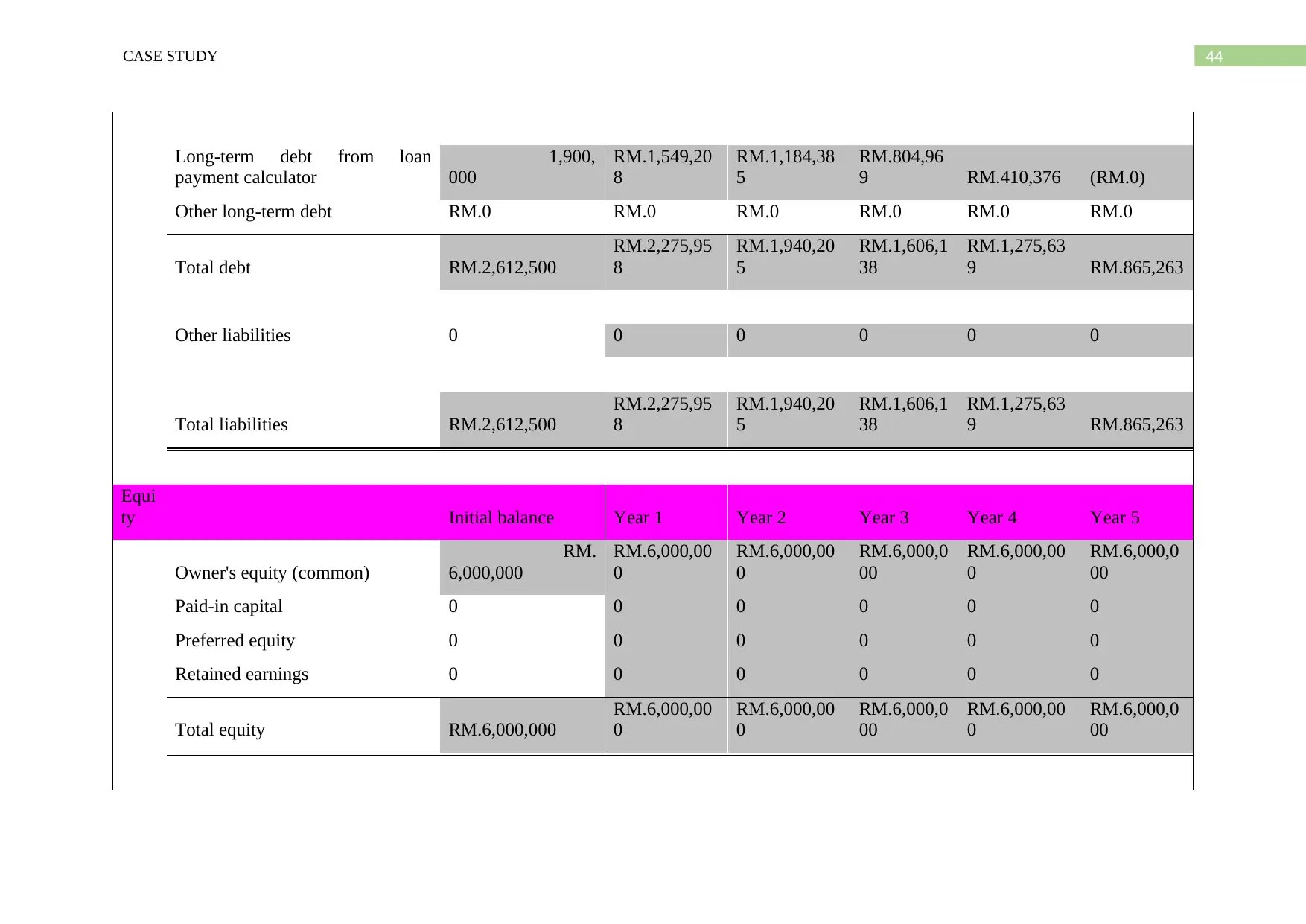
44CASE STUDY
Long-term debt from loan
payment calculator
1,900,
000
RM.1,549,20
8
RM.1,184,38
5
RM.804,96
9 RM.410,376 (RM.0)
Other long-term debt RM.0 RM.0 RM.0 RM.0 RM.0 RM.0
Total debt RM.2,612,500
RM.2,275,95
8
RM.1,940,20
5
RM.1,606,1
38
RM.1,275,63
9 RM.865,263
Other liabilities 0 0 0 0 0 0
Total liabilities RM.2,612,500
RM.2,275,95
8
RM.1,940,20
5
RM.1,606,1
38
RM.1,275,63
9 RM.865,263
Equi
ty Initial balance Year 1 Year 2 Year 3 Year 4 Year 5
Owner's equity (common)
RM.
6,000,000
RM.6,000,00
0
RM.6,000,00
0
RM.6,000,0
00
RM.6,000,00
0
RM.6,000,0
00
Paid-in capital 0 0 0 0 0 0
Preferred equity 0 0 0 0 0 0
Retained earnings 0 0 0 0 0 0
Total equity RM.6,000,000
RM.6,000,00
0
RM.6,000,00
0
RM.6,000,0
00
RM.6,000,00
0
RM.6,000,0
00
Long-term debt from loan
payment calculator
1,900,
000
RM.1,549,20
8
RM.1,184,38
5
RM.804,96
9 RM.410,376 (RM.0)
Other long-term debt RM.0 RM.0 RM.0 RM.0 RM.0 RM.0
Total debt RM.2,612,500
RM.2,275,95
8
RM.1,940,20
5
RM.1,606,1
38
RM.1,275,63
9 RM.865,263
Other liabilities 0 0 0 0 0 0
Total liabilities RM.2,612,500
RM.2,275,95
8
RM.1,940,20
5
RM.1,606,1
38
RM.1,275,63
9 RM.865,263
Equi
ty Initial balance Year 1 Year 2 Year 3 Year 4 Year 5
Owner's equity (common)
RM.
6,000,000
RM.6,000,00
0
RM.6,000,00
0
RM.6,000,0
00
RM.6,000,00
0
RM.6,000,0
00
Paid-in capital 0 0 0 0 0 0
Preferred equity 0 0 0 0 0 0
Retained earnings 0 0 0 0 0 0
Total equity RM.6,000,000
RM.6,000,00
0
RM.6,000,00
0
RM.6,000,0
00
RM.6,000,00
0
RM.6,000,0
00
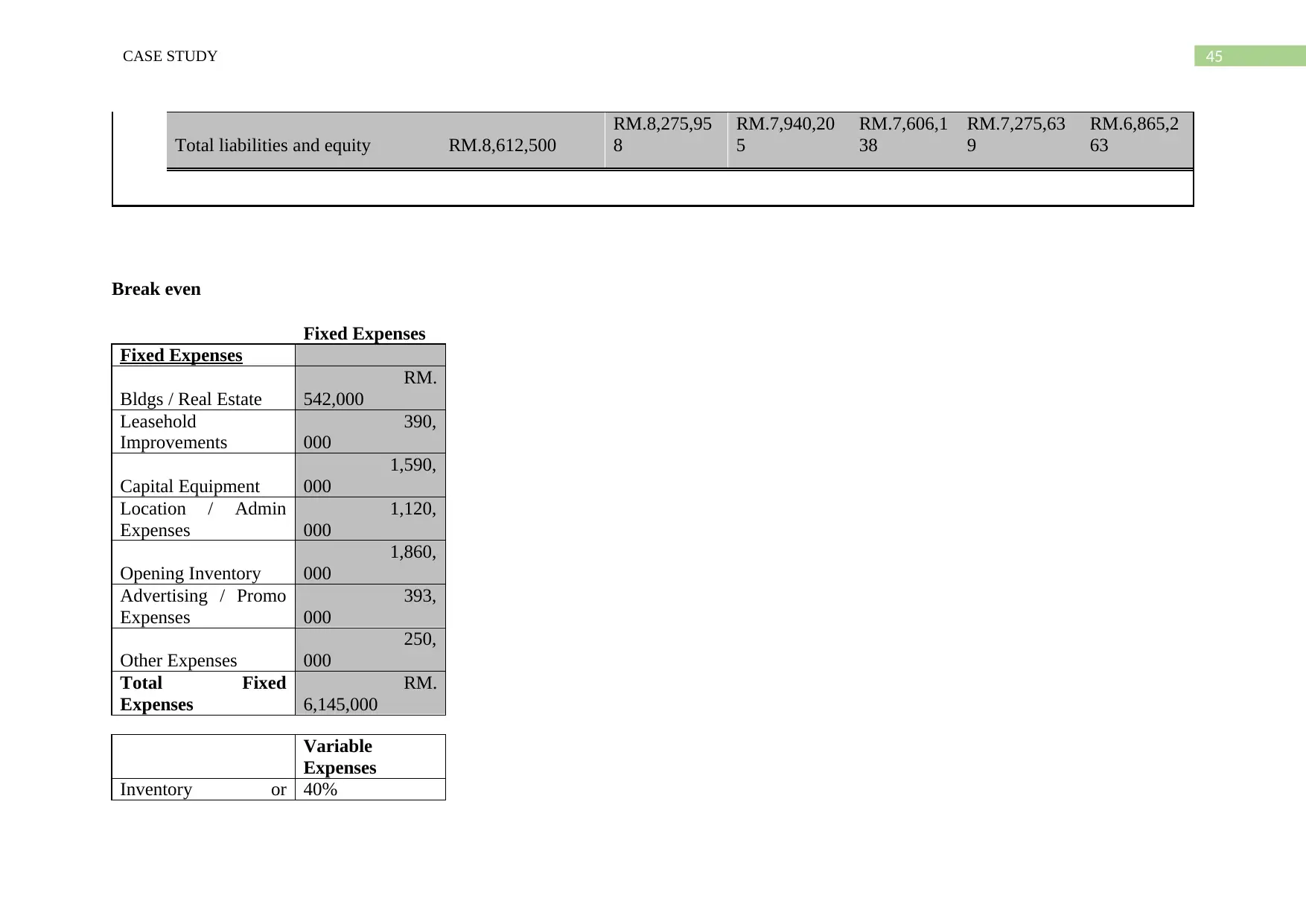
45CASE STUDY
Total liabilities and equity RM.8,612,500
RM.8,275,95
8
RM.7,940,20
5
RM.7,606,1
38
RM.7,275,63
9
RM.6,865,2
63
Break even
Fixed Expenses
Fixed Expenses
Bldgs / Real Estate
RM.
542,000
Leasehold
Improvements
390,
000
Capital Equipment
1,590,
000
Location / Admin
Expenses
1,120,
000
Opening Inventory
1,860,
000
Advertising / Promo
Expenses
393,
000
Other Expenses
250,
000
Total Fixed
Expenses
RM.
6,145,000
Variable
Expenses
Inventory or 40%
Total liabilities and equity RM.8,612,500
RM.8,275,95
8
RM.7,940,20
5
RM.7,606,1
38
RM.7,275,63
9
RM.6,865,2
63
Break even
Fixed Expenses
Fixed Expenses
Bldgs / Real Estate
RM.
542,000
Leasehold
Improvements
390,
000
Capital Equipment
1,590,
000
Location / Admin
Expenses
1,120,
000
Opening Inventory
1,860,
000
Advertising / Promo
Expenses
393,
000
Other Expenses
250,
000
Total Fixed
Expenses
RM.
6,145,000
Variable
Expenses
Inventory or 40%
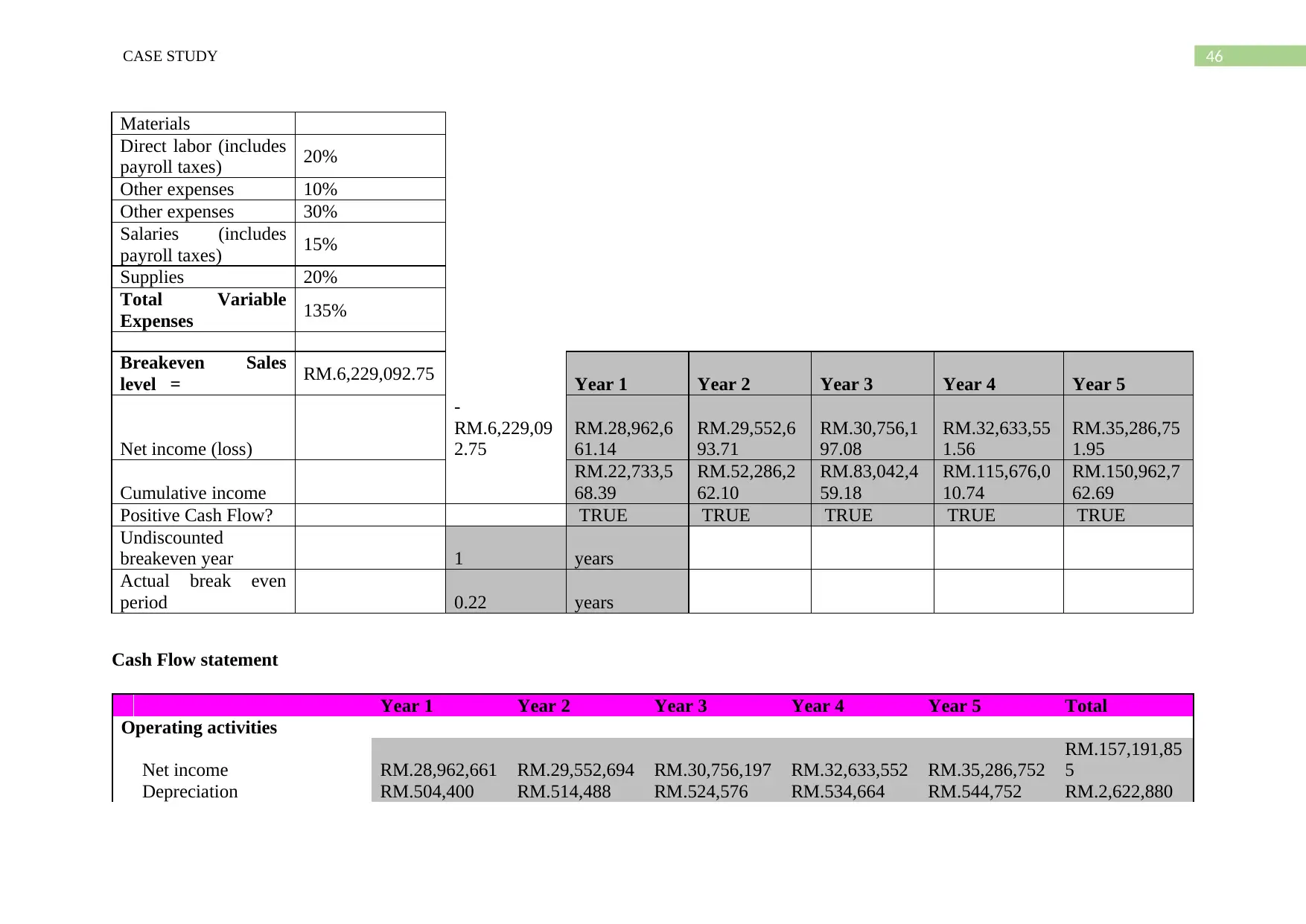
46CASE STUDY
Materials
Direct labor (includes
payroll taxes) 20%
Other expenses 10%
Other expenses 30%
Salaries (includes
payroll taxes) 15%
Supplies 20%
Total Variable
Expenses 135%
Breakeven Sales
level = RM.6,229,092.75 Year 1 Year 2 Year 3 Year 4 Year 5
Net income (loss)
-
RM.6,229,09
2.75
RM.28,962,6
61.14
RM.29,552,6
93.71
RM.30,756,1
97.08
RM.32,633,55
1.56
RM.35,286,75
1.95
Cumulative income
RM.22,733,5
68.39
RM.52,286,2
62.10
RM.83,042,4
59.18
RM.115,676,0
10.74
RM.150,962,7
62.69
Positive Cash Flow? TRUE TRUE TRUE TRUE TRUE
Undiscounted
breakeven year 1 years
Actual break even
period 0.22 years
Cash Flow statement
Year 1 Year 2 Year 3 Year 4 Year 5 Total
Operating activities
Net income RM.28,962,661 RM.29,552,694 RM.30,756,197 RM.32,633,552 RM.35,286,752
RM.157,191,85
5
Depreciation RM.504,400 RM.514,488 RM.524,576 RM.534,664 RM.544,752 RM.2,622,880
Materials
Direct labor (includes
payroll taxes) 20%
Other expenses 10%
Other expenses 30%
Salaries (includes
payroll taxes) 15%
Supplies 20%
Total Variable
Expenses 135%
Breakeven Sales
level = RM.6,229,092.75 Year 1 Year 2 Year 3 Year 4 Year 5
Net income (loss)
-
RM.6,229,09
2.75
RM.28,962,6
61.14
RM.29,552,6
93.71
RM.30,756,1
97.08
RM.32,633,55
1.56
RM.35,286,75
1.95
Cumulative income
RM.22,733,5
68.39
RM.52,286,2
62.10
RM.83,042,4
59.18
RM.115,676,0
10.74
RM.150,962,7
62.69
Positive Cash Flow? TRUE TRUE TRUE TRUE TRUE
Undiscounted
breakeven year 1 years
Actual break even
period 0.22 years
Cash Flow statement
Year 1 Year 2 Year 3 Year 4 Year 5 Total
Operating activities
Net income RM.28,962,661 RM.29,552,694 RM.30,756,197 RM.32,633,552 RM.35,286,752
RM.157,191,85
5
Depreciation RM.504,400 RM.514,488 RM.524,576 RM.534,664 RM.544,752 RM.2,622,880
Secure Best Marks with AI Grader
Need help grading? Try our AI Grader for instant feedback on your assignments.
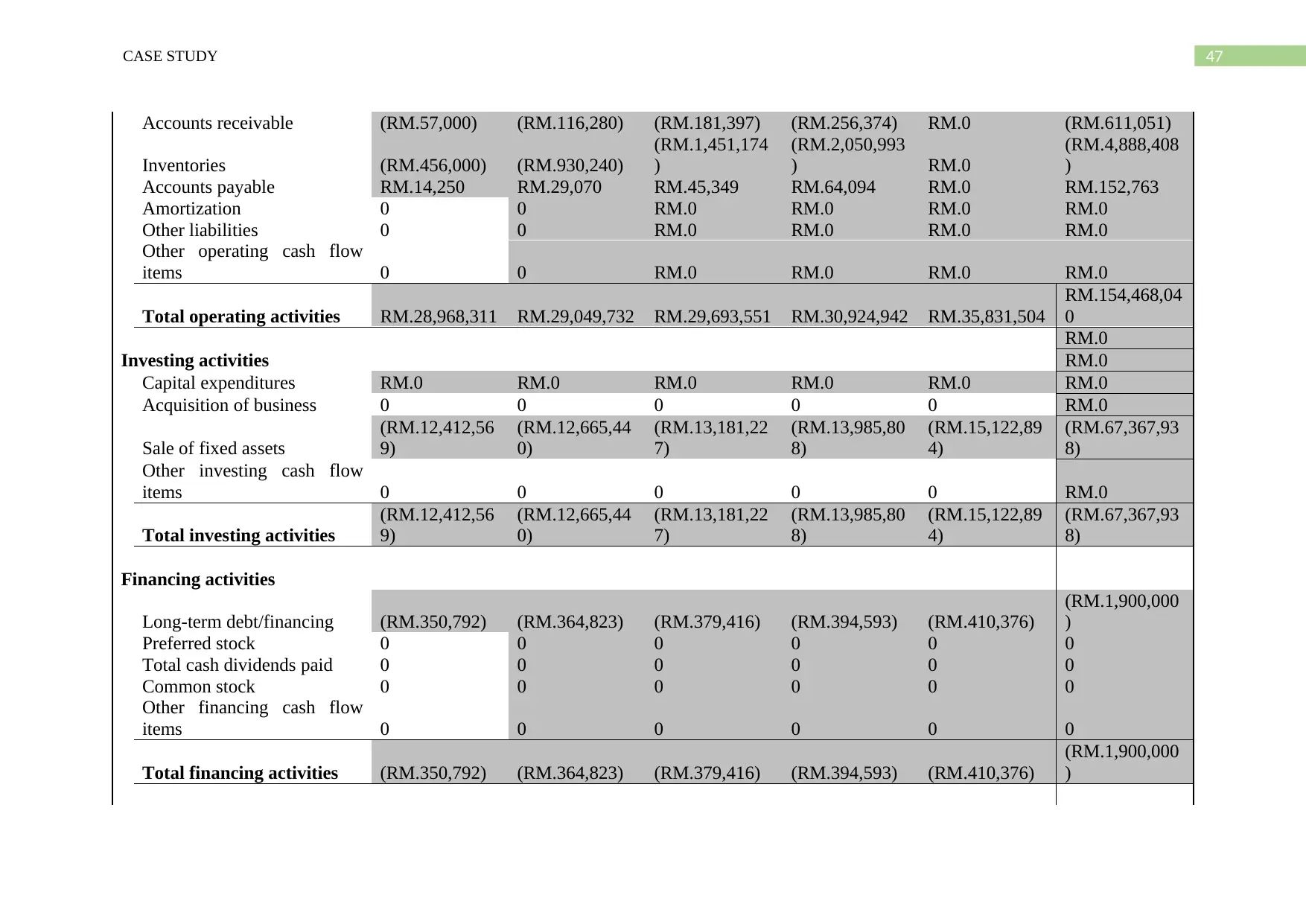
47CASE STUDY
Accounts receivable (RM.57,000) (RM.116,280) (RM.181,397) (RM.256,374) RM.0 (RM.611,051)
Inventories (RM.456,000) (RM.930,240)
(RM.1,451,174
)
(RM.2,050,993
) RM.0
(RM.4,888,408
)
Accounts payable RM.14,250 RM.29,070 RM.45,349 RM.64,094 RM.0 RM.152,763
Amortization 0 0 RM.0 RM.0 RM.0 RM.0
Other liabilities 0 0 RM.0 RM.0 RM.0 RM.0
Other operating cash flow
items 0 0 RM.0 RM.0 RM.0 RM.0
Total operating activities RM.28,968,311 RM.29,049,732 RM.29,693,551 RM.30,924,942 RM.35,831,504
RM.154,468,04
0
RM.0
Investing activities RM.0
Capital expenditures RM.0 RM.0 RM.0 RM.0 RM.0 RM.0
Acquisition of business 0 0 0 0 0 RM.0
Sale of fixed assets
(RM.12,412,56
9)
(RM.12,665,44
0)
(RM.13,181,22
7)
(RM.13,985,80
8)
(RM.15,122,89
4)
(RM.67,367,93
8)
Other investing cash flow
items 0 0 0 0 0 RM.0
Total investing activities
(RM.12,412,56
9)
(RM.12,665,44
0)
(RM.13,181,22
7)
(RM.13,985,80
8)
(RM.15,122,89
4)
(RM.67,367,93
8)
Financing activities
Long-term debt/financing (RM.350,792) (RM.364,823) (RM.379,416) (RM.394,593) (RM.410,376)
(RM.1,900,000
)
Preferred stock 0 0 0 0 0 0
Total cash dividends paid 0 0 0 0 0 0
Common stock 0 0 0 0 0 0
Other financing cash flow
items 0 0 0 0 0 0
Total financing activities (RM.350,792) (RM.364,823) (RM.379,416) (RM.394,593) (RM.410,376)
(RM.1,900,000
)
Accounts receivable (RM.57,000) (RM.116,280) (RM.181,397) (RM.256,374) RM.0 (RM.611,051)
Inventories (RM.456,000) (RM.930,240)
(RM.1,451,174
)
(RM.2,050,993
) RM.0
(RM.4,888,408
)
Accounts payable RM.14,250 RM.29,070 RM.45,349 RM.64,094 RM.0 RM.152,763
Amortization 0 0 RM.0 RM.0 RM.0 RM.0
Other liabilities 0 0 RM.0 RM.0 RM.0 RM.0
Other operating cash flow
items 0 0 RM.0 RM.0 RM.0 RM.0
Total operating activities RM.28,968,311 RM.29,049,732 RM.29,693,551 RM.30,924,942 RM.35,831,504
RM.154,468,04
0
RM.0
Investing activities RM.0
Capital expenditures RM.0 RM.0 RM.0 RM.0 RM.0 RM.0
Acquisition of business 0 0 0 0 0 RM.0
Sale of fixed assets
(RM.12,412,56
9)
(RM.12,665,44
0)
(RM.13,181,22
7)
(RM.13,985,80
8)
(RM.15,122,89
4)
(RM.67,367,93
8)
Other investing cash flow
items 0 0 0 0 0 RM.0
Total investing activities
(RM.12,412,56
9)
(RM.12,665,44
0)
(RM.13,181,22
7)
(RM.13,985,80
8)
(RM.15,122,89
4)
(RM.67,367,93
8)
Financing activities
Long-term debt/financing (RM.350,792) (RM.364,823) (RM.379,416) (RM.394,593) (RM.410,376)
(RM.1,900,000
)
Preferred stock 0 0 0 0 0 0
Total cash dividends paid 0 0 0 0 0 0
Common stock 0 0 0 0 0 0
Other financing cash flow
items 0 0 0 0 0 0
Total financing activities (RM.350,792) (RM.364,823) (RM.379,416) (RM.394,593) (RM.410,376)
(RM.1,900,000
)

48CASE STUDY
Cumulative cash flow RM.16,204,951 RM.16,019,468 RM.16,132,908 RM.16,544,541 RM.20,298,234 RM.85,200,102
Beginning cash balance RM.1,755,000 RM.17,959,951 RM.33,979,419 RM.50,112,327 RM.66,656,868
Ending cash balance RM.17,959,951 RM.33,979,419 RM.50,112,327 RM.66,656,868 RM.86,955,102
Cumulative cash flow RM.16,204,951 RM.16,019,468 RM.16,132,908 RM.16,544,541 RM.20,298,234 RM.85,200,102
Beginning cash balance RM.1,755,000 RM.17,959,951 RM.33,979,419 RM.50,112,327 RM.66,656,868
Ending cash balance RM.17,959,951 RM.33,979,419 RM.50,112,327 RM.66,656,868 RM.86,955,102
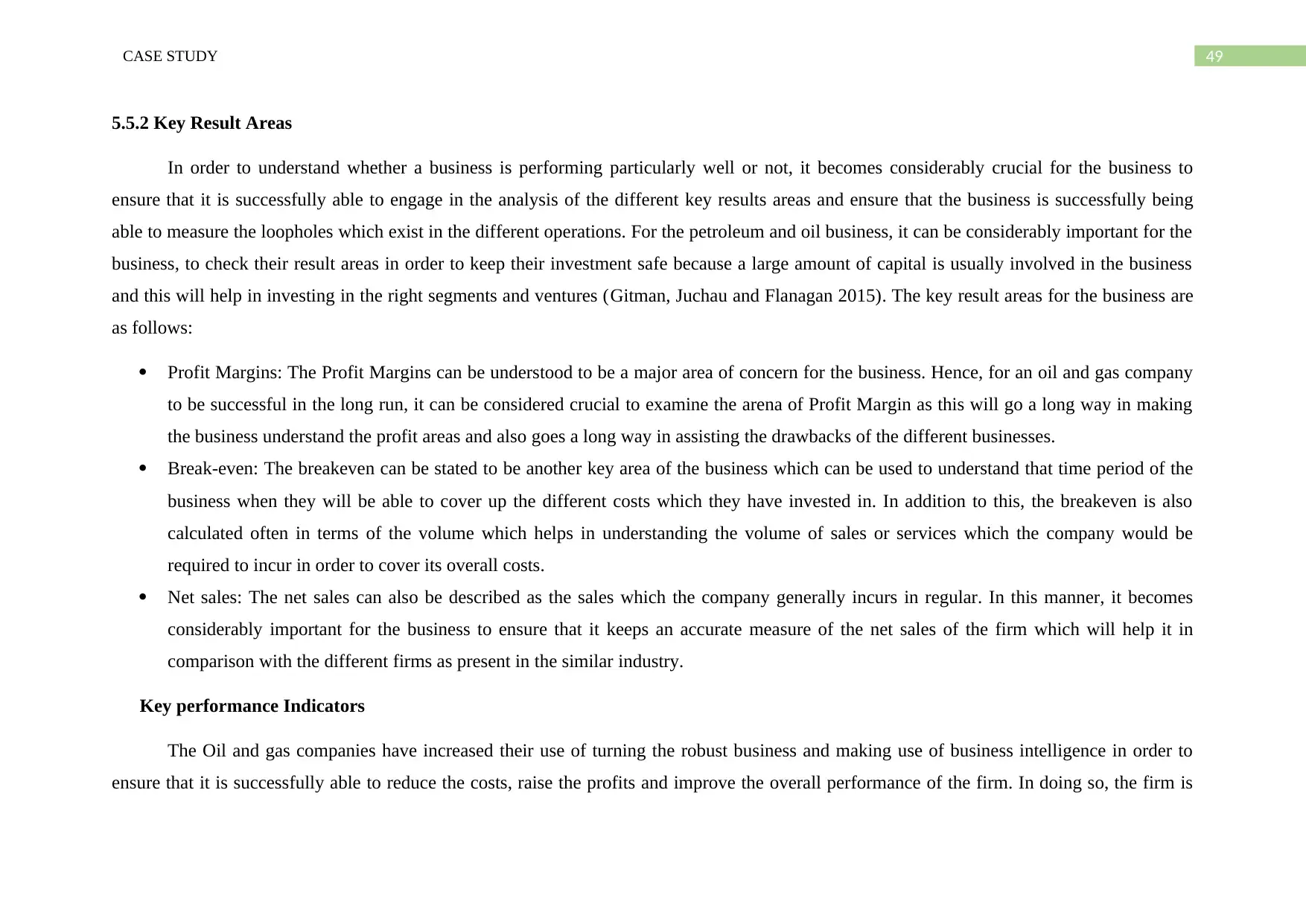
49CASE STUDY
5.5.2 Key Result Areas
In order to understand whether a business is performing particularly well or not, it becomes considerably crucial for the business to
ensure that it is successfully able to engage in the analysis of the different key results areas and ensure that the business is successfully being
able to measure the loopholes which exist in the different operations. For the petroleum and oil business, it can be considerably important for the
business, to check their result areas in order to keep their investment safe because a large amount of capital is usually involved in the business
and this will help in investing in the right segments and ventures (Gitman, Juchau and Flanagan 2015). The key result areas for the business are
as follows:
Profit Margins: The Profit Margins can be understood to be a major area of concern for the business. Hence, for an oil and gas company
to be successful in the long run, it can be considered crucial to examine the arena of Profit Margin as this will go a long way in making
the business understand the profit areas and also goes a long way in assisting the drawbacks of the different businesses.
Break-even: The breakeven can be stated to be another key area of the business which can be used to understand that time period of the
business when they will be able to cover up the different costs which they have invested in. In addition to this, the breakeven is also
calculated often in terms of the volume which helps in understanding the volume of sales or services which the company would be
required to incur in order to cover its overall costs.
Net sales: The net sales can also be described as the sales which the company generally incurs in regular. In this manner, it becomes
considerably important for the business to ensure that it keeps an accurate measure of the net sales of the firm which will help it in
comparison with the different firms as present in the similar industry.
Key performance Indicators
The Oil and gas companies have increased their use of turning the robust business and making use of business intelligence in order to
ensure that it is successfully able to reduce the costs, raise the profits and improve the overall performance of the firm. In doing so, the firm is
5.5.2 Key Result Areas
In order to understand whether a business is performing particularly well or not, it becomes considerably crucial for the business to
ensure that it is successfully able to engage in the analysis of the different key results areas and ensure that the business is successfully being
able to measure the loopholes which exist in the different operations. For the petroleum and oil business, it can be considerably important for the
business, to check their result areas in order to keep their investment safe because a large amount of capital is usually involved in the business
and this will help in investing in the right segments and ventures (Gitman, Juchau and Flanagan 2015). The key result areas for the business are
as follows:
Profit Margins: The Profit Margins can be understood to be a major area of concern for the business. Hence, for an oil and gas company
to be successful in the long run, it can be considered crucial to examine the arena of Profit Margin as this will go a long way in making
the business understand the profit areas and also goes a long way in assisting the drawbacks of the different businesses.
Break-even: The breakeven can be stated to be another key area of the business which can be used to understand that time period of the
business when they will be able to cover up the different costs which they have invested in. In addition to this, the breakeven is also
calculated often in terms of the volume which helps in understanding the volume of sales or services which the company would be
required to incur in order to cover its overall costs.
Net sales: The net sales can also be described as the sales which the company generally incurs in regular. In this manner, it becomes
considerably important for the business to ensure that it keeps an accurate measure of the net sales of the firm which will help it in
comparison with the different firms as present in the similar industry.
Key performance Indicators
The Oil and gas companies have increased their use of turning the robust business and making use of business intelligence in order to
ensure that it is successfully able to reduce the costs, raise the profits and improve the overall performance of the firm. In doing so, the firm is
Paraphrase This Document
Need a fresh take? Get an instant paraphrase of this document with our AI Paraphraser
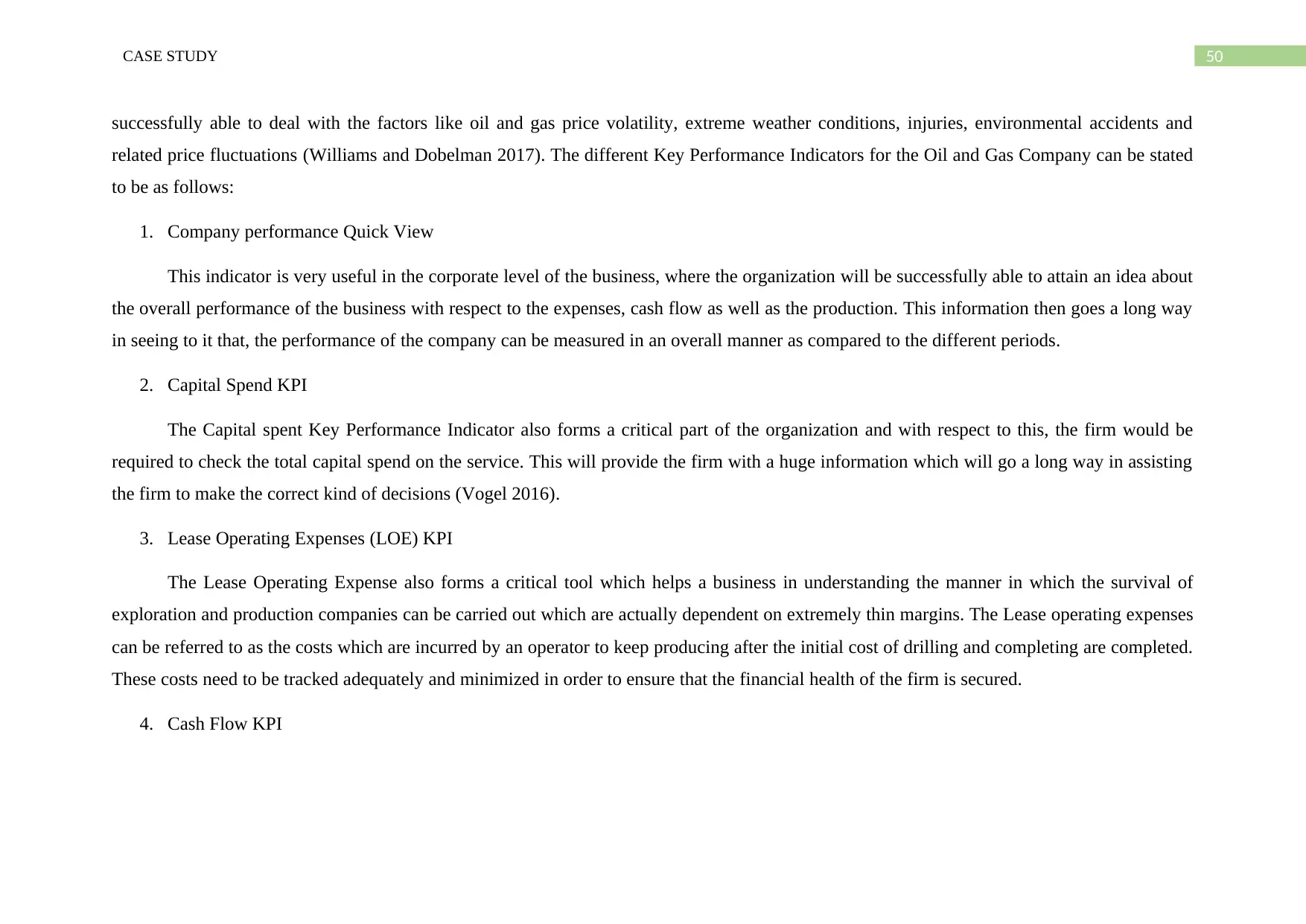
50CASE STUDY
successfully able to deal with the factors like oil and gas price volatility, extreme weather conditions, injuries, environmental accidents and
related price fluctuations (Williams and Dobelman 2017). The different Key Performance Indicators for the Oil and Gas Company can be stated
to be as follows:
1. Company performance Quick View
This indicator is very useful in the corporate level of the business, where the organization will be successfully able to attain an idea about
the overall performance of the business with respect to the expenses, cash flow as well as the production. This information then goes a long way
in seeing to it that, the performance of the company can be measured in an overall manner as compared to the different periods.
2. Capital Spend KPI
The Capital spent Key Performance Indicator also forms a critical part of the organization and with respect to this, the firm would be
required to check the total capital spend on the service. This will provide the firm with a huge information which will go a long way in assisting
the firm to make the correct kind of decisions (Vogel 2016).
3. Lease Operating Expenses (LOE) KPI
The Lease Operating Expense also forms a critical tool which helps a business in understanding the manner in which the survival of
exploration and production companies can be carried out which are actually dependent on extremely thin margins. The Lease operating expenses
can be referred to as the costs which are incurred by an operator to keep producing after the initial cost of drilling and completing are completed.
These costs need to be tracked adequately and minimized in order to ensure that the financial health of the firm is secured.
4. Cash Flow KPI
successfully able to deal with the factors like oil and gas price volatility, extreme weather conditions, injuries, environmental accidents and
related price fluctuations (Williams and Dobelman 2017). The different Key Performance Indicators for the Oil and Gas Company can be stated
to be as follows:
1. Company performance Quick View
This indicator is very useful in the corporate level of the business, where the organization will be successfully able to attain an idea about
the overall performance of the business with respect to the expenses, cash flow as well as the production. This information then goes a long way
in seeing to it that, the performance of the company can be measured in an overall manner as compared to the different periods.
2. Capital Spend KPI
The Capital spent Key Performance Indicator also forms a critical part of the organization and with respect to this, the firm would be
required to check the total capital spend on the service. This will provide the firm with a huge information which will go a long way in assisting
the firm to make the correct kind of decisions (Vogel 2016).
3. Lease Operating Expenses (LOE) KPI
The Lease Operating Expense also forms a critical tool which helps a business in understanding the manner in which the survival of
exploration and production companies can be carried out which are actually dependent on extremely thin margins. The Lease operating expenses
can be referred to as the costs which are incurred by an operator to keep producing after the initial cost of drilling and completing are completed.
These costs need to be tracked adequately and minimized in order to ensure that the financial health of the firm is secured.
4. Cash Flow KPI
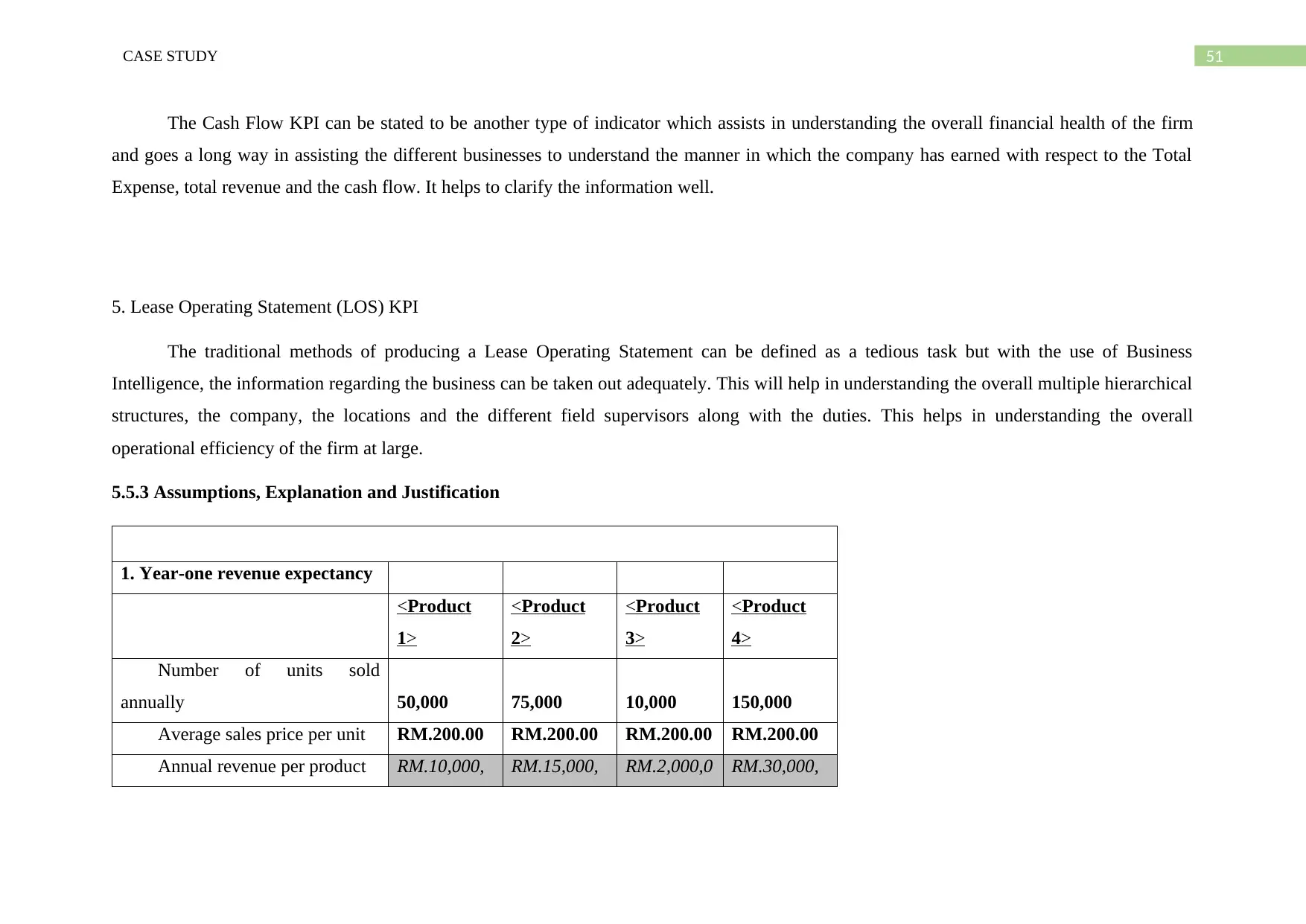
51CASE STUDY
The Cash Flow KPI can be stated to be another type of indicator which assists in understanding the overall financial health of the firm
and goes a long way in assisting the different businesses to understand the manner in which the company has earned with respect to the Total
Expense, total revenue and the cash flow. It helps to clarify the information well.
5. Lease Operating Statement (LOS) KPI
The traditional methods of producing a Lease Operating Statement can be defined as a tedious task but with the use of Business
Intelligence, the information regarding the business can be taken out adequately. This will help in understanding the overall multiple hierarchical
structures, the company, the locations and the different field supervisors along with the duties. This helps in understanding the overall
operational efficiency of the firm at large.
5.5.3 Assumptions, Explanation and Justification
1. Year-one revenue expectancy
<Product
1>
<Product
2>
<Product
3>
<Product
4>
Number of units sold
annually 50,000 75,000 10,000 150,000
Average sales price per unit RM.200.00 RM.200.00 RM.200.00 RM.200.00
Annual revenue per product RM.10,000, RM.15,000, RM.2,000,0 RM.30,000,
The Cash Flow KPI can be stated to be another type of indicator which assists in understanding the overall financial health of the firm
and goes a long way in assisting the different businesses to understand the manner in which the company has earned with respect to the Total
Expense, total revenue and the cash flow. It helps to clarify the information well.
5. Lease Operating Statement (LOS) KPI
The traditional methods of producing a Lease Operating Statement can be defined as a tedious task but with the use of Business
Intelligence, the information regarding the business can be taken out adequately. This will help in understanding the overall multiple hierarchical
structures, the company, the locations and the different field supervisors along with the duties. This helps in understanding the overall
operational efficiency of the firm at large.
5.5.3 Assumptions, Explanation and Justification
1. Year-one revenue expectancy
<Product
1>
<Product
2>
<Product
3>
<Product
4>
Number of units sold
annually 50,000 75,000 10,000 150,000
Average sales price per unit RM.200.00 RM.200.00 RM.200.00 RM.200.00
Annual revenue per product RM.10,000, RM.15,000, RM.2,000,0 RM.30,000,
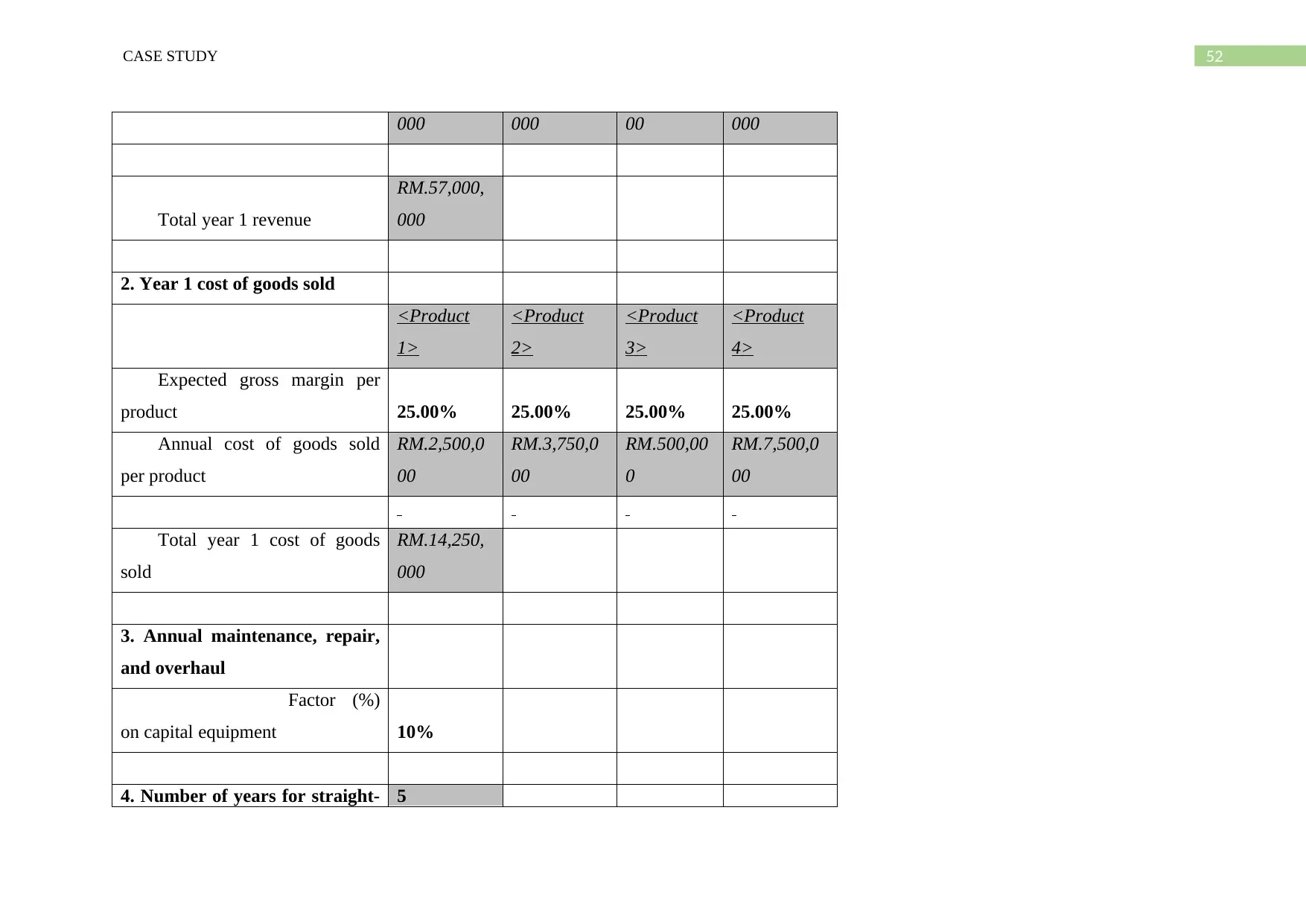
52CASE STUDY
000 000 00 000
Total year 1 revenue
RM.57,000,
000
2. Year 1 cost of goods sold
<Product
1>
<Product
2>
<Product
3>
<Product
4>
Expected gross margin per
product 25.00% 25.00% 25.00% 25.00%
Annual cost of goods sold
per product
RM.2,500,0
00
RM.3,750,0
00
RM.500,00
0
RM.7,500,0
00
Total year 1 cost of goods
sold
RM.14,250,
000
3. Annual maintenance, repair,
and overhaul
Factor (%)
on capital equipment 10%
4. Number of years for straight- 5
000 000 00 000
Total year 1 revenue
RM.57,000,
000
2. Year 1 cost of goods sold
<Product
1>
<Product
2>
<Product
3>
<Product
4>
Expected gross margin per
product 25.00% 25.00% 25.00% 25.00%
Annual cost of goods sold
per product
RM.2,500,0
00
RM.3,750,0
00
RM.500,00
0
RM.7,500,0
00
Total year 1 cost of goods
sold
RM.14,250,
000
3. Annual maintenance, repair,
and overhaul
Factor (%)
on capital equipment 10%
4. Number of years for straight- 5
Secure Best Marks with AI Grader
Need help grading? Try our AI Grader for instant feedback on your assignments.
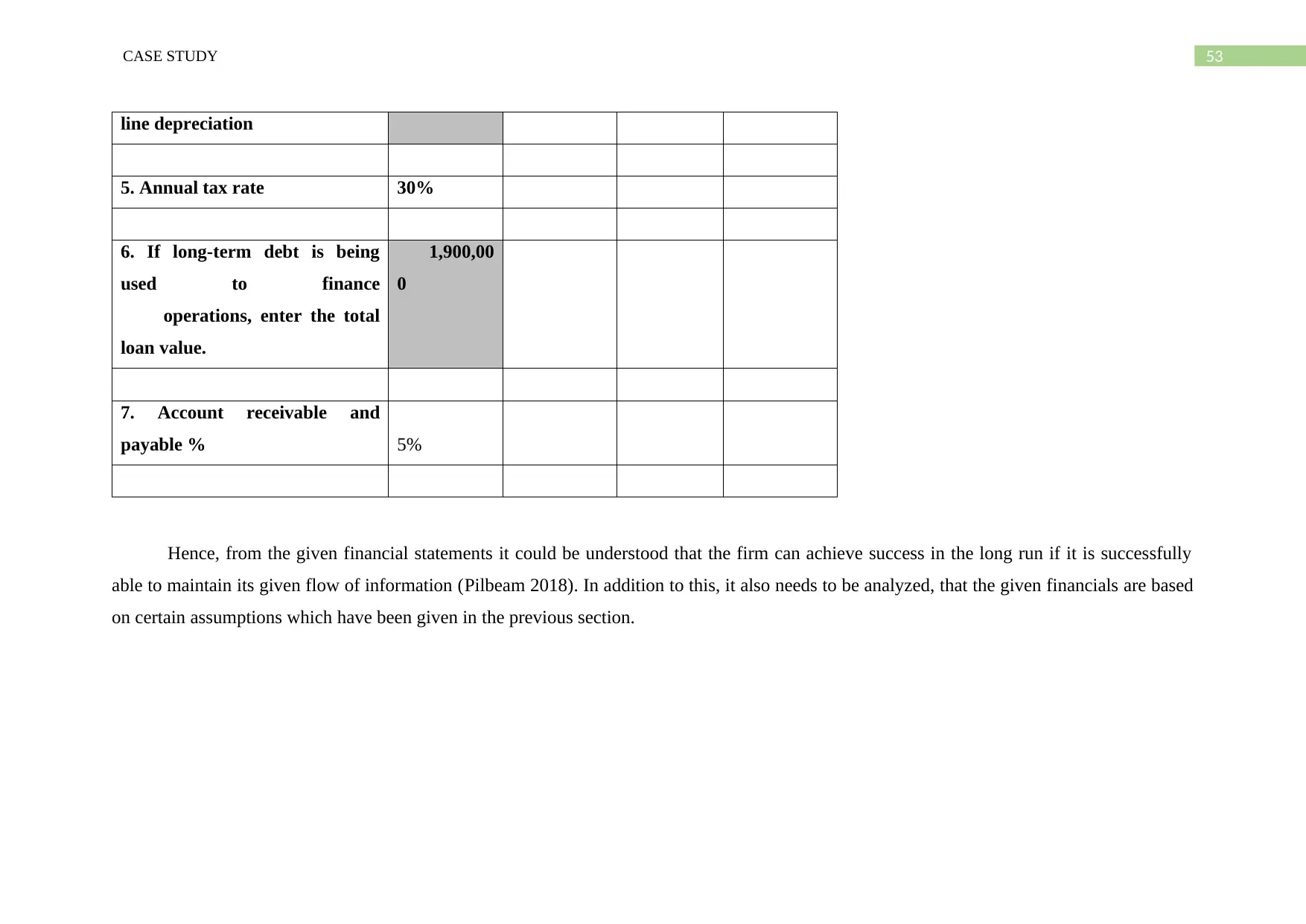
53CASE STUDY
line depreciation
5. Annual tax rate 30%
6. If long-term debt is being
used to finance
operations, enter the total
loan value.
1,900,00
0
7. Account receivable and
payable % 5%
Hence, from the given financial statements it could be understood that the firm can achieve success in the long run if it is successfully
able to maintain its given flow of information (Pilbeam 2018). In addition to this, it also needs to be analyzed, that the given financials are based
on certain assumptions which have been given in the previous section.
line depreciation
5. Annual tax rate 30%
6. If long-term debt is being
used to finance
operations, enter the total
loan value.
1,900,00
0
7. Account receivable and
payable % 5%
Hence, from the given financial statements it could be understood that the firm can achieve success in the long run if it is successfully
able to maintain its given flow of information (Pilbeam 2018). In addition to this, it also needs to be analyzed, that the given financials are based
on certain assumptions which have been given in the previous section.

54CASE STUDY
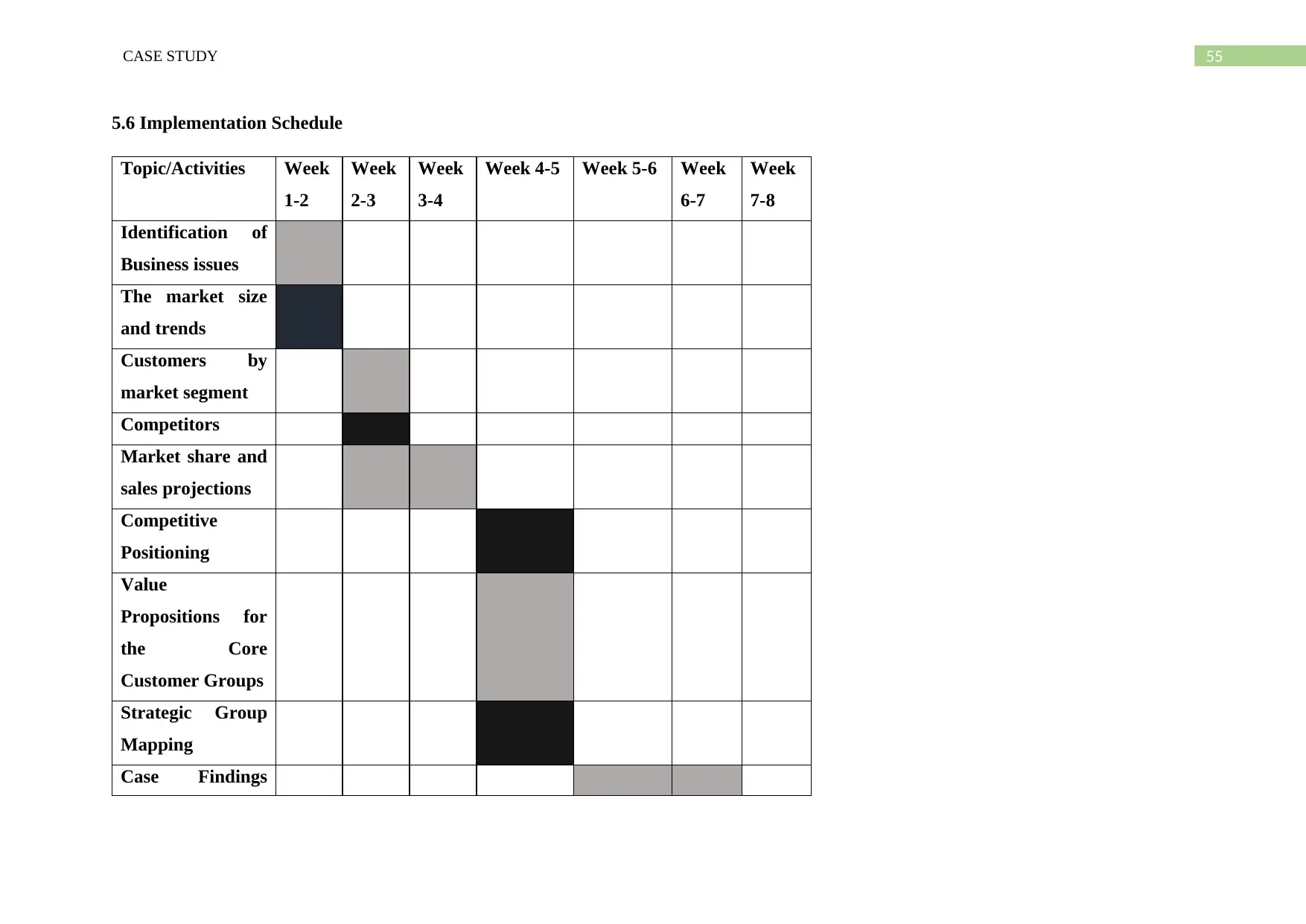
55CASE STUDY
5.6 Implementation Schedule
Topic/Activities Week
1-2
Week
2-3
Week
3-4
Week 4-5 Week 5-6 Week
6-7
Week
7-8
Identification of
Business issues
The market size
and trends
Customers by
market segment
Competitors
Market share and
sales projections
Competitive
Positioning
Value
Propositions for
the Core
Customer Groups
Strategic Group
Mapping
Case Findings
5.6 Implementation Schedule
Topic/Activities Week
1-2
Week
2-3
Week
3-4
Week 4-5 Week 5-6 Week
6-7
Week
7-8
Identification of
Business issues
The market size
and trends
Customers by
market segment
Competitors
Market share and
sales projections
Competitive
Positioning
Value
Propositions for
the Core
Customer Groups
Strategic Group
Mapping
Case Findings
Paraphrase This Document
Need a fresh take? Get an instant paraphrase of this document with our AI Paraphraser
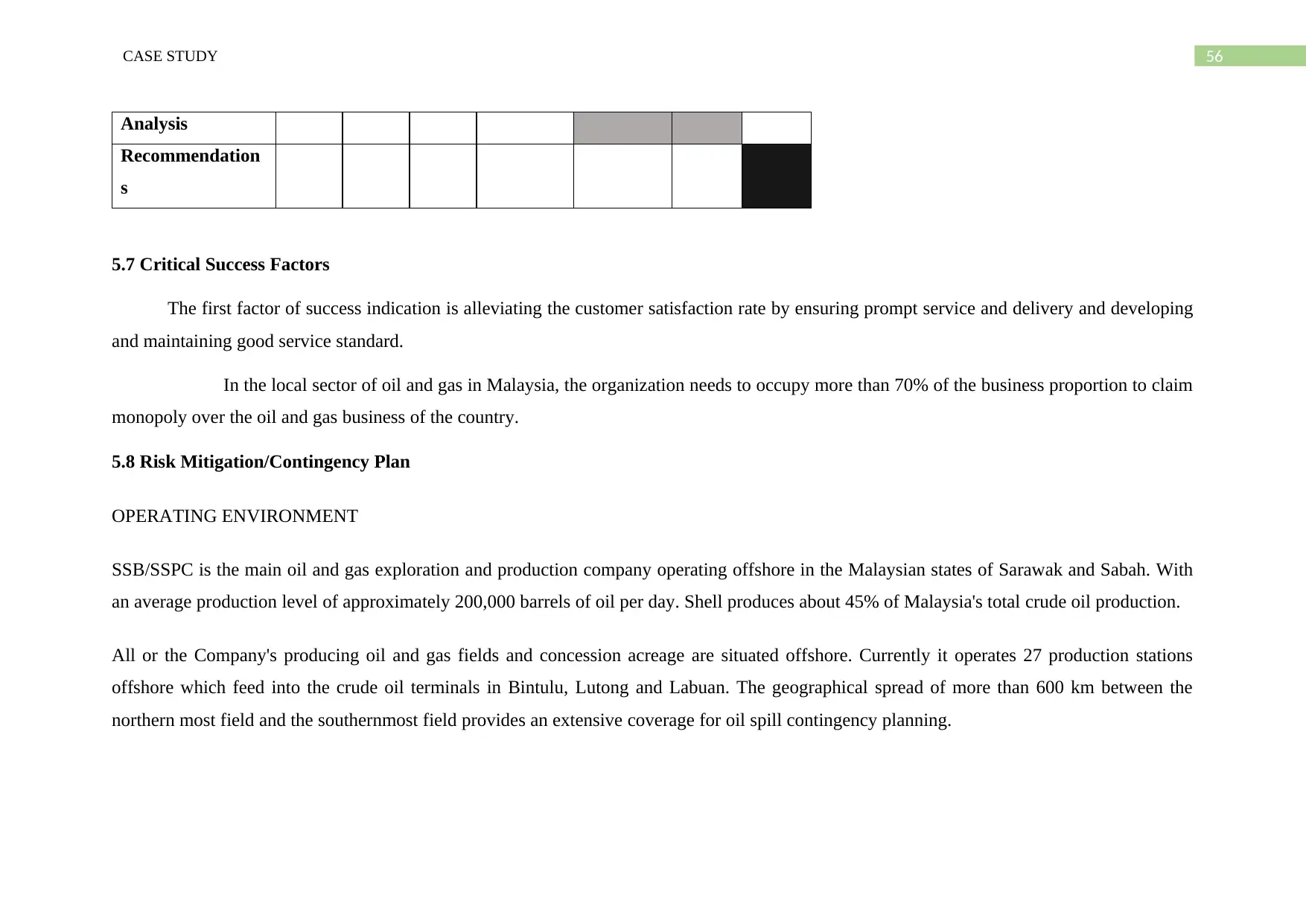
56CASE STUDY
Analysis
Recommendation
s
5.7 Critical Success Factors
The first factor of success indication is alleviating the customer satisfaction rate by ensuring prompt service and delivery and developing
and maintaining good service standard.
In the local sector of oil and gas in Malaysia, the organization needs to occupy more than 70% of the business proportion to claim
monopoly over the oil and gas business of the country.
5.8 Risk Mitigation/Contingency Plan
OPERATING ENVIRONMENT
SSB/SSPC is the main oil and gas exploration and production company operating offshore in the Malaysian states of Sarawak and Sabah. With
an average production level of approximately 200,000 barrels of oil per day. Shell produces about 45% of Malaysia's total crude oil production.
All or the Company's producing oil and gas fields and concession acreage are situated offshore. Currently it operates 27 production stations
offshore which feed into the crude oil terminals in Bintulu, Lutong and Labuan. The geographical spread of more than 600 km between the
northern most field and the southernmost field provides an extensive coverage for oil spill contingency planning.
Analysis
Recommendation
s
5.7 Critical Success Factors
The first factor of success indication is alleviating the customer satisfaction rate by ensuring prompt service and delivery and developing
and maintaining good service standard.
In the local sector of oil and gas in Malaysia, the organization needs to occupy more than 70% of the business proportion to claim
monopoly over the oil and gas business of the country.
5.8 Risk Mitigation/Contingency Plan
OPERATING ENVIRONMENT
SSB/SSPC is the main oil and gas exploration and production company operating offshore in the Malaysian states of Sarawak and Sabah. With
an average production level of approximately 200,000 barrels of oil per day. Shell produces about 45% of Malaysia's total crude oil production.
All or the Company's producing oil and gas fields and concession acreage are situated offshore. Currently it operates 27 production stations
offshore which feed into the crude oil terminals in Bintulu, Lutong and Labuan. The geographical spread of more than 600 km between the
northern most field and the southernmost field provides an extensive coverage for oil spill contingency planning.
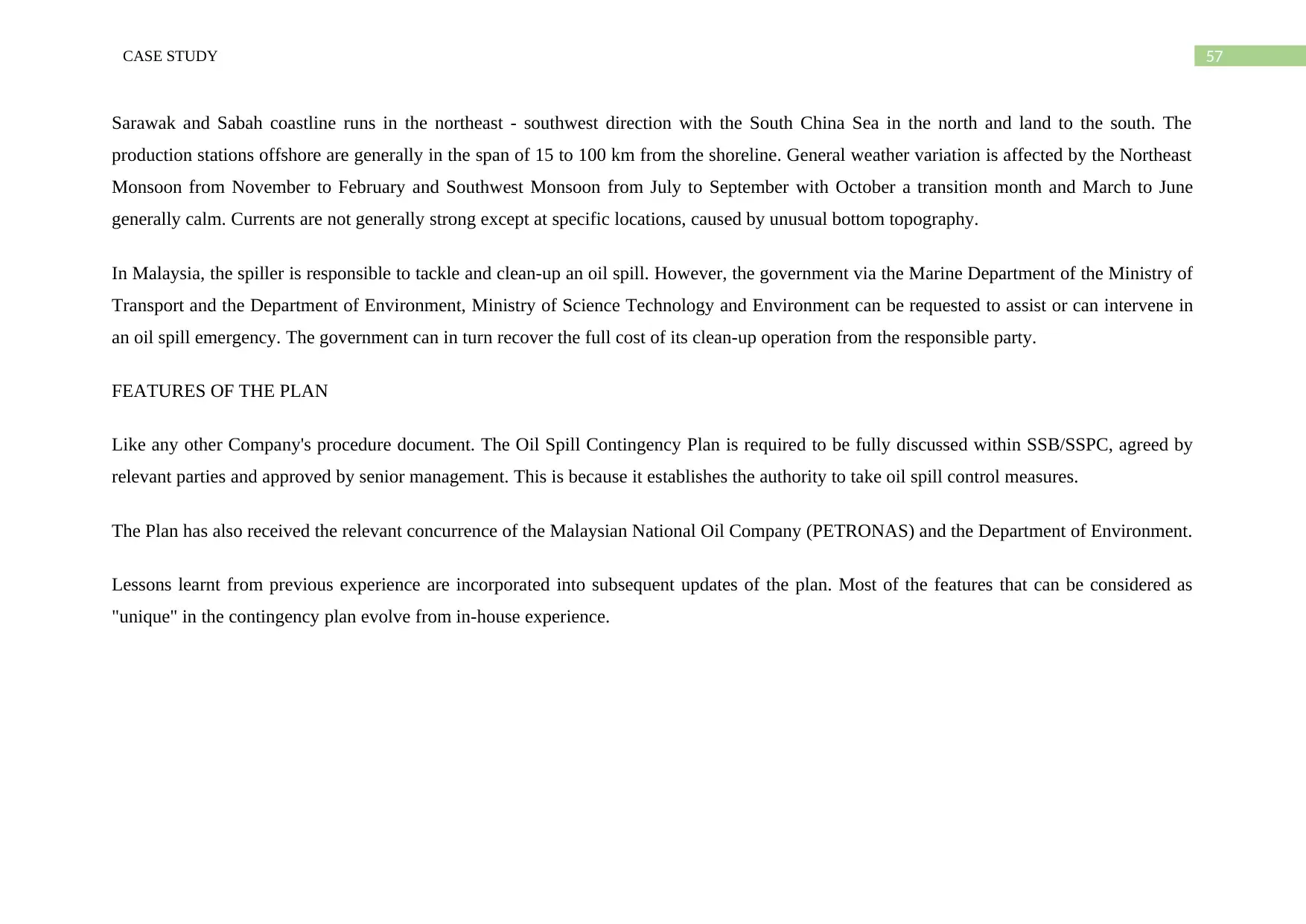
57CASE STUDY
Sarawak and Sabah coastline runs in the northeast - southwest direction with the South China Sea in the north and land to the south. The
production stations offshore are generally in the span of 15 to 100 km from the shoreline. General weather variation is affected by the Northeast
Monsoon from November to February and Southwest Monsoon from July to September with October a transition month and March to June
generally calm. Currents are not generally strong except at specific locations, caused by unusual bottom topography.
In Malaysia, the spiller is responsible to tackle and clean-up an oil spill. However, the government via the Marine Department of the Ministry of
Transport and the Department of Environment, Ministry of Science Technology and Environment can be requested to assist or can intervene in
an oil spill emergency. The government can in turn recover the full cost of its clean-up operation from the responsible party.
FEATURES OF THE PLAN
Like any other Company's procedure document. The Oil Spill Contingency Plan is required to be fully discussed within SSB/SSPC, agreed by
relevant parties and approved by senior management. This is because it establishes the authority to take oil spill control measures.
The Plan has also received the relevant concurrence of the Malaysian National Oil Company (PETRONAS) and the Department of Environment.
Lessons learnt from previous experience are incorporated into subsequent updates of the plan. Most of the features that can be considered as
"unique" in the contingency plan evolve from in-house experience.
Sarawak and Sabah coastline runs in the northeast - southwest direction with the South China Sea in the north and land to the south. The
production stations offshore are generally in the span of 15 to 100 km from the shoreline. General weather variation is affected by the Northeast
Monsoon from November to February and Southwest Monsoon from July to September with October a transition month and March to June
generally calm. Currents are not generally strong except at specific locations, caused by unusual bottom topography.
In Malaysia, the spiller is responsible to tackle and clean-up an oil spill. However, the government via the Marine Department of the Ministry of
Transport and the Department of Environment, Ministry of Science Technology and Environment can be requested to assist or can intervene in
an oil spill emergency. The government can in turn recover the full cost of its clean-up operation from the responsible party.
FEATURES OF THE PLAN
Like any other Company's procedure document. The Oil Spill Contingency Plan is required to be fully discussed within SSB/SSPC, agreed by
relevant parties and approved by senior management. This is because it establishes the authority to take oil spill control measures.
The Plan has also received the relevant concurrence of the Malaysian National Oil Company (PETRONAS) and the Department of Environment.
Lessons learnt from previous experience are incorporated into subsequent updates of the plan. Most of the features that can be considered as
"unique" in the contingency plan evolve from in-house experience.
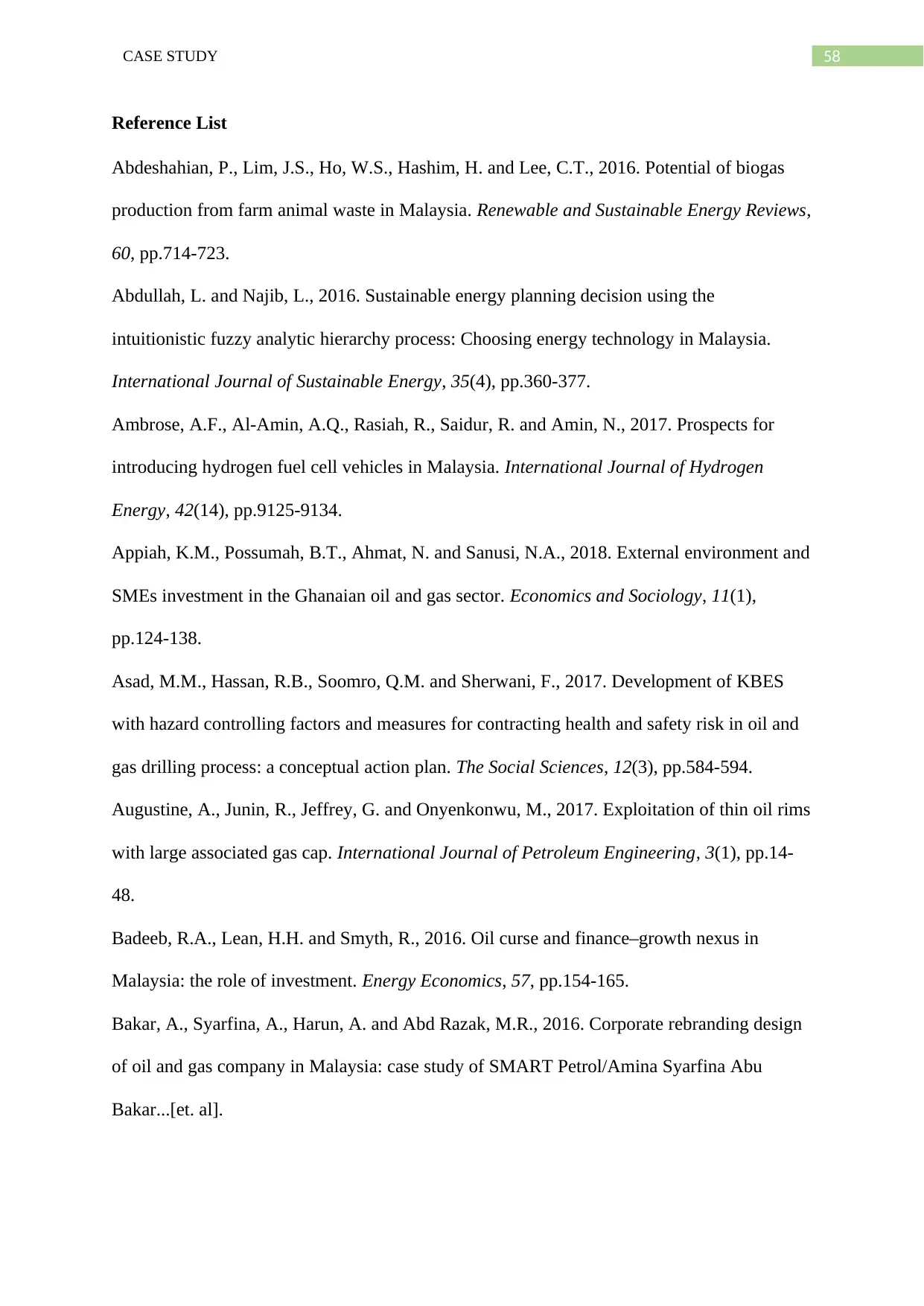
58CASE STUDY
Reference List
Abdeshahian, P., Lim, J.S., Ho, W.S., Hashim, H. and Lee, C.T., 2016. Potential of biogas
production from farm animal waste in Malaysia. Renewable and Sustainable Energy Reviews,
60, pp.714-723.
Abdullah, L. and Najib, L., 2016. Sustainable energy planning decision using the
intuitionistic fuzzy analytic hierarchy process: Choosing energy technology in Malaysia.
International Journal of Sustainable Energy, 35(4), pp.360-377.
Ambrose, A.F., Al-Amin, A.Q., Rasiah, R., Saidur, R. and Amin, N., 2017. Prospects for
introducing hydrogen fuel cell vehicles in Malaysia. International Journal of Hydrogen
Energy, 42(14), pp.9125-9134.
Appiah, K.M., Possumah, B.T., Ahmat, N. and Sanusi, N.A., 2018. External environment and
SMEs investment in the Ghanaian oil and gas sector. Economics and Sociology, 11(1),
pp.124-138.
Asad, M.M., Hassan, R.B., Soomro, Q.M. and Sherwani, F., 2017. Development of KBES
with hazard controlling factors and measures for contracting health and safety risk in oil and
gas drilling process: a conceptual action plan. The Social Sciences, 12(3), pp.584-594.
Augustine, A., Junin, R., Jeffrey, G. and Onyenkonwu, M., 2017. Exploitation of thin oil rims
with large associated gas cap. International Journal of Petroleum Engineering, 3(1), pp.14-
48.
Badeeb, R.A., Lean, H.H. and Smyth, R., 2016. Oil curse and finance–growth nexus in
Malaysia: the role of investment. Energy Economics, 57, pp.154-165.
Bakar, A., Syarfina, A., Harun, A. and Abd Razak, M.R., 2016. Corporate rebranding design
of oil and gas company in Malaysia: case study of SMART Petrol/Amina Syarfina Abu
Bakar...[et. al].
Reference List
Abdeshahian, P., Lim, J.S., Ho, W.S., Hashim, H. and Lee, C.T., 2016. Potential of biogas
production from farm animal waste in Malaysia. Renewable and Sustainable Energy Reviews,
60, pp.714-723.
Abdullah, L. and Najib, L., 2016. Sustainable energy planning decision using the
intuitionistic fuzzy analytic hierarchy process: Choosing energy technology in Malaysia.
International Journal of Sustainable Energy, 35(4), pp.360-377.
Ambrose, A.F., Al-Amin, A.Q., Rasiah, R., Saidur, R. and Amin, N., 2017. Prospects for
introducing hydrogen fuel cell vehicles in Malaysia. International Journal of Hydrogen
Energy, 42(14), pp.9125-9134.
Appiah, K.M., Possumah, B.T., Ahmat, N. and Sanusi, N.A., 2018. External environment and
SMEs investment in the Ghanaian oil and gas sector. Economics and Sociology, 11(1),
pp.124-138.
Asad, M.M., Hassan, R.B., Soomro, Q.M. and Sherwani, F., 2017. Development of KBES
with hazard controlling factors and measures for contracting health and safety risk in oil and
gas drilling process: a conceptual action plan. The Social Sciences, 12(3), pp.584-594.
Augustine, A., Junin, R., Jeffrey, G. and Onyenkonwu, M., 2017. Exploitation of thin oil rims
with large associated gas cap. International Journal of Petroleum Engineering, 3(1), pp.14-
48.
Badeeb, R.A., Lean, H.H. and Smyth, R., 2016. Oil curse and finance–growth nexus in
Malaysia: the role of investment. Energy Economics, 57, pp.154-165.
Bakar, A., Syarfina, A., Harun, A. and Abd Razak, M.R., 2016. Corporate rebranding design
of oil and gas company in Malaysia: case study of SMART Petrol/Amina Syarfina Abu
Bakar...[et. al].
Secure Best Marks with AI Grader
Need help grading? Try our AI Grader for instant feedback on your assignments.
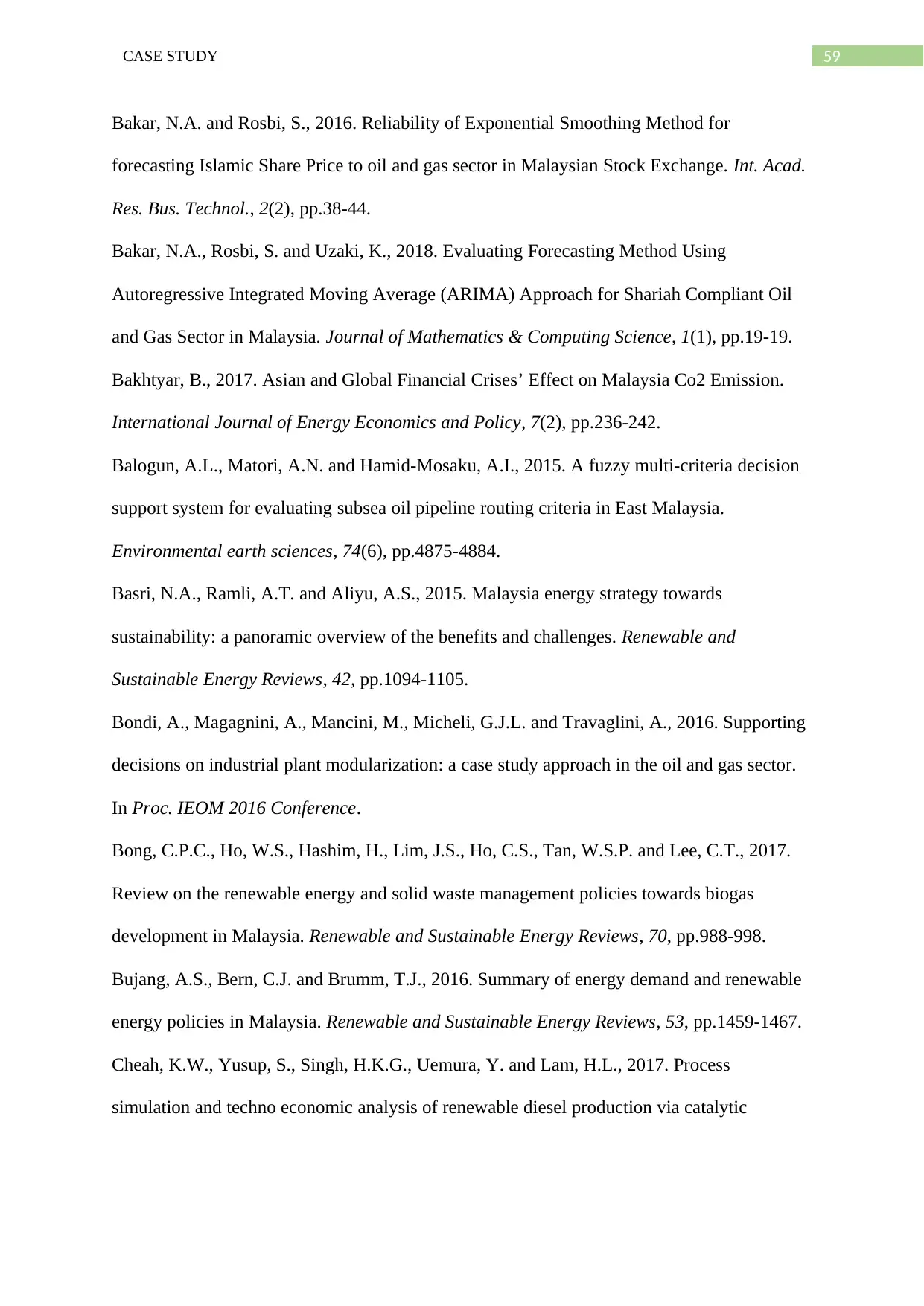
59CASE STUDY
Bakar, N.A. and Rosbi, S., 2016. Reliability of Exponential Smoothing Method for
forecasting Islamic Share Price to oil and gas sector in Malaysian Stock Exchange. Int. Acad.
Res. Bus. Technol., 2(2), pp.38-44.
Bakar, N.A., Rosbi, S. and Uzaki, K., 2018. Evaluating Forecasting Method Using
Autoregressive Integrated Moving Average (ARIMA) Approach for Shariah Compliant Oil
and Gas Sector in Malaysia. Journal of Mathematics & Computing Science, 1(1), pp.19-19.
Bakhtyar, B., 2017. Asian and Global Financial Crises’ Effect on Malaysia Co2 Emission.
International Journal of Energy Economics and Policy, 7(2), pp.236-242.
Balogun, A.L., Matori, A.N. and Hamid-Mosaku, A.I., 2015. A fuzzy multi-criteria decision
support system for evaluating subsea oil pipeline routing criteria in East Malaysia.
Environmental earth sciences, 74(6), pp.4875-4884.
Basri, N.A., Ramli, A.T. and Aliyu, A.S., 2015. Malaysia energy strategy towards
sustainability: a panoramic overview of the benefits and challenges. Renewable and
Sustainable Energy Reviews, 42, pp.1094-1105.
Bondi, A., Magagnini, A., Mancini, M., Micheli, G.J.L. and Travaglini, A., 2016. Supporting
decisions on industrial plant modularization: a case study approach in the oil and gas sector.
In Proc. IEOM 2016 Conference.
Bong, C.P.C., Ho, W.S., Hashim, H., Lim, J.S., Ho, C.S., Tan, W.S.P. and Lee, C.T., 2017.
Review on the renewable energy and solid waste management policies towards biogas
development in Malaysia. Renewable and Sustainable Energy Reviews, 70, pp.988-998.
Bujang, A.S., Bern, C.J. and Brumm, T.J., 2016. Summary of energy demand and renewable
energy policies in Malaysia. Renewable and Sustainable Energy Reviews, 53, pp.1459-1467.
Cheah, K.W., Yusup, S., Singh, H.K.G., Uemura, Y. and Lam, H.L., 2017. Process
simulation and techno economic analysis of renewable diesel production via catalytic
Bakar, N.A. and Rosbi, S., 2016. Reliability of Exponential Smoothing Method for
forecasting Islamic Share Price to oil and gas sector in Malaysian Stock Exchange. Int. Acad.
Res. Bus. Technol., 2(2), pp.38-44.
Bakar, N.A., Rosbi, S. and Uzaki, K., 2018. Evaluating Forecasting Method Using
Autoregressive Integrated Moving Average (ARIMA) Approach for Shariah Compliant Oil
and Gas Sector in Malaysia. Journal of Mathematics & Computing Science, 1(1), pp.19-19.
Bakhtyar, B., 2017. Asian and Global Financial Crises’ Effect on Malaysia Co2 Emission.
International Journal of Energy Economics and Policy, 7(2), pp.236-242.
Balogun, A.L., Matori, A.N. and Hamid-Mosaku, A.I., 2015. A fuzzy multi-criteria decision
support system for evaluating subsea oil pipeline routing criteria in East Malaysia.
Environmental earth sciences, 74(6), pp.4875-4884.
Basri, N.A., Ramli, A.T. and Aliyu, A.S., 2015. Malaysia energy strategy towards
sustainability: a panoramic overview of the benefits and challenges. Renewable and
Sustainable Energy Reviews, 42, pp.1094-1105.
Bondi, A., Magagnini, A., Mancini, M., Micheli, G.J.L. and Travaglini, A., 2016. Supporting
decisions on industrial plant modularization: a case study approach in the oil and gas sector.
In Proc. IEOM 2016 Conference.
Bong, C.P.C., Ho, W.S., Hashim, H., Lim, J.S., Ho, C.S., Tan, W.S.P. and Lee, C.T., 2017.
Review on the renewable energy and solid waste management policies towards biogas
development in Malaysia. Renewable and Sustainable Energy Reviews, 70, pp.988-998.
Bujang, A.S., Bern, C.J. and Brumm, T.J., 2016. Summary of energy demand and renewable
energy policies in Malaysia. Renewable and Sustainable Energy Reviews, 53, pp.1459-1467.
Cheah, K.W., Yusup, S., Singh, H.K.G., Uemura, Y. and Lam, H.L., 2017. Process
simulation and techno economic analysis of renewable diesel production via catalytic
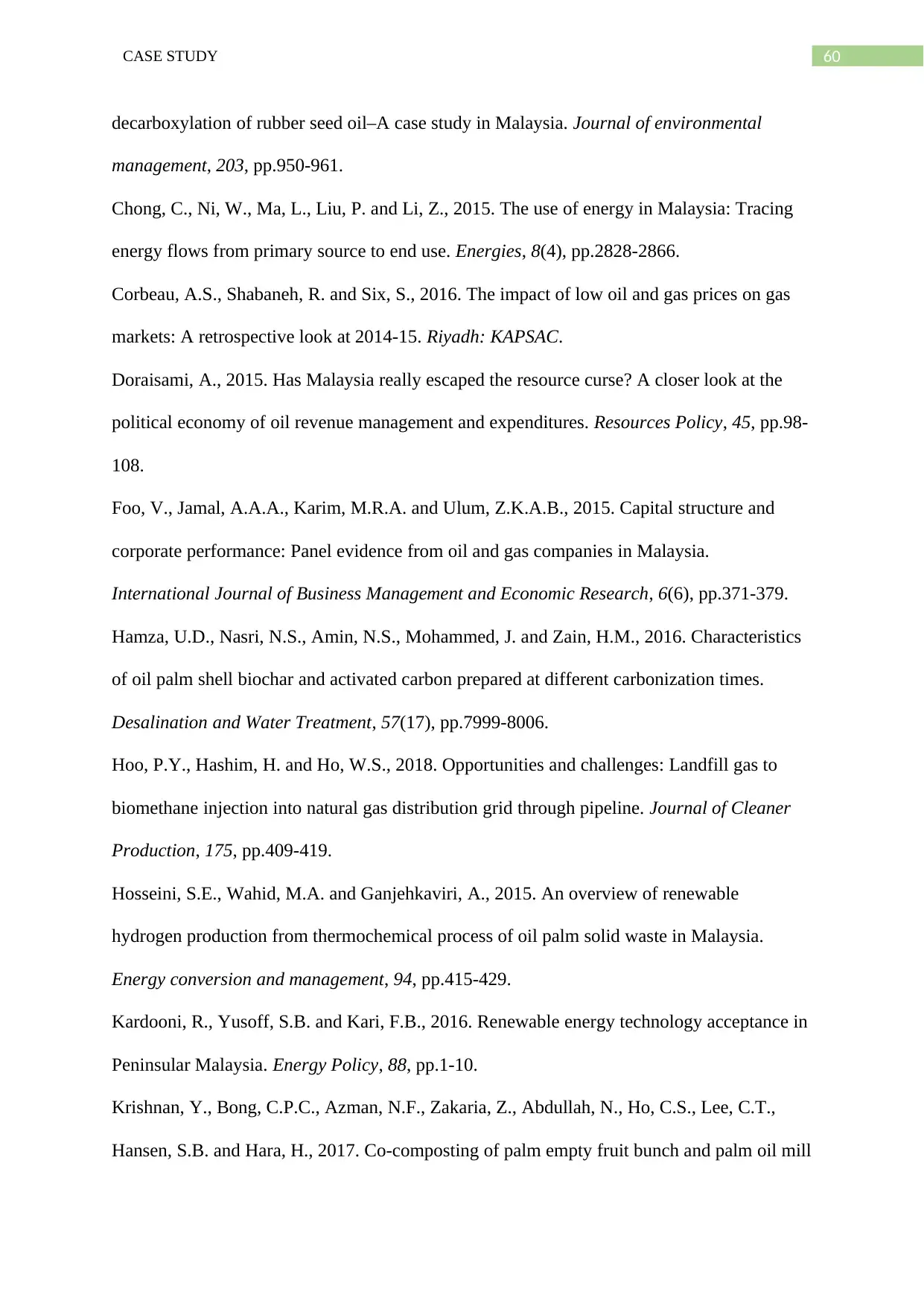
60CASE STUDY
decarboxylation of rubber seed oil–A case study in Malaysia. Journal of environmental
management, 203, pp.950-961.
Chong, C., Ni, W., Ma, L., Liu, P. and Li, Z., 2015. The use of energy in Malaysia: Tracing
energy flows from primary source to end use. Energies, 8(4), pp.2828-2866.
Corbeau, A.S., Shabaneh, R. and Six, S., 2016. The impact of low oil and gas prices on gas
markets: A retrospective look at 2014-15. Riyadh: KAPSAC.
Doraisami, A., 2015. Has Malaysia really escaped the resource curse? A closer look at the
political economy of oil revenue management and expenditures. Resources Policy, 45, pp.98-
108.
Foo, V., Jamal, A.A.A., Karim, M.R.A. and Ulum, Z.K.A.B., 2015. Capital structure and
corporate performance: Panel evidence from oil and gas companies in Malaysia.
International Journal of Business Management and Economic Research, 6(6), pp.371-379.
Hamza, U.D., Nasri, N.S., Amin, N.S., Mohammed, J. and Zain, H.M., 2016. Characteristics
of oil palm shell biochar and activated carbon prepared at different carbonization times.
Desalination and Water Treatment, 57(17), pp.7999-8006.
Hoo, P.Y., Hashim, H. and Ho, W.S., 2018. Opportunities and challenges: Landfill gas to
biomethane injection into natural gas distribution grid through pipeline. Journal of Cleaner
Production, 175, pp.409-419.
Hosseini, S.E., Wahid, M.A. and Ganjehkaviri, A., 2015. An overview of renewable
hydrogen production from thermochemical process of oil palm solid waste in Malaysia.
Energy conversion and management, 94, pp.415-429.
Kardooni, R., Yusoff, S.B. and Kari, F.B., 2016. Renewable energy technology acceptance in
Peninsular Malaysia. Energy Policy, 88, pp.1-10.
Krishnan, Y., Bong, C.P.C., Azman, N.F., Zakaria, Z., Abdullah, N., Ho, C.S., Lee, C.T.,
Hansen, S.B. and Hara, H., 2017. Co-composting of palm empty fruit bunch and palm oil mill
decarboxylation of rubber seed oil–A case study in Malaysia. Journal of environmental
management, 203, pp.950-961.
Chong, C., Ni, W., Ma, L., Liu, P. and Li, Z., 2015. The use of energy in Malaysia: Tracing
energy flows from primary source to end use. Energies, 8(4), pp.2828-2866.
Corbeau, A.S., Shabaneh, R. and Six, S., 2016. The impact of low oil and gas prices on gas
markets: A retrospective look at 2014-15. Riyadh: KAPSAC.
Doraisami, A., 2015. Has Malaysia really escaped the resource curse? A closer look at the
political economy of oil revenue management and expenditures. Resources Policy, 45, pp.98-
108.
Foo, V., Jamal, A.A.A., Karim, M.R.A. and Ulum, Z.K.A.B., 2015. Capital structure and
corporate performance: Panel evidence from oil and gas companies in Malaysia.
International Journal of Business Management and Economic Research, 6(6), pp.371-379.
Hamza, U.D., Nasri, N.S., Amin, N.S., Mohammed, J. and Zain, H.M., 2016. Characteristics
of oil palm shell biochar and activated carbon prepared at different carbonization times.
Desalination and Water Treatment, 57(17), pp.7999-8006.
Hoo, P.Y., Hashim, H. and Ho, W.S., 2018. Opportunities and challenges: Landfill gas to
biomethane injection into natural gas distribution grid through pipeline. Journal of Cleaner
Production, 175, pp.409-419.
Hosseini, S.E., Wahid, M.A. and Ganjehkaviri, A., 2015. An overview of renewable
hydrogen production from thermochemical process of oil palm solid waste in Malaysia.
Energy conversion and management, 94, pp.415-429.
Kardooni, R., Yusoff, S.B. and Kari, F.B., 2016. Renewable energy technology acceptance in
Peninsular Malaysia. Energy Policy, 88, pp.1-10.
Krishnan, Y., Bong, C.P.C., Azman, N.F., Zakaria, Z., Abdullah, N., Ho, C.S., Lee, C.T.,
Hansen, S.B. and Hara, H., 2017. Co-composting of palm empty fruit bunch and palm oil mill
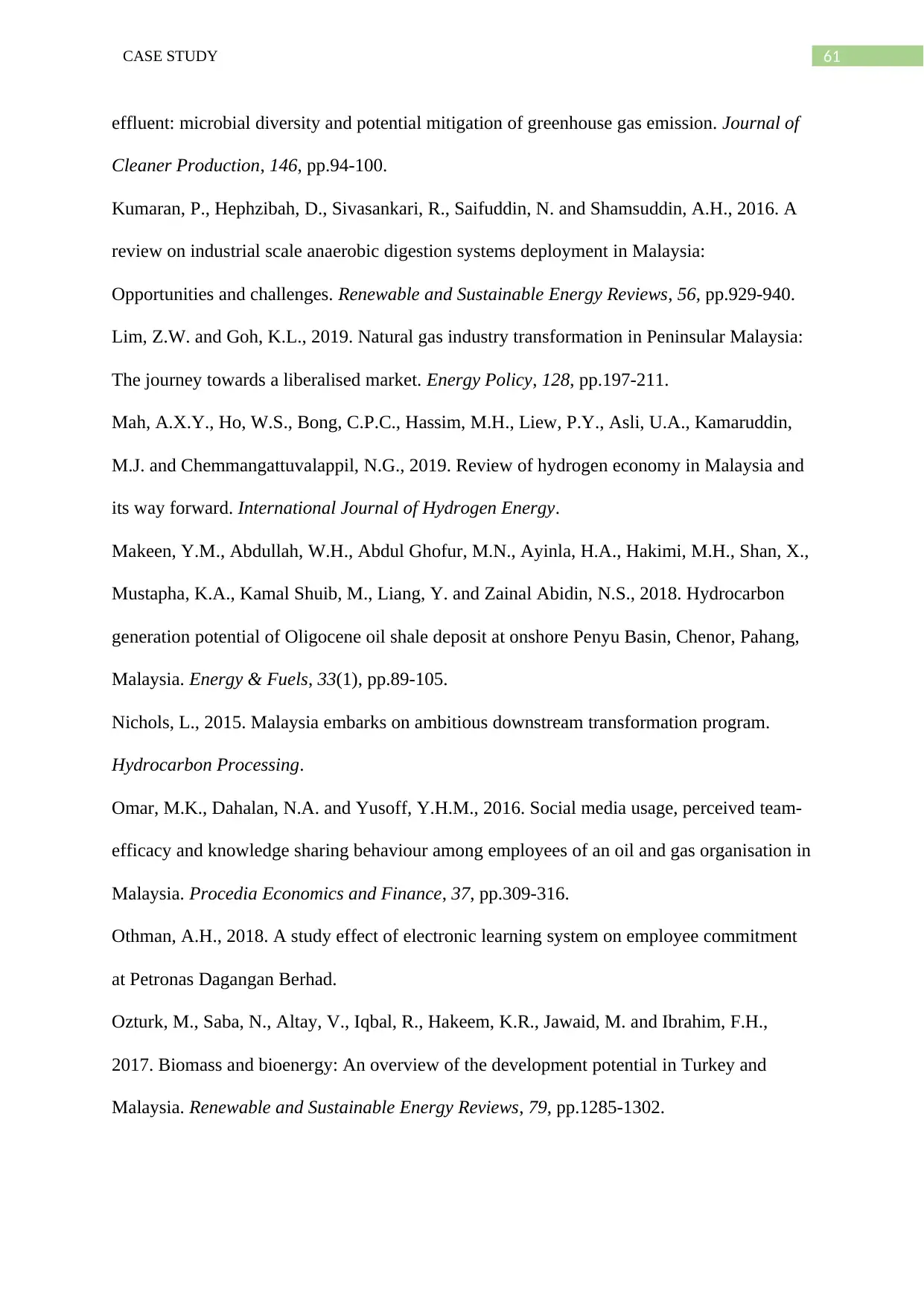
61CASE STUDY
effluent: microbial diversity and potential mitigation of greenhouse gas emission. Journal of
Cleaner Production, 146, pp.94-100.
Kumaran, P., Hephzibah, D., Sivasankari, R., Saifuddin, N. and Shamsuddin, A.H., 2016. A
review on industrial scale anaerobic digestion systems deployment in Malaysia:
Opportunities and challenges. Renewable and Sustainable Energy Reviews, 56, pp.929-940.
Lim, Z.W. and Goh, K.L., 2019. Natural gas industry transformation in Peninsular Malaysia:
The journey towards a liberalised market. Energy Policy, 128, pp.197-211.
Mah, A.X.Y., Ho, W.S., Bong, C.P.C., Hassim, M.H., Liew, P.Y., Asli, U.A., Kamaruddin,
M.J. and Chemmangattuvalappil, N.G., 2019. Review of hydrogen economy in Malaysia and
its way forward. International Journal of Hydrogen Energy.
Makeen, Y.M., Abdullah, W.H., Abdul Ghofur, M.N., Ayinla, H.A., Hakimi, M.H., Shan, X.,
Mustapha, K.A., Kamal Shuib, M., Liang, Y. and Zainal Abidin, N.S., 2018. Hydrocarbon
generation potential of Oligocene oil shale deposit at onshore Penyu Basin, Chenor, Pahang,
Malaysia. Energy & Fuels, 33(1), pp.89-105.
Nichols, L., 2015. Malaysia embarks on ambitious downstream transformation program.
Hydrocarbon Processing.
Omar, M.K., Dahalan, N.A. and Yusoff, Y.H.M., 2016. Social media usage, perceived team-
efficacy and knowledge sharing behaviour among employees of an oil and gas organisation in
Malaysia. Procedia Economics and Finance, 37, pp.309-316.
Othman, A.H., 2018. A study effect of electronic learning system on employee commitment
at Petronas Dagangan Berhad.
Ozturk, M., Saba, N., Altay, V., Iqbal, R., Hakeem, K.R., Jawaid, M. and Ibrahim, F.H.,
2017. Biomass and bioenergy: An overview of the development potential in Turkey and
Malaysia. Renewable and Sustainable Energy Reviews, 79, pp.1285-1302.
effluent: microbial diversity and potential mitigation of greenhouse gas emission. Journal of
Cleaner Production, 146, pp.94-100.
Kumaran, P., Hephzibah, D., Sivasankari, R., Saifuddin, N. and Shamsuddin, A.H., 2016. A
review on industrial scale anaerobic digestion systems deployment in Malaysia:
Opportunities and challenges. Renewable and Sustainable Energy Reviews, 56, pp.929-940.
Lim, Z.W. and Goh, K.L., 2019. Natural gas industry transformation in Peninsular Malaysia:
The journey towards a liberalised market. Energy Policy, 128, pp.197-211.
Mah, A.X.Y., Ho, W.S., Bong, C.P.C., Hassim, M.H., Liew, P.Y., Asli, U.A., Kamaruddin,
M.J. and Chemmangattuvalappil, N.G., 2019. Review of hydrogen economy in Malaysia and
its way forward. International Journal of Hydrogen Energy.
Makeen, Y.M., Abdullah, W.H., Abdul Ghofur, M.N., Ayinla, H.A., Hakimi, M.H., Shan, X.,
Mustapha, K.A., Kamal Shuib, M., Liang, Y. and Zainal Abidin, N.S., 2018. Hydrocarbon
generation potential of Oligocene oil shale deposit at onshore Penyu Basin, Chenor, Pahang,
Malaysia. Energy & Fuels, 33(1), pp.89-105.
Nichols, L., 2015. Malaysia embarks on ambitious downstream transformation program.
Hydrocarbon Processing.
Omar, M.K., Dahalan, N.A. and Yusoff, Y.H.M., 2016. Social media usage, perceived team-
efficacy and knowledge sharing behaviour among employees of an oil and gas organisation in
Malaysia. Procedia Economics and Finance, 37, pp.309-316.
Othman, A.H., 2018. A study effect of electronic learning system on employee commitment
at Petronas Dagangan Berhad.
Ozturk, M., Saba, N., Altay, V., Iqbal, R., Hakeem, K.R., Jawaid, M. and Ibrahim, F.H.,
2017. Biomass and bioenergy: An overview of the development potential in Turkey and
Malaysia. Renewable and Sustainable Energy Reviews, 79, pp.1285-1302.
Paraphrase This Document
Need a fresh take? Get an instant paraphrase of this document with our AI Paraphraser
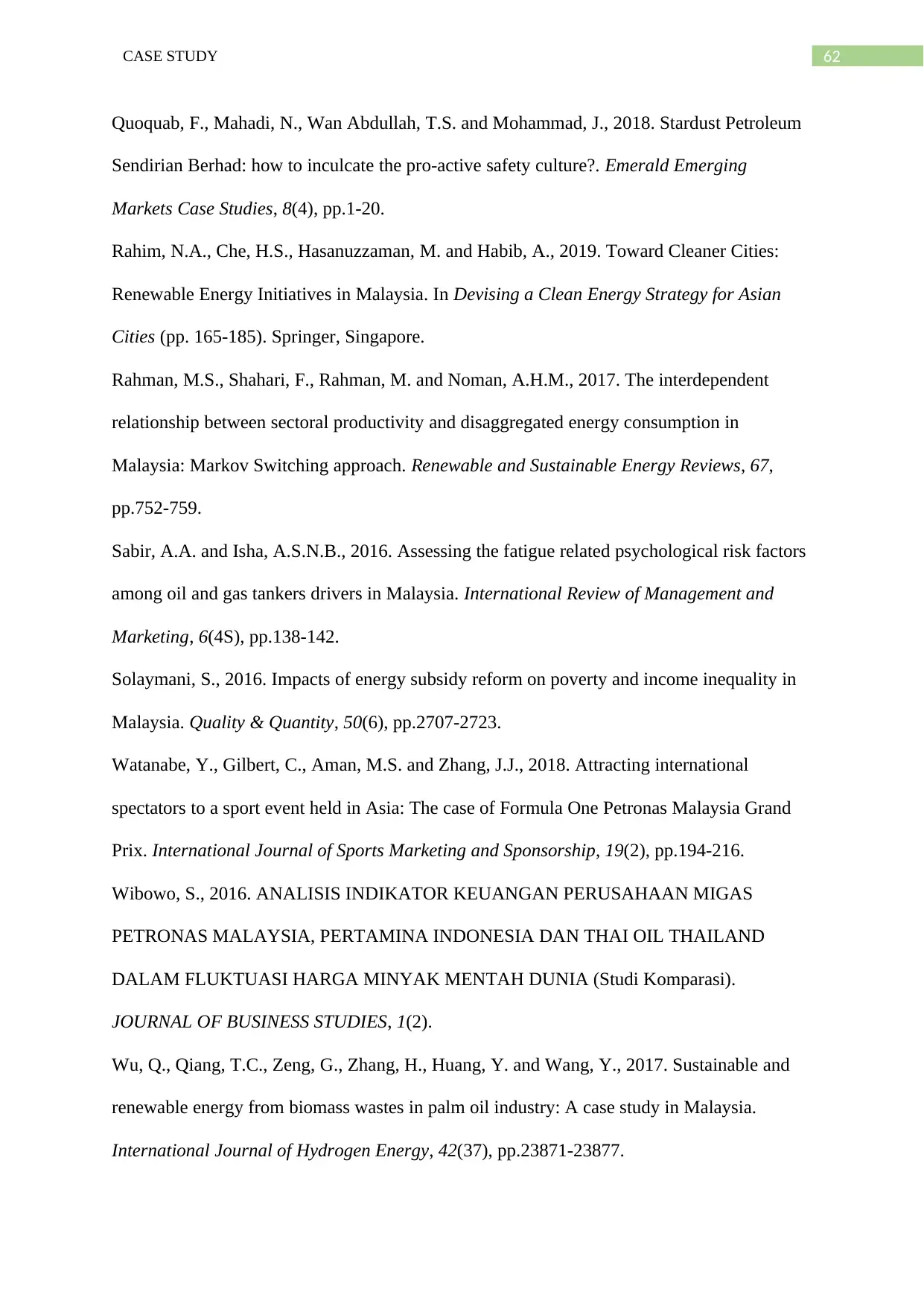
62CASE STUDY
Quoquab, F., Mahadi, N., Wan Abdullah, T.S. and Mohammad, J., 2018. Stardust Petroleum
Sendirian Berhad: how to inculcate the pro-active safety culture?. Emerald Emerging
Markets Case Studies, 8(4), pp.1-20.
Rahim, N.A., Che, H.S., Hasanuzzaman, M. and Habib, A., 2019. Toward Cleaner Cities:
Renewable Energy Initiatives in Malaysia. In Devising a Clean Energy Strategy for Asian
Cities (pp. 165-185). Springer, Singapore.
Rahman, M.S., Shahari, F., Rahman, M. and Noman, A.H.M., 2017. The interdependent
relationship between sectoral productivity and disaggregated energy consumption in
Malaysia: Markov Switching approach. Renewable and Sustainable Energy Reviews, 67,
pp.752-759.
Sabir, A.A. and Isha, A.S.N.B., 2016. Assessing the fatigue related psychological risk factors
among oil and gas tankers drivers in Malaysia. International Review of Management and
Marketing, 6(4S), pp.138-142.
Solaymani, S., 2016. Impacts of energy subsidy reform on poverty and income inequality in
Malaysia. Quality & Quantity, 50(6), pp.2707-2723.
Watanabe, Y., Gilbert, C., Aman, M.S. and Zhang, J.J., 2018. Attracting international
spectators to a sport event held in Asia: The case of Formula One Petronas Malaysia Grand
Prix. International Journal of Sports Marketing and Sponsorship, 19(2), pp.194-216.
Wibowo, S., 2016. ANALISIS INDIKATOR KEUANGAN PERUSAHAAN MIGAS
PETRONAS MALAYSIA, PERTAMINA INDONESIA DAN THAI OIL THAILAND
DALAM FLUKTUASI HARGA MINYAK MENTAH DUNIA (Studi Komparasi).
JOURNAL OF BUSINESS STUDIES, 1(2).
Wu, Q., Qiang, T.C., Zeng, G., Zhang, H., Huang, Y. and Wang, Y., 2017. Sustainable and
renewable energy from biomass wastes in palm oil industry: A case study in Malaysia.
International Journal of Hydrogen Energy, 42(37), pp.23871-23877.
Quoquab, F., Mahadi, N., Wan Abdullah, T.S. and Mohammad, J., 2018. Stardust Petroleum
Sendirian Berhad: how to inculcate the pro-active safety culture?. Emerald Emerging
Markets Case Studies, 8(4), pp.1-20.
Rahim, N.A., Che, H.S., Hasanuzzaman, M. and Habib, A., 2019. Toward Cleaner Cities:
Renewable Energy Initiatives in Malaysia. In Devising a Clean Energy Strategy for Asian
Cities (pp. 165-185). Springer, Singapore.
Rahman, M.S., Shahari, F., Rahman, M. and Noman, A.H.M., 2017. The interdependent
relationship between sectoral productivity and disaggregated energy consumption in
Malaysia: Markov Switching approach. Renewable and Sustainable Energy Reviews, 67,
pp.752-759.
Sabir, A.A. and Isha, A.S.N.B., 2016. Assessing the fatigue related psychological risk factors
among oil and gas tankers drivers in Malaysia. International Review of Management and
Marketing, 6(4S), pp.138-142.
Solaymani, S., 2016. Impacts of energy subsidy reform on poverty and income inequality in
Malaysia. Quality & Quantity, 50(6), pp.2707-2723.
Watanabe, Y., Gilbert, C., Aman, M.S. and Zhang, J.J., 2018. Attracting international
spectators to a sport event held in Asia: The case of Formula One Petronas Malaysia Grand
Prix. International Journal of Sports Marketing and Sponsorship, 19(2), pp.194-216.
Wibowo, S., 2016. ANALISIS INDIKATOR KEUANGAN PERUSAHAAN MIGAS
PETRONAS MALAYSIA, PERTAMINA INDONESIA DAN THAI OIL THAILAND
DALAM FLUKTUASI HARGA MINYAK MENTAH DUNIA (Studi Komparasi).
JOURNAL OF BUSINESS STUDIES, 1(2).
Wu, Q., Qiang, T.C., Zeng, G., Zhang, H., Huang, Y. and Wang, Y., 2017. Sustainable and
renewable energy from biomass wastes in palm oil industry: A case study in Malaysia.
International Journal of Hydrogen Energy, 42(37), pp.23871-23877.
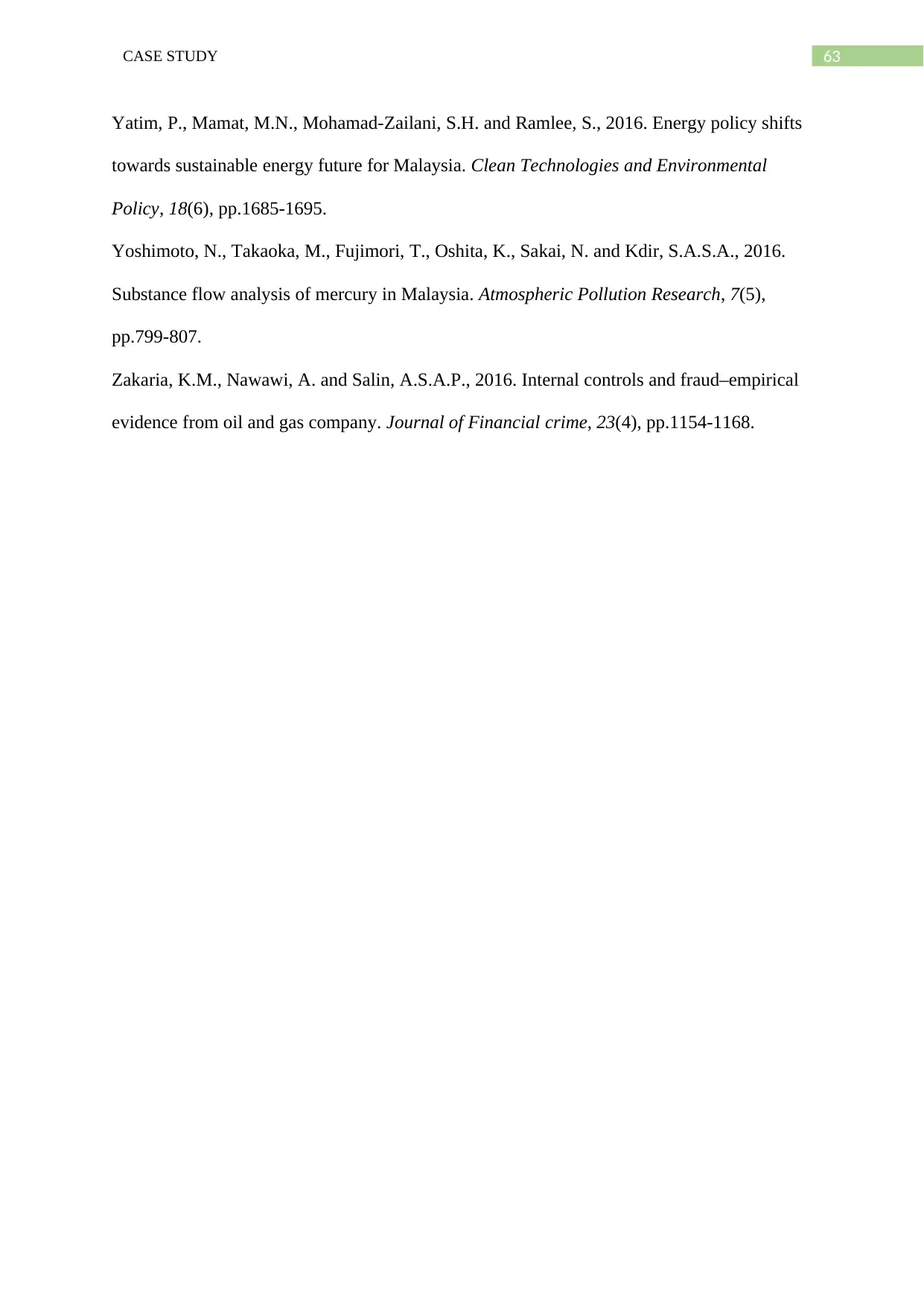
63CASE STUDY
Yatim, P., Mamat, M.N., Mohamad-Zailani, S.H. and Ramlee, S., 2016. Energy policy shifts
towards sustainable energy future for Malaysia. Clean Technologies and Environmental
Policy, 18(6), pp.1685-1695.
Yoshimoto, N., Takaoka, M., Fujimori, T., Oshita, K., Sakai, N. and Kdir, S.A.S.A., 2016.
Substance flow analysis of mercury in Malaysia. Atmospheric Pollution Research, 7(5),
pp.799-807.
Zakaria, K.M., Nawawi, A. and Salin, A.S.A.P., 2016. Internal controls and fraud–empirical
evidence from oil and gas company. Journal of Financial crime, 23(4), pp.1154-1168.
Yatim, P., Mamat, M.N., Mohamad-Zailani, S.H. and Ramlee, S., 2016. Energy policy shifts
towards sustainable energy future for Malaysia. Clean Technologies and Environmental
Policy, 18(6), pp.1685-1695.
Yoshimoto, N., Takaoka, M., Fujimori, T., Oshita, K., Sakai, N. and Kdir, S.A.S.A., 2016.
Substance flow analysis of mercury in Malaysia. Atmospheric Pollution Research, 7(5),
pp.799-807.
Zakaria, K.M., Nawawi, A. and Salin, A.S.A.P., 2016. Internal controls and fraud–empirical
evidence from oil and gas company. Journal of Financial crime, 23(4), pp.1154-1168.
1 out of 63
Related Documents
Your All-in-One AI-Powered Toolkit for Academic Success.
+13062052269
info@desklib.com
Available 24*7 on WhatsApp / Email
![[object Object]](/_next/static/media/star-bottom.7253800d.svg)
Unlock your academic potential
© 2024 | Zucol Services PVT LTD | All rights reserved.





